Budget Report
Including key performance metrics
2023-2024
This report contains certain forward-looking information. In preparing the Budget Report, certain assumptions and estimates were necessary. They are based on information available to management at the time of preparing the budget. Users are cautioned that actual results may vary. Throughout the text in this report, financial values have been rounded to the nearest thousand unless otherwise stated.
Land acknowledgement



Brock University acknowledges the land on which we gather is the traditional territory of the Haudenosaunee and Anishinaabe peoples, many of whom continue to live and work here today. This territory is covered by the Upper Canada Treaties and is within the land protected by the Dish with One Spoon Wampum Agreement. Today, this gathering place is home to many First Nations, Métis and Inuit peoples and acknowledging reminds us that our great standard of living is directly related to the resources and friendship of Indigenous people. brocku.ca/indigenous/

Contents Message from executive team Message from the executive leadership team 1 Our financial health Financial results 2 About Brock Governance at Brock University 3 Board of Trustees 3 Senate 4 Pullout 1 Institutional Strategic Plan ii The big picture (pullout) iv Budget development Process and objectives 9 Framework Budget environment 15 Review Financial update 19 Historical timeline 20 Pullout 2 Space considerations i Historical timeline (pullout) iii Budget details Funding budget 23 Revenue assumptions 23 Operating cost assumptions 34 Snapshots Responsibility budget centre snapshots 40 Teaching Faculties 44 Academic support 50 Student specific 54 Ancillary 60 Shared services 63 Space 70 Global 73 Capital Capital and related projects budget 77 Background 77 Capital and related projects overview 77 Treasury Financing 83 Endowment summary 85 Allocation model Revenue and expense allocation model 86 Appendices Appendix A 88 Appendix B 88 Appendix C 90 Appendix D 92 Appendix E 93 Appendix F 94
Message from the executive leadership team
We are pleased to provide this year’s budget report. Our deepest gratitude goes out to the Brock community, which inspires our students and has generated the tide of optimism that washes through our campus each day. This budget is an investment in the future of Brock, as well as an investment in our University community. The budget was crafted following many months of planning and consultation, and built through the sometimes difficult decisions made by academic and administrative units across our campus. Their diligence in addressing fiscal challenges have thoughtfully balanced economic factors, risk assessments, changing government policies, and enrolment trends to culminate in our investment plan for 2023-24.
Brock began the fiscal year with the honour of hosting the 2022 Canada Summer Games. The first “research games” in its history was a milestone for Brock, the Canada Games, and all post-secondary education. The legacy of the Games extends well beyond the remarkable 205,000 square foot Walker Sports and Abilities Centre that sits on Brock’s campus. The academic, research, athletic and community opportunities we have right here on our campus thanks to the community’s investment in Brock is an example of how grand visions lead to a brighter future.
This budget plan continues the momentum we have built in recent years to enhance our research enterprise through increased funding. Despite fiscal challenges, increased investments in the research enterprise beyond the rate of inflation will enhance Brock’s ability to build research capacity across the University.



Ontario’s universities continue to operate within a challenging fiscal context, which was exacerbated by the Province’s decision to mandate a 10 per cent domestic tuition rate reduction for the 2019-20 academic year and freeze tuition thereafter. We all recognize that Brock’s sustainability is dependant on our capacity to innovate. We are investing in many new growth opportunities within this budget including new academic programs, research, student services and fundraising. This budget supports our core operations and includes enhanced investments in new and growing programs that will serve our students and communities into the future.

The investments highlighted in this document are aligned with Brock’s Institutional Strategic Plan. We encourage each of you to reflect on how your units have supported our students over the recent years and how your units will continue to build on the progress made. Through the investments made in this budget, our students will continue to prosper.
We look forward to being part of the accomplishments of this world-class institution in the year ahead.
2017-18 Budget Report 1 2023-24 Budget Report MESSAGE FROM EXECUTIVE TEAM
Lynn Wells, Provost and Vice-President, Academic
Tim Kenyon, Vice-President, Research
Lesley Rigg, President and Vice-Chancellor
Jennifer Guarasci, Interim Vice-President, Administration
Financial results
The funding budget for fiscal 2023-24 is illustrated in Figure 1. It identifies an in-year mitigation target of $3.99 million, as compared to a mitigation target of $3.00 million in 2022-23. At the time of preparing the budget report, fiscal 2022-23 has not been completed; however, we are projecting through our second trimester reporting (T2) for fiscal 2022-23 a remaining mitigation target of $0.3 million, which we anticipate will be mitigated by year-end. The information below describes our financial health and compares several of our financial health metrics to other comprehensive universities. In addition to the metrics below, Brock's current DBRS Morningstar credit rating is "A (high)" with stable trend. See page 83 for further details of the credit rating.
Statement of operations metrics
The following metrics were developed to identify areas of strength as well as improvement.
(1) Calculated using financial information from 13 comprehensive universities. Certain 2021 metrics have been updated due to revisions in certain universities' financial statements
Brock’s tuition is in line with the average; however, grant revenue per student continues to be well below the sector average and represents an area of ongoing attention for the University. Naturally, Brock operates more efficiently, given the below-average funding, and this results in lower personnel costs per student to counterbalance the lower funding. Brock continues to invest in students through increasing scholarships. Interest and investment income metrics are in line with Brock’s financial health metrics, as detailed below.
Financial health metrics
(1) Certain Brock 2021 metrics have been adjusted due to an update in reporting.
(2) Calculated using financial information from 13 comprehensive universities. Certain 2021 metrics have been updated due to revisions in certain universities' financial statements.
Refer to page 84 for explanations of the debt-related financial health metrics.
By student headcount ($000s) Brock Median(1) Average (1) April 2022 April 2021 April 2022 April 2021 April 2022 April 2021 Student fees (primarily tuition) 9.62 9.46 10.00 9.46 9.89 9.44 Grant 5.92 6.07 10.49 9.67 10.83 10.50 Personnel costs 11.76 11.18 14.27 13.77 14.66 14.01 Scholarships 1.55 1.40 1.62 1.53 1.71 1.63 Interest on long-term debt 0.54 0.53 0.37 0.33 0.33 0.33 Investment income 0.08 0.24 0.34 0.80 0.52 1.00
Figure 2
Figure 3
Brock
(1)
April 2022 April 2021 April 2022 April 2021 April 2022 April 2021 Primary reserve ratio 25.7% 25.6% 26.8% 27.2% 42.3% 44.9% Debt burden ratio 3.5% 3.7% 2.5% 2.6% 2.5% 2.5% Interest burden % 3.2% 3.4% 2.1% 1.5% 1.2% 1.7% Interest coverage 2.98 3.00 3.22 4.48 3.79 5.19 Viability ratio 38.8% 32.9% 88.5% 99.2% 112.6% 130.6% Net operating revenues ratio 2.4% 8.3% 8.8% 11.7% 6.5% 15.2% Employee future benefits per student headcount ($000s) $(1.32) $(1.09) $(1.97) $(1.24) $(2.78) $(2.35) Endowment per student headcount ($000s) $6.10 $6.28 $9.75 $10.37 $9.05 $8.81
Median (2) Weighted average (2)
2 Our financial health 2023-24 Budget Report Figure 1 ($000s) 2023-24 Budget 2022-23 Budget 2021-22 Actual Revenue Student fees 194,728 204,268 188,064 Grant revenue 105,254 99,589 99,780 Internal chargebacks 12,118 11,980 7,346 Inter-fund revenue 12,510 12,127 5,943 Other revenue 65,786 62,176 50,256 Total revenues 390,396 390,140 351,389 Operating costs Personnel costs (254,880) (246,262) (221,304) Inter-fund expense (29,879) (32,705) (28,926) Other operating costs (109,625) (114,176) (97,262) Total operating costs (394,384) (393,143) (347,492) Mitigation target 3,988 3,003 Discretionary appropriations (3,896) Funding surplus - - 1
Governance at Brock University
The University was incorporated in 1964 through The Brock University Act (the Act), a Statute of the Province of Ontario. The University is governed by the Act. The governance, conduct, management and control of the University’s property and the conduct of its business affairs is vested in the Board of Trustees (the Board), while the Senate is responsible for the educational policy of the University. This bicameral system of governance is shown below.
2022-23 Board of Trustees members
• Réjeanne Aimey, Community Trustee
• Mark Arthur, Community Trustee, Chair of the Board
• Anteneh Ayanso, Faculty Trustee
• Greg Berti, Community Trustee
• Don Cyr, Faculty Trustee, Chair of Senate
• Jonathan Davey, Community Trustee
• Mary De Sousa, Community Trustee, Vice-Chair of the Board
• Arti Freeman, Community Trustee
• Yasmine Hejazi, Student Trustee, Co-President and Vice-President, Student Services, Brock University Students’ Union
• Nyarayi Kapisavanhu, Community Trustee
• Kristian Knibutat, Community Trustee
• Brian Lang, Community Trustee
• Kevin Magee, Community Trustee
• Dan Malleck, Faculty Trustee
Board of Trustees
The Board consists of 26 members including 17 community trustees elected by the Board, one graduate and one undergraduate student, three faculty members (including the Chair of Senate), and two staff members elected by their respective constituencies. The Chancellor and the President and Vice-Chancellor are ex officio members of the Board.
• Matthew Melnyk, Staff Trustee
• Anne McCourt, Community Trustee
• Trecia McLennon, Staff Trustee
• Haley Myatt, Student Trustee, President, Brock University Graduate Students’ Association
• Hilary Pearson, Chancellor
• Greg Plata, Community Trustee
• Lesley Rigg, President and Vice-Chancellor
• JoAnna Roberto, Community Trustee
• Christine Sawchuk, Community Trustee
• Stephanie Thompson, Community Trustee
• Robert Welch, Community Trustee
• Debbie Zimmerman, Community Trustee
3
26
Board of Trustees committees
Executive Committee University and Community Experience Committee
Capital Infrastructure Committee
Financial Planning and Investment Committee Pension Committee
Audit Committee Human Resources Committee
Governance/ Nominating Committee
Figure 5
Figure 4: The bicameral system of governance
Senate
Board of Trustees
Standing committees and ad hoc or special committees
2023-24 Budget Report ABOUT BROCK
Standing committees and ad hoc or special committees
Senate
As of the time of preparation of this report, the Senate consists of 72 members, including 38 elected full-time teaching staff and professional librarians, two members of the Board, six undergraduate students and two graduate students elected by their respective constituencies. There are also 24 ex officio members of the Senate.
2022-23 Senate members
Members ex officio
• Hilary Pearson (Chancellor)
• Lesley Rigg (President and Vice-Chancellor)
• Lynn Wells (Provost and Vice-President, Academic)
• Tim Kenyon (Vice-President, Research)
• TBD (Vice President, Administration)
• Brian Power (Vice-Provost and Associate Vice-President, Academic)
• Suzanne Curtin (Vice-Provost, Graduate Students and Dean, Faculty of Graduate Studies)
• Robyn Bourgeois (Vice-Provost, Indigenous Engagement)
• Rajiv Jhangiani, (Vice-Provost, Teaching and Learning)
• Peter Berg (Dean, Faculty of Mathematics and Science)
• Barry Wright (Dean, Goodman School of Business)
• Ingrid Makus (Dean, Faculty of Social Sciences)
• Carol Merriam (Dean, Faculty of Humanities)
• Peter Tiidus (Dean, Faculty of Applied Health Sciences)
• Mary Louise Vanderlee (Dean, Faculty of Education, Interim)
• Geraldine Jones (Registrar and Associate Vice-President, Enrolment Services) (non-voting)
• Mark Robertson (University Librarian)
• Mark Arthur (Chair, Board of Trustees)
• Brad Clarke (Associate Vice-President, Students)
• Andrea LePage (Co-President and Vice-President, Finance and Administration, Brock University Students’ Union)
• Christopher Yendt (Alumni Association Representative)
• Thomas Winger (President, Concordia Seminary)
• Haley Myatt (President, Graduate Students’ Association) (non-voting)
• TBC (Co-Chair, Aboriginal Education Council)
Note:
Faculty of Applied Health Sciences (FAHS); Goodman School of Business (GSB); Faculty of Education (FOE); Faculty of Humanities (FOH); Faculty of Mathematics and Science (FMS); Faculty of Social Sciences (FOSS); and Faculty of Graduate Studies (FGS).
Full-time
teaching staff/professional librarian representatives 38
• Anteneh Ayanso (GSB)
• Michael Bidochka (FMS)
• Irene Blayer (FOH)
• Alison Braley-Rattai (FOSS)
• Jonah Butovsky (FOSS)
• Christine CarpenterCleland (FMS)
• Rosemary Condillac (FOSS)
• Maureen Connolly (FAHS)
• Don Cyr, Chair (GSB)
• Drew Dane (FOSS)
• Sheng Deng (GSB)
• Tim Dun (FOSS)
• Fayez Elayan (GSB)
• Amy Friend (FOH)
• Dawn Good (FOSS)
• Nicholas Hauck (FOH)
• David Hutchison (FOE)
• Nota Klentrou (FAHS)
• Kelli-an Lawrance (FAHS)
• Jingyu Li (GSB)
• Dan Malleck (FAHS)
• Francine McCarthy (FMS)
• Richard Mitchell (FOSS)
• Tim Murphy (FOSS)
• Roberto Nickel (FOH)
• Unyong (Howard) Pyo (GSB)
• Monica Rettig (Library)
• Larry Savage, Vice-Chair (FOSS)
• R. Angus Smith (FOH)
• Kirsty Spence (FAHS)
• Tek Thongpapanl (GSB)
• Dawn Trussell (FAHS)
• Francine Vachon (GSB)
• Terrance Wade (FAHS)
• Michelle Webber (FOSS)
• Shannon Welbourn (FOE)
• Jonathan Younker (Library)
• Dawn Zinga (FOSS)
Representatives of the Board of Trustees
• JoAnna Roberto
• Christine Sawchuk
Undergraduate student representatives
• Emmeline Berger
• Cassandra Carlson
• Carleigh Charlton
2
• Alyan Hassan
• Daniel Krowchuk
• Isabella McLaughlin
Graduate student representatives
• Alex Wilder
• Rakha Zabin
6
2
4
72
2023-24 Budget Report ABOUT BROCK 24
Governance Committee Teaching and Learning Policy Committee Undergraduate Student Affairs Committee Undergraduate Program Committee Planning, Priorities and Budget Advisory Committee Academic Review Committee (special) Two Row Council (special) Information Technology and Infrastructure Committee Research and Scholarship Policy Committee Student Appeals Board Graduate Studies Committee Senate standing and special committees
Figure 6
Planning, Priorities and Budget Advisory Committee
The Senate’s Planning, Priorities and Budget Advisory Committee (PPBAC) defines its terms as follows: It undertakes the responsibility to advise Senate regarding advice to the Board of Trustees in respect to the consistency of the budgets, policies, plans and prioritization processes with academic policy, as well as their consonance with the goals of the University. The PPBAC advises Senate regarding the following:
a) The principles of allocation of the University budget and determination of strategic objectives and prioritization processes.
b) The academic and fiscal priorities of the University.
c) The academic and fiscal challenges of the University.
d) The budget system and strategic planning processes, and any proposed changes in the budget system and strategic planning processes of the University.
e) Matters requiring institutional advocacy.
f) Any other matters referred to it by the Senate or the Senate Governance Committee.
The following are the 2022-23 PPBAC members:
Elected members
• David Hutchison (FOE)
• Nota Klentrou (FAHS)
• Michelle Webber (FOSS)
• Christene Carpenter-Cleland (FMS)
• Kelli-an Lawrance (FAHS)
• Tim Dun (FOSS)
• Rosemary Condillac (FOSS)
Students
• Emmeline Berger – Undergraduate student
• Haley Myatt – Graduate Senator
Ex officio
• Don Cyr (GSB) – Senate Chair
• Lynn Wells – Provost and VP, Academic

• Peter Tiidus (FAHS) – Faculty Dean
• Ingrid Makus (FOSS) – Faculty Dean

• Michelle McGinn – Associate VP, Research
• Barbara Sainty – BUFA Observer (non-voting)
2 7 6 15 Pullout 1i
Institutional Strategic Plan
Illuminating Brock’s path forward is our Brock University Institutional Strategic Plan for 20182025, entitled “Niagara Roots – Global Reach,” referred to throughout the text of this document as the “Institutional Strategic Plan.” It was developed through a broad-based, full-year consultation process and has been approved by the Board of Trustees and Senate. The document sets out the vision, mission, guiding values and strategic priorities to support planning and decision-making until 2025. The entire Plan, including the Guiding Values, can be viewed at brocku.ca/vp-academic/ wp-content/uploads/sites/65/Brock-UniversityStrategic-Plan.pdf
Vision
Brock University is a dynamic, comprehensive university that makes a positive difference in the lives of individuals in our Brock community, the Niagara region, Canada and the world through leadership, innovation and excellence in learning, teaching, research, scholarship and creativity across disciplines.
Mission
Brock flourishes through the scholarly, creative and professional achievements of our students, faculty and staff. Although we share a common purpose, we recognize and honour knowledge pursued through diverse perspectives and approaches. Our academic mission is to nurture and support our students and faculty in the discovery of knowledge through exemplary scholarship, teaching and service.
We provide undergraduate, graduate and professional education of the highest quality. Our graduate programs enhance Brock’s growing reputation for excellence in teaching, research, creativity and innovation. We provide a transformative experience for our students inside and outside the classroom by helping to develop their full potential as educated and engaged citizens in local and global communities. Brock graduates go out into the world as leaders, with a track record of entering fulfilling careers across all disciplines.
Brock University works to enhance the economic, social, cultural and intellectual lives of the communities around us – Niagara, Ontario, Canada and globally – and to demonstrate the vital ways in which we contribute to the well-being and betterment of society in the 21st century.
Strategic priorities
The Institutional Strategic Plan establishes four strategic priorities, along with associated goals and action items, to advance Brock’s vision over the next seven years. These priorities focus the University community on fulfilling and strengthening our mission as an engaged and comprehensive university through:
Strategic priority: Offer a transformational and accessible academic and university experience
To be a destination of choice for undergraduate, graduate and part-time students, we must ensure an academic and university experience that positively transforms our students’ abilities, understanding and impact on the world. We teach future-ready students and equip lifelong learners with a zest for knowledge, skills and competencies that will enable them to achieve their full academic, professional, career and life potential. Core to our student experience is the development of engaged citizens who are resilient, involved, career-ready and versatile.
Strategic priority: Build research capacity across the University
Our research focus is central to our identity. Brock will invest in building a world-leading research institution that is grounded in scholarly excellence and strong graduate and post-graduate programs. We will leverage our strengths within and across disciplines to enhance research impact.
Strategic priority: Enhance the life and vitality of our local region and beyond
Brock is committed to working with the communities in Niagara, Ontario, Canada and the world. Through local and global connections, we increase opportunities for the residents of Niagara. By responding to the needs of society and supporting its growth and development, we strengthen community vitality and vibrancy.
Strategic priority: Foster a culture of inclusivity, accessibility, reconciliation and decolonization
At Brock, we believe that a diverse and welcoming learning community is built upon the foundation of exceptional students, faculty, staff and alumni. This requires that Brock be attractive and welcoming to people of all identities, and accepting of the unique histories and experiences of Indigenous people within the Canadian state.
Pullout 1ii
Our strategic priorities set the University on the path towards greater national and global recognition for its engagement and relevance to students and communities through enhanced innovation and excellence in teaching, learning, discovery, creativity and the application of knowledge across disciplines.
GUIDING VALUES AND STRATEGIC PRIORITIES(1)
Strategic Focus and Priorities
O er a transformational and accessible academic and university experience
Innovation and transdisciplinarity
Build research capacity across the University
Integrity and respect
Enhance the life and vitality of our local region and beyond
Foster a culture of inclusivity, accessibility, reconciliation and decolonization
Unique student experience
Freedom of thought and expression coupled with academic responsibility
The generation and mobilization of knowledge
Inclusivity, diversity, equity
Reconciliation and decolonization
Sustainable, accountable stewardship
Pullout 1iii
Guiding V alues
(1) The colours in the graphic include Brock’s brand standards and those from the Indigenous Medicine Wheel, the Pride Flag and the Dish with One Spoon Wampum Agreement Flag.
Figure 30
Introducing the data points
As part of the budget report, we provide data points to assist users of this report to draw relationships between financial and nonfinancial data. The goal is to continue the process of providing meaningful data points to help establish a foundation to explain the “why” behind the revenue and expense values and the outcomes the budget supports. The data points presented in this report were chosen in consultation with Institutional Planning, Analysis and Performance (IPAP), with an emphasis on points which have a financial impact. The data points were made available from IPAP as well as other units throughout the University. Your suggestions for future budget reports and key data points are always welcome at budgetreport@brocku.ca
The second pullout after page 20 presents a timeline that includes some major events impacting our financial experience since 2003-2004, closely aligned with when the move to a comprehensive university was proposed and endorsed.
We hope that you find these data points useful and that they encourage constructive and collegial discussion.
Figure 8






94% of Brock undergraduate students were employed within six months of graduation.
Source: 2021 Ontario University Graduate Survey.
of Brock
Source: 2021 Ontario University Graduate Survey.
Brock was ranked #5 of 15 among Canadian comprehensive Universities for Library acquisitions
Source: Maclean’s 2023 University Rankings.
Brock
was
ranked
#6 of 15 among Canadian comprehensive Universities for faculty awards and for Scholarships and bursaries



Faculty of Applied Health Sciences (FAHS) Goodman School of Business (GSB) Faculty of Education (FOE) Faculty of Humanities (FOH) Faculty of Mathematics and Science (FMS) Faculty of Social Sciences (FOSS)
Figures represent the number of students in each Faculty of Major on Nov. 1 of each Academic Year (as per PFIS-USER submissions). In addition, figures also include new-entry enrolments as of Feb. 1 for certain International Student Programs (ISPs) and Technological Education.
Note: the table above also includes ‘No Faculty’ (i.e. auditing and non-degree) enrolment.
Full-time equivalent (FTE) student.
FTEs are reported based on a student’s home Faculty, weighted based on each individual’s course registrations, according to course weights. Undergraduate FTEs represent all semesters, as of each ministry reporting date and in accordance with ministry reporting guidelines; graduate FTEs represent Fall and Summer semesters (in accordance with ministry reporting guidelines) as well as Winter MAcc registrations.
Figure 13: Student headcount by Faculty of major
Figure 14: Student full-time equivalent by Faculty of major
15 185 83 6132 421 Total graduate students 65 423 22 478 Total undergraduate students 1,797 2020-21 2021-22 2022-23 Undergraduate (FT) 15,324 15,220 15,295 Undergraduate (PT) 2,448 2,433 2,103 Graduate (FT) 1,637 1,617 1,558 Graduate (PT) 314 243 233 Total 19,723 19,513 19,189
Mathematics
Social
22-23 21-22 20-21 19-20 18-19 22-23 21-22 20-21 19-20 18-19 22-23 21-22 20-21 19-20 18-19 22-23 21-22 20-21 19-20 18-19 22-23 21-22 22-23 21-22 20-21 19-20 18-19 4,005 4,057 4,285 4,324 4,286 3,408 3,744 3,839 3,704 3,618 1,504 1,627 1,767 1,863 1,804 2,275 2,284 1,555 1,724 1,748 1,777 4,964 5,067 5,301 5,240 5,008 Year 2018-19 2020-21 2021-22 2022-23 Undergraduate 16,409 17,407 17,237 17,003 Graduate 1,724 1,697 1,636 Total 18,023 19,131 18,934 18,639 Note: the table above also includes ‘No Faculty’ (i.e. auditing and non-degree) enrolment. Student headcount full time (FT) and part time (PT). Applied Health Sciences EducationHumanities Mathematics and Science Social Sciences Goodman School of Business 22-23 21-22 20-21 19-20 18-19 22-23 21-22 20-21 19-20 18-19 22-23 21-22 20-21 19-20 18-19 22-2 21-22 20-21 19-20 18-19 22-23 21-22 22-23 21-22 20-2 19-20 18-19 4,429 4,382 4,121 4,168 4,41 2 3,173 3,576 3,593 3,415 3,368 1,792 1,728 1,772 1,920 1,895 2,420 2,420 2,230 2,474 2,449 1,914 1,968 1,724 1,879 1,885 5,362 5,348 5,625 5,827 5,543 Year Domestic (Ontario) International Domestic (Outside Ontario) Europe North America (Exc uding Canada) South America International China Africa Asia (Excluding India and China) India 89.3 9.0 2.6 1.9 1.4 1.7 .5.6.5 1.7 .2 62.0 34.6 14.8 8.0 6.4 2.6 1 .9 .8 3.3 Domestic (Ontario) International Domestic (Outside Ontario) International India Asia (Exc uding India and China) China Africa North America (Excluding Canada) Europe South America
Applied Health Sciences Education Humanities
and Science
Sciences Goodman School of Business
Figure 10: Fall 2022 undergraduate students by permanent country of residence (%)
Figure 11: Fall 2022 graduate students by permanent country of residence (%)
Figure 12: 2022 international student headcount by Faculty
The big picture
96%
undergraduate students were employed within 24 months of graduation.
Source: Maclean’s 2023 University Rankings.
17,838 8,922 13,278 9,078 24,777 5,745 4,567 29 879 25,420 19,578 8,533 12,960 9,098 27,829 5,446 4,703 32,705 26,029 Total 146,881 Total 139,504 Other operating costs Inter-fund expense Cost of sales Library acquisitions Scholarships and fellowships Financial expenditures Utilities and taxes Purchased services 2022-23 Budget Other operating costs Inter-fund expense Cost of sales Library acquisitions Scholarships and fellowships Financial expenditures Utilities and taxes Purchased services Repair and maintenance & capital replacement Repair and maintenance & capital replacement 2023-24 Budget 13% 6% 10% 18% 7% 6% 4% 3% 18% 13% 21% 9% 6% 19% 4% 3% 22% 18%
Figure 7: Budgeted operating costs ($000s)
Personnel group (1) ($000s) 2023-24 Budget 2022-23 Budget 2021-22 Actual Salary/ Wage Benefits Total personnel costs Salary/ Wage Benefits Total personnel costs Total personnel costs Faculty and Professional Librarians 98,452 20,783 119,235 96,781 21,515 118,296 109,365 Admin/Professional 56,024 14,882 70,906 52,155 14,083 66,238 56,092 OSSTF 7,610 2,330 9,940 7,858 2,473 10,331 9,216 CUPE 1295 FT 7,414 2,463 9,877 7,154 2,474 9,628 8,506 SAC 7,572 1,477 9,049 6,693 1,438 8,131 6,852 Other ongoing personnel 923 262 1,185 779 218 997 896 Total ongoing personnel 177,995 42,197 220,192 171,420 42,201 213,621 190,927 CUPE 4207 – Unit 1 15,120 1,707 16,827 15,200 1,733 16,933 16,564 Other temporary personnel 16,573 1,288 17,861 14,628 1,080 15,708 13,813 Total temporary personnel 31,693 2,995 34,688 29,828 2,813 32,641 30,377 Total personnel 209,688 45,192 254,880 201,248 45,014 246,262 221,304 1) Faculty and Professional Librarians – BUFA members, Associate Deans, Associate Vice-Presidents of Research and Associate Librarian; Admin/ Professional – ongoing administrative/professional and exempt staff; OSSTF – support and technical staff; CUPE 1295 FT – full-time maintenance, trades and custodial staff; SAC – Senior Administrative Council; Other ongoing – CUPE 4207-2, CUPE 4207-3 and IATSE; CUPE 4207 – Unit 1 –instructors, teaching assistants, lab demonstrators, course co-ordinators and marker/graders; Other temporary – all other part-time teaching and non-teaching positions, Faculty overloads and stipend transfers. Pullout 1iv Pullout 1v
Figure 9
Figure 15: Self-identified Indigenous applicants and registrants
ApplicantsRegistrants
2019-20251 69





2020-21214 52
2021-22218 67
2022-23 241 63
Source: Power BI Admissions on March 6, 2023.
Figure 18: 2022-23 undergraduate programs average entering grade (%)
Figure 16: Full-course equivalents (FCE) 85 15
Figure 16: Full-course equivalents (FCE) offered in 2022-23 (%)
Figure 17: Students who received OSAP in 2022-23 (%)
YES: 46 NO: 54
Spring/ Summer Fall/Winter
Figure 19: 2022-23 undergraduate programs entering average grade by Faculty (%)
Figure 20: Brock mean entering average of new students directly from secondary school (%)
class size by year (Full-course equivalent)
Source: Class statistics, as used in the FCE Report.
Figures are based on 2022-23 Fall/Winter enrolment.
Source:
Overall average
*Represents Teacher Education only. Source: Consortium for Student Retention Data Exchange (CSRDE).
Figures represent the tracking of first-time, full-time bachelor’s degree-seeking students. The figures represent the percentage of first-year students returning the following November, regardless of year of study. The year shown represents the cohort year (year of entry).
Figure 22 : Retention rates
Overall average class size. Applied Health Sciences Education Goodman School of Business 4321 4321 Mathematics and Science 4321 Social Sciences 4321 4321 Humanities 4321 93 61 62 52 224 30 21 228 97 24 53 54 27 22 13 34 68 149 38 40 49 46 48 70 76 50 47 34 86 72 60 61 59 64 64 2022-23 2021-22 2020-21 2019-20 2018-19
Average
S tudents directl y from secondary school <75 75-84 84.1-89 89.1-95 >95 33 8 27 26 6 Source: AppDetails BrockDB (students who applied to Brock for more than one program are only included once). Source: AppDetails Brock DB Figure21 : Undergraduate average class size by Year FOSS FMS FOH GSB FAHS 86.0 84.5 84.2 85.4 86.7 Within Faculty, same department (%) Within Faculty, di erent department (%) Outside of Faculty (%) Applied Health Sciences Year Education* Goodman School of Business Mathematics and Science Social Sciences Humanities 212019181721201918172120191817212019181721201918172120191817 74.9 5.5 12.1 1.9 1.2 0.6 1.7 1.1 7.2 8.0 10.6 5.9 13.5 15.8 8.4 72.9 82.7 83.5 75.6 7.7 7.8 15.8 18.2 12.5 74.4 65.5 60.9 67.9 74.3 79.1 70.2 65.1 74.2 81.1 15.4 4.2 3.9 77.8 65.9 57.2 66.3 72.0 6.9 9.5 8.2 8.2 8.0 2.0 2.5 2.6 2.8 2.1 60.3 59.1 73.5 72.3 76.6 4.0 3.8 97.9 95.9 96.796.7 97.3 90.1 89.0 92.8 90.3 89.3 87.9 89.5 89.4 89.7 89.0 96.7 96.8 96.7 97.9 95.9 91.7 88.8 89.8 89.2 85.9 87.2 88.5 88.6 85.3 85.6 85.0 83.4 84.8 82.5 80.8 8.6 5.9 4.2 19.8 7.8 6.6 12.7 14.5 20.1 10.0 19.6 18.9 7.8 6.5 5.4 2.6
AppDetails Brock DB 2022 2021 2020 2019 2018 81.8 84.3 85.9 85.2 81.8
Campus Store revenue ($000s) Sales per student headcount ($) 2023-24 Budget 2022-23 Budget 2021-22 2020-21 2019-20 419 6,615 6,500 7,665 5,597 6,223 387 284 319 329 338 Parking Services revenue ($000s) Number of permits issued 2023-24 Budget 2022-23 Budget 2021-22 2020-21 2019-20 3,729 4,655 3,776 3,390 295 5,210 875 5,853 4,352 4,848 Residence revenue ($000s) Occupancy (%) 2023-24 Budget 2022-23 Budget 2021-22 2020-21 2019-20 24,158 18,557 25,344 9.83 98.32 3,708 19,440 95.5 80.11 94.4 Cash donations (includes stock and property) Endowment donations 2021-22 2020-21 2019-20 2018-19 1,863 1,279 1,394 3,003 1,553 538 2,942 2,495 2021-22 2017-18 2018-19 2019-20 2020-21 Other Units (VPR ORS & FGS)* Social Sciences Mathematics and Science Humanities Education Goodman School of Business Applied Health Sciences 245 289 181 3,361 2,3922,179 2,5371,738 177 118 450 414 299 219 18 217 562 1,167 268 4,4663,812 3,3964,251 3,829 3,4083,6082,6862,5003,217 8,472 6,956 3,259 5,0595,293 240 2021-22 2020-21 2019-20 2018-19 2017-18 16,728 16,173 14,697 18,348 3,248 4,630 8,850 15,337 609 6,994 7,734 2,087 5,459 8,627 2,948 3,081 8,668 9,170 6,907 2,271 Tri-council* Other grants Contracts * CIHR, SSHRC, NSERC, CRCs 2022-23 2021-22 2020-21 2019-20 2018-19 2017-18 9 9 33 31 9 9 9 9 31 3232 31 Undergraduate co-op programs Graduate co-op programs Total co-op student enrolment 2,293 2,452 2,591 2,290 2,657 2,922
2023-24 Campus Store revenue
Figure 23: 2019-20 to 2023-24 Parking Services revenue Figure 24: 2019-20 to
to 2022-23
programs and enrolment
to 2021-22 external research grants – cash received ($000s) (1)
Figure 27: 2017-18
co-op
Figure 28: 2017-18
2023-24
Figure
29: 2017-18 to 2021-22 external research grants by Faculty – cash received ($000s) (1) Figure 25: 2019-20 to
Residence revenue
Provided by Ancillary Services. (1) Certain 2019 figures have been restated. Provided by the Office of Research Services. Grants are presented on a cash basis. * Includes external research grants in the office of the Vice-President, Research, Office of Research Services and Faculty of Graduate Studies, including Research Support Funds and externally-funded scholarships for graduate students.
Provided by Ancillary Services. Provided by Co-op, Career and Experiential Education. Pullout 1vi Pullout 1/vii
Figure 26: 2018-19 to 2021-22 donations ($000s)
Figures provided by Financial Services. Amounts will differ from the Financial Statements, as these numbers represent cash collected, not revenue recognized.

Pullout 1viii
Process and objectives
Overview
The budget is a plan to allocate resources in advance for the maximum benefit of interested parties and to support the Institutional Strategic Plan. It is a method to authorize spending and establish revenue targets of units within Brock University.
The 2023-24 budget process was one of consultation and multiple meetings with the Senior Administrative Council; the Strategic Academic Leadership Team; the Senate Planning, Priorities and Budget Advisory Committee; in addition to numerous unit-specific meetings. Every effort was made to ensure the budget is consistent with the academic policy of the University, and that it supports the Institutional Strategic Plan and the Strategic Mandate Agreement 2020-25 (SMA3).
The timeline for the budget process allows the budget to be completed for approval at the cycle 4 meeting of the Board of Trustees in May to coincide with the start of our fiscal year – running from May 1 to April 30. We thank all units for meeting the requirements of the budget timeline.
This budget was developed under the direction of the May 7, 2015 Board of Trustees two-part motion: “That the President be given a mandate to:
1. Ensure the University funding budget for 2015-16 and all subsequent years are prepared and presented as balanced. If a balanced funding budget cannot be achieved when presented to the Board of Trustees for approval, the deficit can be presented as a mitigation target provided a plan to achieve the mitigation target is included.

2. Manage the affairs of the University in order for it to achieve, or do better than, the funding budget.”
As an initial part of the budget process, guidance is prepared by considering all known commitments in the upcoming year, including personnel rate increases, debt payment commitments and investments set out in the Fiscal Framework. For 2023-24, this resulted in $18.8 million of savings to be found as the budget was developed. This overall target was split between a $9.3-million or four per cent target for each unit in the University to find during the budget development process and a $9.5-million mitigation target to be found centrally. Following a challenging budget year in 2022-23, each unit throughout the University once again analyzed their budgets to identify savings, while carefully considering the impact on student experience.
We thank all units who worked diligently and prepared their budgets to bring the overall 2023-24 budget together. Following all the consultations, our people brought the budget to within one per cent of being balanced with an in-year mitigation target of $3.99 million for 2023-24.
The budget also includes $3.7 million in revenue estimates that are related to special requests of the Province which are still pending. Should these items not be approved the mitigation target will increase.
While in-year mitigation targets are established in the budget, these efforts do not overshadow the long-term growth and development of the University. Certain areas will require investment for the University to achieve our strategic goals. The following sections provide additional information in areas of new and ongoing investment as established in the 2023-24 operating budget.
9
2023-24 Budget Report BUDGET DEVELOPMENT
New and ongoing investments
The Institutional Strategic Plan specifically identifies focusing and strengthening engagement and trust with Indigenous communities and partners. The 2023-24 budget supports this initiative in a number of meaningful ways that are highlighted below:
Indigenous support

• Continued support for the Vice-Provost, Indigenous Engagement
• Continued support for the Hadiyaˀdagénhahs
First Nations, Métis and Inuit Student Centre and Undergraduate Aboriginal Studies
• Targeting scholarship support for Indigenous students, both undergraduate and graduate
• Faculties supporting growth in Indigenous content in curricula

• Faculties continue to diversify their faculty complement by appointing Indigenous faculty members
• As set out in the 2022-23 Fiscal Framework, one of the key priorities of the strategic/discretionary funds established in this budget will be reconciliation and decolonization
Core to the Institutional Strategic Plan is academics and teaching. The 2023-24 operating budget is in support of this as can be seen by the investments in the Teaching Faculties highlighted below:
Teaching Faculties
• Total operating and personnel cost budget: $168.4 million, which is 43 per cent of the total University operating and personnel costs budget
• FTE(2): 848.6
• Faculty of Applied Health Sciences continues to maintain support for all undergraduate and graduate programs as well as accommodate significant growth in the Nursing programs.
• The Goodman School of Business is a leader in work integrated learning; empowering students to reach their full potential by putting into practice what they learn in the classroom into the business world through co-op and experiential education opportunities.
• Faculty of Education is strengthening community networks for experiential and work-integrated learning opportunities, while enhancing program and student supports which will maintain the Faculty's reputation of graduating highly regarded educators and researchers.
• The Faculty of Humanities continues to diversify its faculty complement and curriculum, and in 2023 are appointing three Indigenous faculty members.
• The Faculty of Social Sciences continues to prioritize supporting students, delivering and developing highquality programs and providing strategic funds for research activity.
• The Faculty of Mathematics and Science continues to grow its research profile while it also dedicates resources to the launching of new programs in data sciences and analytics and in engineering.
brocku.ca/academics
(1) Net direct operating budget equals revenue minus expenses for 2023-24 fiscal year. These budgets do not allocate overhead costs (i.e. support services, space, etc.).
(2) FTE represents 2023-24 evaluated salaried staff and faculty full-time equivalent positions and ongoing CUPE 1295 positions (both filled and unfilled).
10
2023-24 Budget Report BUDGET DEVELOPMENT
The strategic priority to “Build research capacity across the University,” as identified in the Institutional Strategic Plan, is supported as part of the 2023-24 budget. The section below details investments to support research activity.
Research support
• The 2022-23 Fiscal Framework established targeted guidance to build the research capacity across the University by ensuring the operating budget for the central research enterprise and Faculty-based research services grow each year by at least the rate of inflation with additional structural adjustments.
• Total net direct operating budget(1) of the central Research Enterprise and the Office of the Vice-President, Research (VPR): $4.5 million, representing an increase of $0.8 million over the 2022-23 budget
• Highlights of some investments in the 2023-24 budget include:
– Grant funding for various items including VPR Research Excellence for Research Initiative Awards, application support, equipment support, Indigenous research, and matching funds. As well as Chancellor's Chair and Match of Minds grants.
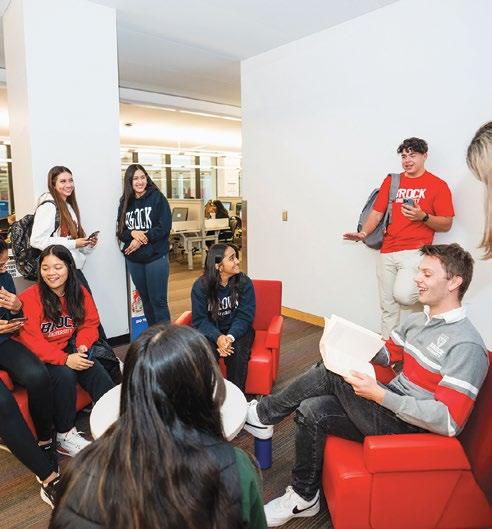
– Funding for post-doctoral fellowship awards and distinguished/early career research awards.

– Funding the Cool Climate Oenology and Viticulture Institute
brocku.ca/research-at-brock
We know the Library is important to both teaching and research, and for this reason, in order to ensure Brock’s Library remains competitive with our peers, the Fiscal Framework establishes a goal of benchmarking our acquisitions on a per-student basis against our peers in the Canadian Association of Research Libraries (CARL).
Library acquisitions
• Net direct operating budget(1): $5.7 million
• Strategic Investment: $0.4 million
• Where is this budgeted: Library brocku.ca/library
(1) Net direct operating budget equals revenue minus expenses for 2023-24 fiscal year. These budgets do not allocate overhead costs (i.e. support services, space, etc.).
(2) FTE represents 2023-24 evaluated salaried staff and faculty full-time equivalent positions and ongoing CUPE 1295 positions (both filled and unfilled).
11
2023-24 Budget Report BUDGET DEVELOPMENT
Another of the strategic priorities detailed in the Institutional Strategic Plan is to “Offer a transformational and accessible academic and university experience.” The 2023-24 operating budget supports this priority through its development of Professional and Continuing Studies and Engineering.
Professional and Continuing Studies
• PCS provides a range of continuing and professional programs with flexible learning opportunities to meet the needs and advance the careers of a wide audience of learners, including current students, graduates, working professionals and retirees. PCS includes many of Brock's non-credit offerings, including non-credit microcredentials, as well as English as a Subsequent Language (ESL) opportunities.
• Operating and personnel cost budget: $1.7 million, this investment is being fully funded by strategic funds in 2023-24.
• FTE(2): 6.7
• Where this is budgeted: Professional and Continuing Studies and ESL responsibility centre. brocku.ca/continuing-education
Engineering
• The Yousef Haj-Ahmad Department of Engineering is one of only three in Canada to offer Integrated Engineering, an innovative approach to engineering education tailor-made to address emerging needs and challenges in the field. Brock's unique, made-in-Niagara interdisciplinary program blurs the lines between traditional engineering disciplines, helping the engineers of tomorrow lead in fields as diverse as big data, artificial intelligence, bioengineering, medical devices, sustainability and climate change, robot automation, manufacturing and transportation.
• Operating and personnel cost budget: $1.6 million, this investment is being fully funded by strategic funds in 2023-24.
• FTE(2): 8.8
• Where this is budgeted: Faculty of Mathematics and Science
brocku.ca/mathematics-science/engineering
The newly opened Canada Games Park, which sits on Brock land, contributes to the strategic priority to “Offer a transformational and accessible academic and university experience”. Part of this priority is to provide an engaging campus experience that meets students’ needs and affords social, cultural and recreational opportunities for all students. Canada Games Park houses the Walker Sports and Abilities Centre, including a health and well-being centre, arenas, gymnasiums and an outdoor facility with a track, athletic field and beach volleyball courts, of which Brock University is a 1/4 owner and 1/3 operator.

Canada Games Park
• Net direct operating budget(1): $0.8 million (Note: this budget does not include the arena and gym leasing costs budgeted in Brock Sports and Recreation)
• Where is this budgeted: Campus Development and Community Agreements brocku.ca/community-engagement/communityresources/walker-sports-and-abilities-centre
12 2023-24 Budget Report BUDGET DEVELOPMENT
(1)
(2)
Net direct operating budget equals revenue minus expenses for 2023-24 fiscal year. These budgets do not allocate overhead costs (i.e. support services, space, etc.).
FTE represents 2023-24 evaluated salaried staff and faculty full-time equivalent positions and ongoing CUPE 1295 positions (both filled and unfilled).
Another way of supporting the strategic priorities within the Institutional Strategic Plan is with new hires in key strategic areas. New positions included in the 2023-24 budget support the strategic priorities to “Offer a transformational and accessible academic and university experience” and to “Foster a culture of inclusivity, accessibility, reconciliation and decolonization”.
Strategic hiring
• New strategic positions: Vice-President, Advancement and External Relations; Associate Vice-President, Equity, Diversity and Inclusion
• Where is this budgeted: Senior Academic and Administrative Team and Human Rights and Equity Services
Scholarships, bursaries and fellowships support the Institutional Strategic Plan by helping Brock become a destination of choice for students and making it possible for more to attend the University.

Scholarships, bursaries and fellowships
• Undergraduate: $17.0 million

• Graduate: $10.5 million
• Funding sources: $24.8 million (90%) operating budget and $2.7 million (10%) endowment.
brocku.ca/international/future/tuition-awards/ brocku.ca/safa/awards
brocku.ca/graduate-studies/fgs-awards
Continue to enhance accountability, understandability and transparency of the budget
To everyone involved in the budget development, thank you for making this budget possible. Furthermore, this year’s report continues the linkage of financial and non-financial data through a strong partnership with Financial Services and Institutional Planning, Analysis and Performance. We suspect this information will generate discussion, which is encouraged. It is anticipated that future budget reports will continue to build and add to the financial and non-financial data disclosed herein. Discussing both financial and non-financial data together will help support ongoing efforts to ensure a fiscally responsible budget while paying close attention to quality and academic outcomes. It is hoped that the efforts made throughout the development of this budget have enhanced accountability, understandability and transparency. Feedback is always encouraged and welcomed, and can be directed to budgetreport@brocku.ca
13 2023-24 Budget Report BUDGET DEVELOPMENT

14 2023-24 Budget Report FRAMEWORK
Budget environment
After a challenging two years of the evolving COVID-19 global pandemic, Brock remains flexible to respond to the needs of our community while advancing our strategic priorities. Brock has navigated the global pandemic in a fiscally responsible manner through the selfless dedication of our faculty and support personnel who continued to adapt our academic and research programs through changing public health measures. The development of the 2023-24 budget brought with it a sense of excitement as the campus was again energetic with enthusiastic students supported by in-person academic, research and ancillary activities. The current budget environment is informed by our fiscal framework, enrolment and government policy. Developing the 2023-24 budget demanded attention to detail to address the significant fiscal pressures that remain as a result of the lingering effects of the global pandemic. As a not-for-profit organization, each year our goal is to achieve a balanced budget. Recognizing costs are subject to inflation, our ability to offset these costs with additional revenue is not possible within the confines of current government policy; thus, each year we endeavour to find additional savings or diversify revenues to achieve a balanced budget. Demands on the University impose costs that will always exceed its available resources. Brock University must therefore have some means both of setting priorities among its many possible opportunities, and of planning to enable the strategies it undertakes. As we have done in past years, consultation with the University community has informed budget development. Integrating the feedback received on the budget within our fiscal parameters and guided by the Institutional Strategic Plan, this budget plan provides support for the academic policy of the University in progressive ways. This document outlines the many investments in our students, research,
community and future sustainability. This discussion on the budget environment serves to highlight areas that significantly impact the budget development.
Fiscal Framework
The Fiscal Framework update (the Framework) aligns our budget planning strategy with the Institutional Strategic Plan, entitled “Brock University: Niagara Roots – Global Reach.” The Fiscal Framework underwent an update last year with new fiscal guidance weaved into Brock’s budget planning guidance to support areas of strategic growth such as research, and as well provide support for our core academic and student support programs. At the core of Brock’s financial challenge, and in fact the entire Ontario post secondary sector, is the reality that under the current government’s regulations more than half of the University’s revenue is subject to zero per cent inflation. Regulated tuition and grants represent over 50 per cent of the University’s revenue, both fixed at zero per cent inflation. The remaining revenue sourced from ancillary revenues and international student tuition may increase; however, funding inflation on all of Brock's expenses would require more than double the rate of inflation applied to international tuition and ancillary services. This is certainly not a sustainable pricing strategy. Based on longer term inflation targets and without enrolment growth, total revenue is projected to increase at 1.5 per cent. With expenses growing at 2.4 per cent annually, and with 65 per cent of expenses associated with personnel costs, most of which is tied to collective agreements, the University is faced with a budget model that must rely on increasing enrolment revenue to fund base operating expenses. This framework is highlighted in Figure 31.
15
28 19 27 26 Regulated tuition Non-regulated tuition Grant revenue Other revenue Total revenue (%) Weighted average annual revenue growth (%) Total revenue (%) Weighted average annual revenue growth (%) Total revenue growth = 1.5% Total operating costs growth = 2.4% Revenue growth 0% increase 5% increase 0% increase 2% increase 0.0 1.0 0.0 0.5 35 65 0.6 1.8 Operating cost Personnel costs Operating costs growth $5.9 million Annual impact Structural de cit ($3.5) million 0.9% loss ($9.4) million 1.7% increase 2.8% increase
2023-24 Budget Report FRAMEWORK
Figure 31: Budget Framework
In the short-term, this model is under even greater pressure with inflation on expenses exceeding the long-term target rate of two per cent. In fact, Ontario’s inflation rate in 2022 reached seven per cent. Strategic enrolment growth is a key ingredient of our Framework to generate additional revenues to offset the inflationary pressures on expenses. The Framework also aligned funding allocations with strategic priorities to ensure investments were protected in student financial aid, capital renewal, our people, strategic initiatives such as Engineering, Professional and Continuing Studies and the Research Enterprise.
Enrolment
Enrolment generates the majority of our revenue; thus, it is a key assumption in our budget planning. As noted in the Framework, Brock relies on strategic enrolment growth to fund a portion of our cost increases. The implications of the global pandemic on domestic enrolment have varied significantly across the sector. International enrolment continues to be an area of risk for the entire sector as the Federal Government VISA processing backlog continues. Estimates of the VISA backlog in the fall of 2022 were upwards of 75,000 applications representing over two and a quarter billion dollars in lost tuition for Canadian post secondary institutions. Brock, like many other small to mid-sized universities in the sector, has faced a disproportionate decline in enrolments, which is impacting our growth trajectory. That said, Brock is experiencing positive momentum in recruitment. While the flowthrough impacts of recent years will continue to impact Brock’s overall enrolment, we are seeing signs of growth return with planned year 1 intake rising to it highest level since 2019-20. This strong intake will improve our enrolment outlook. New programs such as Engineering and new types of students that we plan to attract through Professional and Continuing Studies will aid in our sustainability plan but they do require investments that will initially exceed revenue generating capacity to ensure their future success. Brock and the 2023-24 budget plan also continues to grow our supports in Nursing with increased enrolment and resources allocated to the Faculty of Applied Health Sciences.
With much uncertainty from the enrolment environment, Brock has developed an investmentoriented budget plan for 2023-24 that recognizes the need to invest in future revenue-generating programs. Figure 32 outlines our updated enrolment plan and highlights the positive trend in new year one intake that will begin to improve our overall enrolment trajectory
in 2023-24 and beyond. The next few years will require thoughtful allocations of resources as we endeavour to regain enrolment growth to meet our fiscal needs.
(1) ‘All-in’ enrolment includes letter of permissions, non-degree students, auditors, additional qualifications, and certificates.
(2) Source: Brock's Strategic Enrolment Planning tool.
(3) Source: PowerBI Admissions on March 30, 2023.
Government Policy
Brock continues to appreciate its strong and collaborative relationship with the Province of Ontario through the Ministry of Colleges and Universities (MCU). Despite the Province’s fiscal constraint, it continues to fund important programs at Brock.
On March 23rd, the Ontario Finance Minister Peter Bethlenfalvy delivered the provincial government’s 2023 Spring Budget, called Building a Strong Ontario. Postsecondary education sector expenses are expected to increase by $800 million in 2023-24. The increased investment is focused in areas of medical/ nursing education capacity expansions. Notably, Brock is benefiting from this with a budget for an additional 200 funded nursing students as compared to the 2022-23 budget. The budget also increased funding for capital and facilities renewal. The government announced $124 million allocated to universities in 2023-24 for infrastructure, up slightly from $121.8 million announced in the 2022 Budget. Brock has increased the funding in the Facilities Renewal Program grant by $0.9 million to reflect the anticipated increased funding from the Province. To the detriment of the sector’s sustainability, the Province has continued with a domestic tuition rate freeze for a
16
Actual all-in enrolment (1) Budget all-in enromlent (1), (2) Actual year 1 intake – undergraduate (3) Forecast year 1 intake – undergraduate (2) 23-24 22-23 21-22 20-21 19-20 18-19 17-18 3,699 3,943 4,306 3,642 3,693 3,403 3,789 18,832 19,112 19,796 19,513 19,189 19,723 19,223 Enrolment
2023-24 Budget Report FRAMEWORK
Figure 32: Headcount enrolment(1)
fourth year following the historic ten per cent tuition rate reduction mandated for 2019-20. The Province is however allowing for some increases for domestic out of province students and up to three programs where Brock identifies tuition rates fall significantly below the provincial average. This is welcomed flexibility, albeit much less than needed for long-term sustainability. The budget includes a nominal increase representing less than half of one percent of total revenue to account for this flexibility.
The Province has also tied grant funding to labour market outcomes beginning with the Strategic Mandate Agreement 2020-25 (SMA3), which took effect in 2020-21. As initially established, this updated funding model includes tying a larger portion of funding to metric performance through the Differentiation Envelope. This proportion started with a system average of 25 per cent in 2020-21 and is ramped up to a system average of 60 per cent of total MCU operating grant funding by 2024-25. Figure 33 details Brock’s proportion of the Differentiation Envelope. Brock, along with our peers across the province, have 10 metrics used to determine funding
allocations. As detailed in Figure 34, six metrics are aligned with priorities in skills and job outcomes and four metrics are related to economic and community impacts. Brock’s Institutional Strategic Plan aligns our strategic priorities well with the government. It should be noted that during 2020-21, the MCU announced that the metrics tied to the Differentiation Envelope would not impact the grant funding for 2020-21 due to the significant impact of the global pandemic on the sector, and this pause carried forward through 2022-23. Our goal within the context of our budget is to achieve our target metrics and maintain our grant funding at current amounts while capitalizing on strategic growth areas where government is providing special-purpose grant opportunities. It is anticipated that performance metrics will play a role in operations for 2023-24 with the Province signaling that the pause in this model due to the global pandemic is ending.
Skills and outcomes metrics:
• Graduate employment earnings
• Experiential learning
• Skills and competencies
• Graduate employment
• Graduation rate
• Institutional strength/focus (negotiated metric)
PEOPLE-GROUP
Economic and community impact metrics:
• Research funding and capacity (Tri-Council funding)
• Research funding from privatesector sources (innovation)
• Impact in the local community
• Economic impact: Co-op, Nursing and Teacher Education practicum student placements in Niagara (institution-specific)
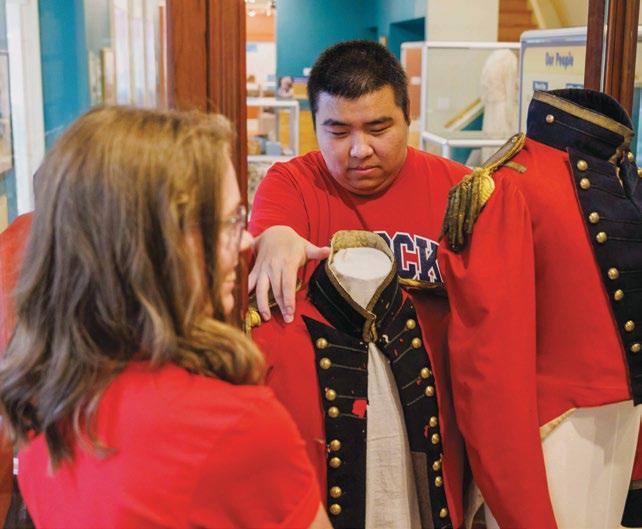
17
Core Di erentiation 2023-24 Budget 2022-23 Budget 2021-22 Actual 2020-21 Actual 28,738 59,050 19,082 68,706 39,426 48,362 48,418 41,445 87.9% 87,788 87,788 87,788 89,863
Figure 33: Base Operating Grants ($000s)
Figure 34: Differentiation envelope metrics
2023-24 Budget Report FRAMEWORK

18 2023-24 Budget Report REVIEW
At the time of writing this budget report, we are projecting, through our second trimester reporting (T2) for fiscal 2022-23, a remaining mitigation target of $0.3 million vs. the mitigation target as part of the budget of $3.0 million. The T2 reporting can be found at brocku.ca/about/university-financials. This outcome indicates that we have already mitigated $2.7 million of our budgeted mitigation target. The T2 reporting forecasts a revenue shortfall versus budget of $23.2 million, which is offset by mitigation strategies such as personnel savings forecasted to be $12.2 million and non-personnel operating costs savings to be $13.7 million. At year end, this projection will be updated to actual results in the 2022-23 Annual Report.
After another challenging year of prioritizing spending and reducing costs where possible we are budgeting a mitigation target for 2023-24 of $3.99 million, which represents approximately one per cent of the budgeted revenue. The 2023-24 budget was established with certain key assumptions:
1. The enrolment forecast shows an increase of 82 (0.5 per cent) undergraduate students and a decrease of 48 graduate (2.7 per cent) students as compared to 2022-23 forecasted all-in enrolment.
2. Changes to the Province’s tuition policy allowing for an increase to domestic out of province tuition rates, representing $0.09 million additional revenue as well as the opportunity to request tuition increases for programs which meet certain criteria established by the Province, representing an estimated additional $1.6 million.
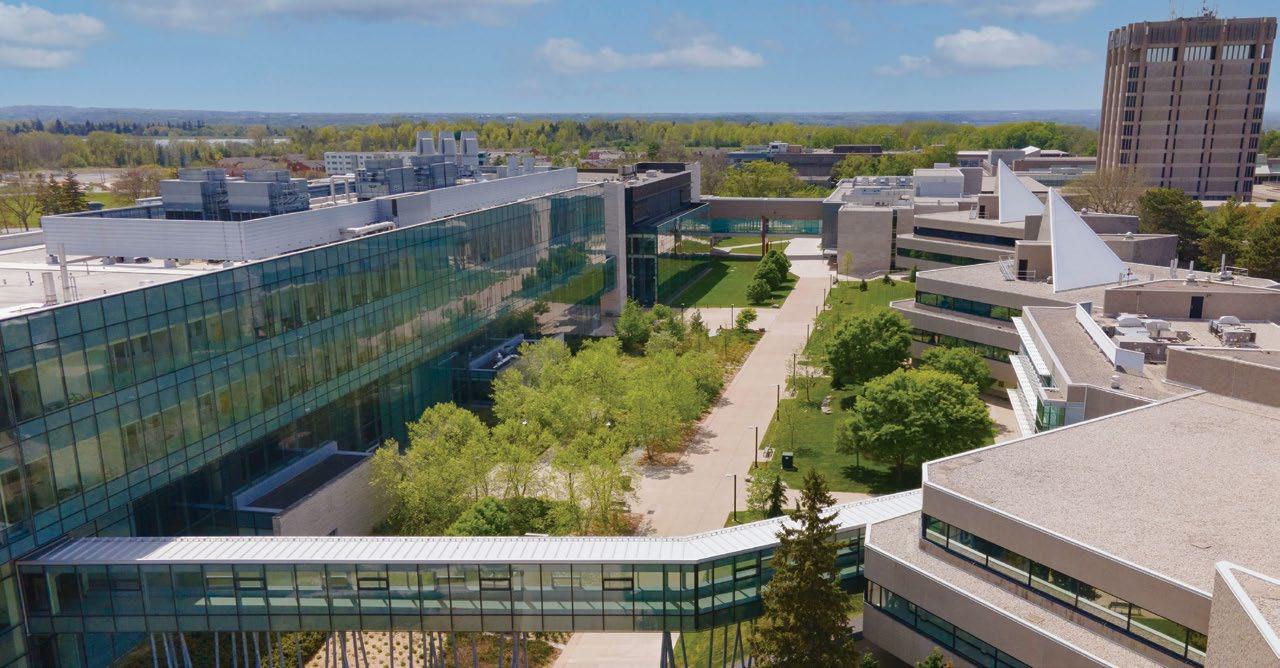
3. Ministry of Colleges and Universities (MCU) operating grants in 2023-24 are forecasted to be consistent with the amounts expected to be received in 2022-23, with the exception of additional funding for Nursing and Teacher Education. The funding model is described in the Grant revenue section of this report starting on page 28.
4. Inclusion of uncommitted strategic/discretionary funds of a half per cent of the revenue budget, at $1.95 million.
5. The assumption that the University would continue with mainly in-person operations for all of 2023-24. Due to the mitigation target in 2023-24, the mitigation measures of fiscal 2022-23 will remain in effect. These measures will assist us in meeting our target of a yearend balanced result or better. Steps are also required to find a way to permanently eliminate the need for these mitigation measures and ensure we remain financially sustainable, where revenues naturally grow in harmony with the rate of growth in our expenditures. Any surplus at the end of the year derived from mitigation efforts will be reinvested in strategic priorities of the Institutional Strategic Plan.
19
Financial
2023-24 Budget Report REVIEW
update
Historical timeline
In planning for the future, it can be useful to look back and ask “how did we get here?” The chart and historical timeline provided here attempts to rewind the clock and identify some key decisions with significant financial impact that have occurred since 2003-04. These key decisions have been identified on the timeline along with an undergraduate and graduate student headcount, and a faculty, professional librarian and staff headcount. The chart begins in 2003-04, as it closely coincides with when the move to a comprehensive university was proposed and endorsed. An interesting observation is that the student to faculty and librarians, and the staff to faculty and librarians ratios have not changed substantially since 2003-04.
Note: The faculty and professional librarians headcount figures accumulated represent roster data (i.e. all employees holding a faculty position in the academic year). The staff headcount figures are from Office of People and Culture and represent headcount as of October each year.
Note: The figures were obtained from the audited financial statements of Brock University, which were prepared in accordance with the Canadian generally accepted accounting principles for not-for-profit organizations (2003-04 to 2010-11) and in accordance with Canadian accounting standards for not-for-profit organizations (2011-12 to 2021-22).
20
Revenue Expense Surplus/(de cit) 0 15.9 11.9 12.0 7.0 2.8 13.2 10.2 7.3 7.4 (4.6) (16.1) (7.6) (5.8) (1.9) (2.2) 1.0 6.4 8.8 16.9 03-04 04-05 05-06 06-07 07-08 08-09 09-10 10-11 11-12 12-13 13-14 14-15 15-16 16-17 17-18 18-19 19-20 20-21 21-22 174 198 204 224 221 229 245 260 271 286 299 313 313 324 337 354 358 341 362 161 188 197 217 226 245 253 266 273 288 298 296 307 315 325 338 346 334 359
2023-24 Budget Report REVIEW
Figure 35: 2003 to 2022 historical audited financial results ($ millions)
The following charts present two different ways of examining space at the University. Figure 37 details the space usage by category as of 2022, which was prepared for the Council of Ontario Universities’ Survey of Physical Facilities, as well as an updated estimate for 2023. Only 69 per cent of the University’s space is assignable to specific functions, while 31 per cent is non-assignable, meaning it relates to items such as utility plants, corridors and hallways. Figure 38 details the deferred maintenance backlog by asset type and compares this to the replacement value of those assets. This information was obtained from the condition assessment performed by VFA Inc. (through Council of Ontario Universities) in May 2022, which determined Brock has $315 million in deferred maintenance requirements that have accumulated over a number of years. In addition, the chart details the Facility Condition Index (FCI) (deferred maintenance divided by the current replacement value), which determines the relative condition of the asset. The lower the FCI, the better the condition of the asset. For example, MIWSFPA has a low FCI, while buildings with higher FCIs are generally older, such as the Schmon Tower and the Walker Complex. Brock’s overall FCI is 0.22, while our goal is to maintain a FCI of 0.18.
(1) The 2022 data was prepared for submission to the Council of Ontario Universities Triennial report that takes place every 3 years. The data is as of November 1, 2022. The estimate for 2023 was updated after the original submission and is included as an updated comparison to the 2022 data.
(2) NNASM includes items such as central utilities plants, corridors, stairwells, elevators, service tunnels and parking structures.
Source: VFA Asset List Report as of May 2022
(1) Facilities Condition Index (FCI): Represents deferred maintenance backlog divided by replacement value.
(2) Central Utilities Building: Mainly relates to the Cogeneration Facility and also includes Facilities Management offices.
(3) Infrastructure: Includes many of the non-building assets, such as parking lots, storm sewers and roadways.
(4) Main – other: All buildings on the main campus that are not specifically identified.
2023-24 Budget Report TEXT TEXT i 2015-16 Budget Report REVIEW Pullout 2/i
Category Estimate 2023(1) Actual 2022 (1) Metres2 % Metres2 % Classroom facilities 13,796 6% 13,765 6% Laboratories –undergraduate 10,908 4% 10,918 4% Research laboratory space 12,600 5% 12,464 5% Academic departmental office and related 18,738 8% 18,561 8% Library facilities and library study space 7,183 3% 7,183 3% Athletic/recreation space 10,152 4% 10,152 4% Food service 6,094 2% 6,094 2% Bookstore and other merchandising facilities 1,104 0% 1,104 0% Plant maintenance 1,997 1% 1,997 1% Central administrative office and related 9,056 4% 9,367 4% Non-library study space 3,734 2% 3,734 2% Central services 2,563 1% 2,500 1% Health service facilities 577 0% 609 0% Common use and student activity space 1,903 1% 1,879 1% Assembly and exhibition facilities 1,636 1% 1,644 1% Residential space 55,347 23% 55,347 23% Animal space 701 0% 701 0% Other University facilities 9,996 4% 10,088 4% Health science clinical facilities 676 0% 676 0% Net non-assignable square metres (NNASM) (2) 75,525 31% 75,496 31% Total 244,286 100% 244,279 100%
Figure 37: Space usage
Space considerations
Deferred maintenance ($ millions) – Total $315 Facilities condition index(1) – Total 0.22 Replacement value ($ millions) – Total $1,434 Roy
Research
Mackenzie Chown Complex Central Utilities Building (2) East buildings Electrical distribution Infrastructure (3) Main – other (4) Marilyn I. Walker School of Fine and Performing Arts Plaza Building Residence buildings Brock Research and Innovation Centre Schmon Tower Service tunnels Thistle Walker Complex Welch Hall 1 166 60 39 77 175 10 42 3 32 33 79 53 1 26 35 2 326 19 8 4 82 38 16 2 76 25 64 22 59 14 161 0.01 0.24 0.17 0.06 1.02 0.97 0.15 0.02 0.06 0.06 0.45 0.46 0.11 0.33 0.35 0.24
and Lois Cairns Health and Bioscience
Complex
Figure 38: Deferred maintenance 2022
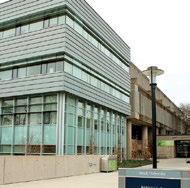



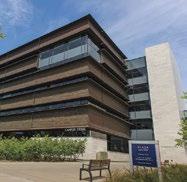
Plaza Building construction completed Welch Hall expansion completed International Centre construction completed Roy and Lois Cairns Health and Bioscience Research Complex construction completed Faculty and Librarians Permanent Sta Graduate Headcount Undergraduate Headcount F acult y a nd sta headcoun t 1,588 full-course equivalents o ered Double cohort ended
group
was certi ed Union group CUPE
Centre) was assumed 40 graduate programs 25 graduate programs Union group Unit 3
Instructors IATSE (Theatre was certi Required full-course load for faculty changed from 3 to 2.5 Required full-course load for faculty changed from 2.5 to 2 Double cohort began 1,489 full-course equivalents offered 2003-04 2004-05 2005-06 2006-07 2007-08 2009-10 2010-11 2011-12 2012-13 2008-09 FACULTY AND STAFF HEADCOUNT Faculty and librarians(1) 507 533 560 609 595 614 596 603 599 Ongoing staff(1) 637 708 766 816 831 915 923 895 922 Staff to faculty and librarians ratio 1.3 1.3 1.4 1.3 1.4 1.5 1.5 1.5 1.5 Graduate headcount(2) 858 1,065 1,053 1,169 1,259 1,419 1,544 1,536 1,534 1,630 Undergraduate headcount(2) 14,669 15,532 16,356 16,284 15,747 15,431 15,949 16,341 16,656 16,882 Student to faculty and librarians ratio 31 31 31 29 29 27 29 30 30 (1) Faculty and professional librarians headcount figures represent all employees holding a faculty position in the academic year. Staff headcount figures represent headcounts as of October (2) Figures represent the number of students in each Faculty of major on Nov. 1 of each academic year (as per PFIS-USER submissions). In addition, figures for 2014-15 to 2022-23 also include Pullout 2/ii
Union
CUPE 4207–Unit 2 (ESL Co-ordinators)
2220 (Rodman Hall Art
(ESL



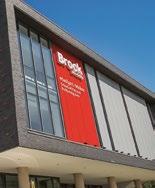
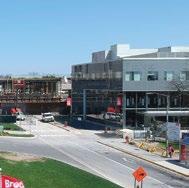
Goodman School of Business expansion and Rankin Family Pavilion substantially completed Acquired Schmon Parkway site Residence 8 construction completed Canada Games Park completed Marilyn I. Walker School of Fine and Performing Arts construction completed Historical timeline S tudent headcoun t 44 graduate programs 48 graduate programs 52 graduate programs group CUPE 4207–Instructors) and Technicians, etc.) certi ed 1,741 full-course equivalents o ered 1,718 full-course equivalents o ered 1,746 full-course equivalents o ered 2012-13 2013-14 2014-15 2015-16 2016-17 2017-18 2018-19 2019-20 2020-21 2021-22 Figure 36 STUDENT HEADCOUNT 608 616 611 603 607 614 623 625 622 626 640 961 964 919 912 921 938 957 987 991 967 1,014 1.6 1.6 1.5 1.5 1.5 1.5 1.5 1.6 1.6 1.5 1.6 1,630 1,689 1,718 1,703 1,756 1,777 1,826 2,007 1,951 1,860 1,791 16,882 16,999 17,154 16,813 17,042 17,055 17,286 17,789 17,772 17,653 17,398 30 30 31 31 31 31 31 32 32 31 30 October of each year. include new-entry enrolments as of Feb. 1 for certain International Student Programs (ISPs) and Technological Education. 2022-23 Pullout 2/iii

Pullout 2/iv
Funding budget
The funding budget is used to communicate the revenue targets and expense approvals that support the teaching, research, scholarly, creative and service activities of the University. It fundamentally tracks where cash has been allocated. Figure 39 details the funding budget for 2023-24 in comparison to the 2022-23 budget and 2021-22 actuals. Some reclassifications were made to the 2022-23 budget for comparison purposes when the overall funding budget was not impacted. See Appendix B for a reconciliation of these reclassifications.
The 2023-24 budget includes a mitigation target of $3.99 million to be found through in-year savings. This mitigation target is comparable to mitigation targets from previous years' budgets, including the $3.0-million mitigation target as part of the 2022-23 budget.
Tuition revenue
Tuition revenue, defined as a fee charged for educational instruction, is budgeted to be $183.1 million, $10.0 million lower than the 2022-23 budget. Figure 41 on the following page details 2023-24 tuition by Faculty of major, split by graduate/undergraduate and domestic/international as compared to the 2022-23 budget and 2021-22 actuals. Of the total tuition revenue, $180.0 million is budgeted in the University Global responsibility centre, representing all tuition revenue except for $1.3 million related to continuing teacher education and adult education budgeted in the Faculty of Education, and $1.7 million of intensive and short-term English language programs and Professional and Continuing Studies tuition revenue budgeted in Professional and Continuing Studies and ESL.
TUITION YEAR-OVER-YEAR RECONCILIATION
2022-23 Budget
$193.0 million
• ($16.1) million – 2022-23 Budget to 2022-23 Actual (note: actual tuition was not yet finalized at the time of writing).
Revenue assumptions
Student fees
Student fees include both tuition and fee revenue and represent 50 per cent of total revenue (52 per cent in 2022-23). Student fees are budgeted to be $194.7 million for 2023-24, detailed in Figure 40, which represents a $9.5-million decrease as compared to the 2022-23 budget.
• $3.5 million – Rate increase impact based on approved international rates ($1.8 million), out of province rates ($0.09 million) and tuition anomalies ($1.6 million).
• $2.7 million – Enrolment impact ($0.8 million domestic, $1.4 million international, $0.3 million Intensive and Short-term English as a Subsequent Language, $0.3 million Professional and Continuing Studies and ($.05) million in both Continuing Teacher Education and Adult Education).



2023-24 Budget
$183.1 million

23
($000s) 2023-24 Budget 2022-23 Budget 2021-22 Actual Tuition 183,061 193,012 177,399 Fee revenue 11,667 11,256 10,665 Total student fees 194,728 204,268 188,064
Figure 40: Student fees
($000s) 2023-24 Budget 2022-23 Budget 2021-22 Actual Revenue Student fees 194,728 204,268 188,064 Grant revenue 105,254 99,589 99,780 Internal chargebacks 12,118 11,980 7,346 Inter-fund revenue 12,510 12,127 5,943 Other revenue 65,786 62,176 50,256 Total revenues 390,396 390,140 351,389 Operating costs Personnel costs (254,880) (246,262) (221,304) Inter-fund expense (29,879) (32,705) (28,926) Other operating costs (109,625) (114,176) (97,262) Total operating costs (394,384) (393,143) (347,492) Mitigation target 3,988 3,003 Discretionary appropriations (3,896) Funding surplus - - 1 2023-24 Budget Report BUDGET DETAILS
Figure 39
Figure 41: Tuition revenue (1)
Total domestic tuition is budgeted to be $108.1 million, including $1.6 million related to tuition anomalies, which is $0.6 million less than the 2022-23 budget. The 2023-24 Tuition Fee Framework released by the MCU on March 2, 2023 allowed universities to submit applications for ministry approval of tuition fee increases in certain regulated programs based on identified criteria. Brock’s estimate of the impact of these requests at the time of the budget was $1.6 million. Total international tuition is budgeted to be $72.0 million, which is $10.1 million less than the 2022-23 budget. Domestic and International budgeted enrolment are shown in Figure 42. Intensive and short-term English language program (ESL) revenue is budgeted to be $1.5 million, which is $0.7 million more than the 2022-23 budget. This increase in ESL tuition is a result of operations on a path to return to pre-pandemic levels, although there is still concern and continued restrictions on international students entering Canada. Professional and Continuing Studies are budgeting tuition revenue of $0.3 million for 2023-24. Continuing Teacher Education and Adult Education constitute the remaining types of tuition revenue and are budgeted to be $0.8 million and $0.5 million respectively.
Note: although Figure 41 details global by Faculty of major, the revenue and expense allocation model explained in the ‘Revenue and expense allocation model’ section of this report has been adopted and records tuition based on where students take their courses (i.e. teaching Faculty).
The previous page includes a reconciliation of the overall increase in tuition budgeted for 2023-24 compared to the 2022-23 budget with three main factors – the difference of the 2022-23 budgeted tuition to the 2022-23 actual tuition (estimated at trimester 2), the enrolment change, and the tuition rate change, both as compared to 2022-23 actual. The centrally managed enrolment projection model is described in the ‘Enrolment forecasting’ section of this report starting on page 25. As detailed in Figures 46 and 47, these projections resulted in all-in undergraduate enrolment forecasted to increase 0.5 per cent over 2022-23 actual enrolment and graduate enrolment decreasing by 2.7 per cent.
Domestic tuition rates remained consistent with 2022-23 as regulated by the Ministry of Colleges and Universities (MCU) with the exception of outof-province student tuition, which is allowed to increase up to five per cent and tuition anomalies,
24
($000s) 2023-24 Budget 2022-23 Budget 2021-22 Actual Undergraduate – domestic Faculty of Applied Health Sciences 24,460 25,347 24,157 Goodman School of Business 16,142 16,979 17,515 Faculty of Education 8,412 8,270 8,437 Faculty of Humanities 10,986 10,501 10,373 Faculty of Mathematics and Science 12,179 12,087 11,771 Faculty of Social Sciences 25,771 25,795 25,592 Other (2) 310 314 365 Total undergraduate – domestic 98,260 99,293 98,210 Graduate – domestic Faculty of Applied Health Sciences 2,532 1,971 2,308 Goodman School of Business 1,372 2,280 1,524 Faculty of Education 992 1,092 915 Faculty of Humanities 391 459 295 Faculty of Mathematics and Science 632 824 752 Faculty of Social Sciences 2,314 2,749 2,544 Total graduate – domestic 8,233 9,375 8,338 Total domestic 106,493 108,668 106,548 Undergraduate – international Faculty of Applied Health Sciences 5,328 5,960 5,035 Goodman School of Business 14,972 18,821 15,523 Faculty of Education 696 722 690 Faculty of Humanities 2,387 2,530 2,321 Faculty of Mathematics and Science 13,798 14,268 12,023 Faculty of Social Sciences 17,310 19,427 16,688 Other (2) 50 39 Total undergraduate – international 54,491 61,778 52,319 Graduate – international Faculty of Applied Health Sciences 455 301 333 Goodman School of Business 12,811 14,697 12,533 Faculty of Education 695 1,093 1,148 Faculty of Humanities 424 416 261 Faculty of Mathematics and Science 1,736 2,393 1,578 Faculty of Social Sciences 1,341 1,354 949 Total graduate – international 17,462 20,254 16,802 Total international 71,953 82,032 69,121 Total undergraduate and graduate tuition 178,446 190,700 175,669 Continuing Teacher Education –Additional Qualifications (AQ) 808 831 756 Adult Education 487 662 596 Intensive and Short-term English Language Programs (IELP & SELP) 1,470 819 378 Professional and Continuing Studies 250 Total tuition revenue before tuition anomalies 181,461 193,012 177,399 Domestic tuition anomalies 1,600 Total tuition revenue 183,061 193,012 177,399 (1) Figures based on Faculty of major. (2) Includes letter of permission, non-degree students and auditors.
2023-24
BUDGET
Budget Report
DETAILS
which have yet to be approved, as discussed earlier. The tuition anomalies increases are applicable to first-year incoming students starting in 2023-24 only. Therefore, the majority of tuition revenue growth resulting from tuition rate increases were directly related to international tuition rates. For undergraduate international tuition, a new cohort model was introduced in 2022-23, which sees an eight per cent increase each year for year one students only. Tuition rates will then be frozen for four additional years to provide students with a total of five years of fixed tuition rates to assist with budget planning and fiscal stability for their four-year degree program, with one additional year to graduate. After the fifth year, the tuition rate would revert to the incoming Year 1 tuition rate. The cohort model for tuition rate increases for international students represents a response to the insights of Brock University units directly working with international students and recognizing that these students would experience significant benefits from having a direct line of sight for tuition rates for all years of study for their program.
International Student Program (ISP) tuition rates will be increased by five per cent over 2022-23, recognizing most of these programs are a one-year duration or less. A tuition rate freeze for international research-based master's and PhD programs was started in 2018-19 to support Brock’s commitment to enhancing research. Research-based master's and PhD students were receiving a greater proportion of Faculty research grant dollars to offset their rising tuition costs, leaving less funding available to support other research expenditures. This strategy is continued into 2023-24. For an explanation of the tuition fee policies for both government-funded programs and non-government funded programs as well as the approved tuition fee increases for 2023-24, see Appendix D.
Enrolment forecasting Enrolment projections – undergraduate
There are two key assumptions in projecting undergraduate enrolment: intake targets for Year 1 and the retention behaviour of current students. For intake purposes, students are classified on the basis of their admission status. Based on observation, each group behaves differently in terms of their retention status:
(1) domestic students directly from secondary school,
(2) domestic students not directly from secondary school, and (3) international students. Figure 43 displays the undergraduate Year 1 (full-time) intake headcount projections for 2023-24 as compared to prior years.
International students
Domestic students not directly from secondary school
Domestic students directly from secondary school
Source: Actual values accessed from PowerBI Admissions on March 30, 2023. Values may differ from the 2023-24 Budget Report as PowerBI is a fluid data source. Intake targets are sourced from AVP Enrolment Services and Admissions Office.
Intake targets are set through collaboration and consultation with units across the University, including the Faculties. For the purposes of the 2023-24 budget,
25
Type 2023-24 Budget 2022-23 Actual 2023-24 Budget vs. 2022-23 Actual 2022-23 Budget 2023-24 Budget vs. 2022-23 Budget 2021-22 Actual # % # % Undergraduate – domestic 15,643 15,601 42 0.3% 15,985 (342) (2.1%) 15,760 Graduate – domestic 1,131 1,139 (8) (0.7%) 1,330 (199) (15.0%) 1,197 Total – domestic 16,774 16,740 34 0.2% 17,315 (541) (3.1%) 16,957 Undergraduate – international 1,837 1,797 40 2.2% 2,032 (195) (9.6%) 1,893 Graduate – international 612 652 (40) (6.1%) 754 (142) (18.8%) 663 Total – international 2,449 2,449 - 0.0% 2,786 (337) (12.1%) 2,556 Total headcount 19,223 19,189 34 0.2% 20,101 (878) (4.4%) 19,513
Figure 42: All-in student headcount by type (1)
(1) 'All-in' includes letter of permissions, non-degree students, auditors, additional qualifications, and certificates.
2023-24 Budget Report BUDGET DETAILS
Figure 43: Year 1 intake headcount (undergraduate)
Year 1 intake is forecast to increase 2.6% over 2022-23 2018-19 Actual 2019-20 Actual 2020-21 Actual 2021-22 Actual 2022-23 Actual 2023-24 Forecast 383 465 379 329 260 268 586 578 523 664 642 652 2,974 3,263 2,501 2,649 2,791 2,869 Total 3,943 4,306 3,403 3,642 3,693 3,789
Year 1 intake is projected to see an increase of 2.6 per cent over 2022-23 actuals, as shown in Figure 43. This growth continues to represent a rebound after the low intake in 2020-21. Year 1 intake is dependent on applications received. Undergraduate applications continue to rebound from disruptions caused by the pandemic. As of late March 2023, Brock has seen a year-over-year increase of 15.1 per cent, and a 23.9 per cent increase over 2021. Brock's undergraduate applications directly from secondary school are up 14.3 per cent over prior year, as shown in Figure 44. Though not uniformly, this rebound is occurring across all Faculties and most programs, and among both domestic and international populations. In Ontario, this cycle has set new benchmarks for applicants from the GTA, Niagara, as well as across province. There is strong growth among students applying directly from secondary schools as well as from other pathways, including university and college transfer populations. Applications from Canadian provinces outside of Ontario are tracking flat compared to previous years. International applications are tracking 10 per cent higher than 2022, with a notable increase to the number of qualified applicants receiving offers. India and China remain the two largest source countries for applications; however, a renewed international diversification strategy has resulted in increases in applications from Africa (led by Nigeria), East Asia, the Middle East, and South Asian markets outside of India.
Applicant behaviour remains extremely unpredictable in the post-pandemic context. Numerous factors continue to influence students including increased competition, visa processing delays, and disruptions to student mobility caused by economic or geopolitical factors. It is also notable that there is a system-wide trend of prospective students submitting more applications than historical norms, presumably a reflection of a level of uncertainty, and a desire to explore more options. A robust applicant pool is a positive sign the efforts of the previous months have been successful. In the next phase of the cycle, the emphasis shifts to convert admitted applicants into registered Brock students. This includes a return to full capacity campus tours and March Break programming, the first in-person Open House since 2019, and a suite of outreach initiatives that include email, calling and SMS campaigns and in-person and virtual receptions. All activities are strengthened and supported by a comprehensive digital marketing and communications effort developed and deployed in collaboration with University Marketing and Communications.
These efforts and activities drive to the applicant confirmation deadline of June 1st, followed by the academic summer orientation program Smart Start, which supports students through their transition and course registration process.
The Year 1 intake figures are then combined with retention and progression rates, as well as movement to and from full-time and part-time status (retention behaviour), to determine a total returning undergraduate headcount. This retention behaviour is determined by reviewing historical enrolment patterns. As an example, Figure 45 shows the return or retention rates of students who entered the University directly from secondary school in 2021 into the 2022-23 year. Note: retention rates by Faculty are detailed in Figure 22 on the ‘The Big Picture' pullout.
Source: Data was extracted from the PowerBI application details as of March 9, 2023. Figures may differ from prior year as Power BI is a fluid data source.
Admissions and recruitment efforts continue to focus on early offer and conversion strategies. Offers of admission to undergraduate programs are up 29.72 per cent over the same date last year, with 83.24 per cent of the applicant pool having received an offer. This compares to historical norms of 62-65 per cent during the 2016-2020 cycles.
Source: November 1 PFIS-USER submissions for both 2021 and 2022, and the 2022 academic year Consortium for Student Retention Data Exchange (CSRDE) submission
26
Faculty 2023-24 2022-23 % Change Applied Health Sciences 5,008 4,388 14.1% Goodman School of Business 2,928 2,586 13.2% Humanities 2,068 1,755 17.8% Mathematics and Science 3,159 2,607 21.2% Social Sciences 5,252 4,780 9.9% Total applications 18,415 16,116 14.3% Offer rate (offers/applications) 74% Yield rate (registrations/offers) 24% Resulting intake 2,791
Figure 44: Domestic applications directly from secondary school
2021-22 degree seeking, firsttime, first-year entry cohort # students % students Entered in 2021 as Year 1 3,018 Activity in 2022-23 Returned full time as Year 1 673 22% Returned full time as Year 2 1,915 64% Returned as part time as Year 1 42 1% Returned as part time as Year 2 21 1% Not registered 367 12% Total 3,018 100%
Figure 45
2023-24 Budget Report BUDGET DETAILS
After these considerations, for the purposes of the 2023-24 budget, total undergraduate all-in headcount is forecasted to increase by 82 students or 0.5 per cent as compared to 2022-23 actual headcount, as shown in Figure 46.
46: Undergraduate all-in headcount
Source: Figures represent the number of students in each Faculty of major on Nov. 1 of each academic year (as per PFIS-USER submissions). In addition, figures also include new entry enrolments as of Feb. 1 for Technological Education programs.
Enrolment projections – graduate
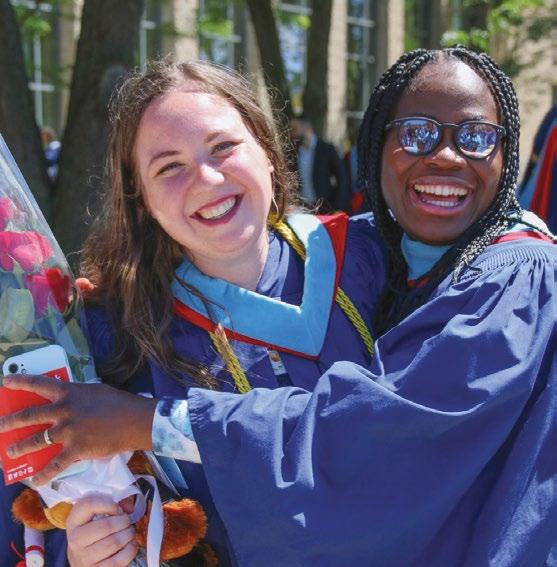
Graduate enrolment projections are produced with intake targets from the Faculty of Graduate Studies, and then combined with historic progression, retention and graduation rates of continuing graduate students. For the purpose of the 2023-24 budget, overall graduate enrolment is forecast to experience a decrease of 48 students or 2.7 per cent over actual 2022-23 headcount enrolment. As shown in Figure 47, the Faculty of Humanities is forecasting growth in graduate enrolment of 18 additional students, with the Faculty of Applied Health Sciences and Faculty of Education forecasting relatively flat enrolment as compared to 2022-23. The largest decrease in graduate enrolment is forecasted in the Goodman School of Business with 48 less students. The Faculties of Social Science and Mathematics and Science are also forecasting a decrease of 13 and 9 students respectively. As of March 24, 2023, the number of graduate applications are 7.0 per cent higher than this date last year, the number of admitted offers are up 11 per cent and confirmations more than 60 per cent higher.
For both undergraduate and graduate, once the total forecasted headcount is determined, it is then translated into full-time equivalents (FTEs) based on historical fulltime/part-time student enrolment patterns, which are then combined with the tuition rates to calculate tuition.
Source: Figures represent the number of students in each Faculty of major on Nov. 1 of each academic year (as per PFIS-USER submissions). In addition, figures also include new entry enrolments as of Feb. 1 for certain International Student Programs (ISPs).
Fee revenue
Fee revenue is budgeted to be $11.7 million, which is $0.4 million higher than the 2022-23 budget. Student fee revenue includes both ancillary fees and other student fees.
Ancillary fees are established by student referendum, according to the ancillary fee protocol, and agreed to with the Brock University Students’ Union (BUSU) and Graduate Students’ Association (GSA). Some existing fees can increase automatically (i.e. either each year or after the Consumer Price Index has accumulated to five per cent since the last fee increase). Ancillary fees are all assessed and collected by the University, and are either administered by the University, BUSU or the GSA. Note: only the University-administered ancillary fees are included as part of the funding budget. The setting of ancillary and administrative fees was delegated to the President and Vice-President, Administration at the Dec. 1, 2016 Board of Trustees meeting.
27
Faculty 2023-24 Budget 2022-23 Actuals Change % Change Faculty of Applied Health Sciences 4,074 4,067 7 0.2% Goodman School of Business 2,507 2,577 (70) (2.7%) Faculty of Education 1,686 1,621 65 4.0% Faculty of Humanities 1,907 1,908 (1) (0.1%) Faculty of Mathematics and Science 2,296 2,234 62 2.8% Faculty of Social Sciences 4,910 4,885 25 0.5% No Faculty 100 106 (6) (5.7%) Total 17,480 17,398 82 0.5%
Figure
2023-24 Budget Report BUDGET DETAILS
Faculty 2023-24 Budget 2022-23 Actuals Change % Change Faculty of Applied Health Sciences 317 315 2 0.6% Goodman School of Business 548 596 (48) (8.1%) Faculty of Education 173 171 2 1.2% Faculty of Humanities 78 60 18 30.0% Faculty of Mathematics and Science 177 186 (9) (4.8%) Faculty of Social Sciences 450 463 (13) (2.8%) Total 1,743 1,791 (48) (2.7%)
Figure 47: Graduate all-in headcount
University-administered ancillary fees are budgeted to be $7.4 million ($7.0 million in 2022-23). Figure 48 details the ancillary student fees, including noting the department where the fee is reported.
related to the Business English and Skill Transition fee for International Student Program participants in the Goodman School of Business.
Grant revenue
Grant revenue, as reported in the 2023-24 budget, includes Ministry of Colleges and Universities (MCU) operating grants and other operating and specific purpose grants. Grant revenue represents 27 per cent of total revenue (26 per cent in 2022-23 budget), and is budgeted to be $105.3 million for 2023-24, which is detailed in Figure 49. Grant revenue is budgeted to increase $5.7 million compared to the 2022-23 budget and $5.5 million compared to actual 2021-22.
Other student fees of $4.3 million ($4.3 million in 2022-23) are included as part of fee revenue in the 2023-24 budget. Other student fees include the International Student Recovery Fee, which offsets the reduction in the Core Operating Grant, calculated as $750 per international student. This fee is charged to international students and results in $1.79 million ($1.91 million in 2022-23) of revenue in 2023-24. It is reported as part of the University Global responsibility centre.
Also included in other student fees are programspecific fees charged by the program in which a student is enrolled. Included in this figure are $2.02 million ($1.90 million in 2022-23) of co-op fees (reported in Co-op, Career and Experiential Education), $0.28 million ($0.22 million in 202223) of ESL ancillary fees for international students (reported in Professional and Continuing Studies and ESL) and $0.18 million ($0.26 million in 2022-23)
Ministry of Colleges and Universities (MCU) Operating grants
As detailed in Figure 49, MCU operating grants include the Core Operating Grant (COG), the Differentiation Envelope and the Special Purpose Operating Grant Envelope, offset by the International Student Recovery, all of which are MCU funded.
Differentiation Envelope
In 2019, the MCU announced that performance/ outcomes-based funding would be implemented starting in 2020-21 as part of the Strategic Mandate Agreements 2020-25 (SMA3) process. The SMA3 links 10 metrics (nine systemwide and one institutionspecific) to performance/outcomes-based funding through two priority areas – skills and job outcomes, and economic and community impact. These metrics are shown in Figure 34 on page 17.
28
($000s) 2023-24 Budget 2022-23 Budget 2021-22 Actual Core Operating Grant 41,445 48,362 59,050 Differentiation Envelope (Performance/Outcomes-based Funding Grant) 48,418 39,426 28,738 Special Purpose Operating Grant Envelope 3,315 3,259 3,740 International Student Recovery (1,790) (1,928) (1,720) Total MCU operating grants 91,388 89,119 89,808 Other MCU and specific purpose grants 13,866 10,470 9,972 Total grant revenue 105,254 99,589 99,780 2023-24 Budget Report BUDGET DETAILS
Figure 49: MCU Operating grants
($000s) 2023-24 Budget Undergraduate Graduate Total Student Life fee 2,073 2,073 (1) Athletic fee 1,582 75 1,657 (2) Zone Expansion fee 1,411 80 1,491 (3) Health Services fee 580 66 646 (4) Sexual Violence and Support fee 251 251 (5) Student Justice Centre fee 251 251 (5) Pool fee 251 251 (2) Recreation Facilities fee 222 23 245 (2) Aboriginal Student Services levy 233 11 244 (6) Ombuds levy 109 12 121 (7) Zone Fitness credit 91 91 (2) Mental Health and Wellness fee 71 71 (4) Total 6,963 429 7,392 (1) $1.5 million is reported in Brock Sports and Recreation and $0.56 million in Student Wellness and Accessibility (2) Reported in Brock Sports and Recreation (3) Reported in the Financing unit (4) Reported in Student Wellness and Accessibility (5) Reported in Human Rights and Equity Services (6) Reported in the Hadiyaˀdagénhahs First Nations, Métis and Inuit Student
Figure 48: Ancillary student fees
Centre
Ombudsperson
(7) Reported in the Office of the
This funding model includes tying a larger portion of funding to metric performance, through the Differentiation Envelope, as described in the Budget Environment section starting on page 16 of this report. As a result of the global pandemic, the metrics tied to the Differentiation Envelope did not impact the grant funding for 2020-21, 2021-22 or 2022-23. It is our understanding that the metric performance results will be linked to funding in 2023-24 and Brock’s assumption is that our metrics will be met for the year which ensures full funding.
Each university’s Differentiation Envelope proportion will vary and will be capped at the system average. For 2023-24, Brock’s Differentiation Envelope is budgeted to be $48.4 million, which represents 53 per cent of the total MCU operating grants, and is reported in the University Global responsibility centre.
Core Operating Grant (COG)
The Core Operating Grant (COG) represents the portion of the MCU operating grants that are related to enrolment. The COG funding continues to be governed by an enrolment corridor mechanism, with Brock's midpoint weighted grant units (WGUs) multiplied by the global WGU rate to determine the COG. The corridor midpoint includes actual enrolment levels in 2019-20, including graduate spaces (master’s degrees and PhDs) achieved up to target in SMA2, meaning the additional growth beyond 2019-20 levels does not receive additional incremental funding. For more information regarding the enrolment corridor, see the Budget Environment section on page 17 of the 2021-22 Budget Report. Brock is budgeting the COG to be $41.4 million in 2023-24, which is reported in the University Global responsibility centre. The budget for the COG was established based on MCU communication to date, including an incremental $2.1 million related to teacher education which is currently pending approval by the Province. The
2023-24 budget for the COG, in combination with the Differentiation Envelope, represents $89.8 million, which is consistent with the 2022-23 budget with the exception of the incremental funding for teacher education.
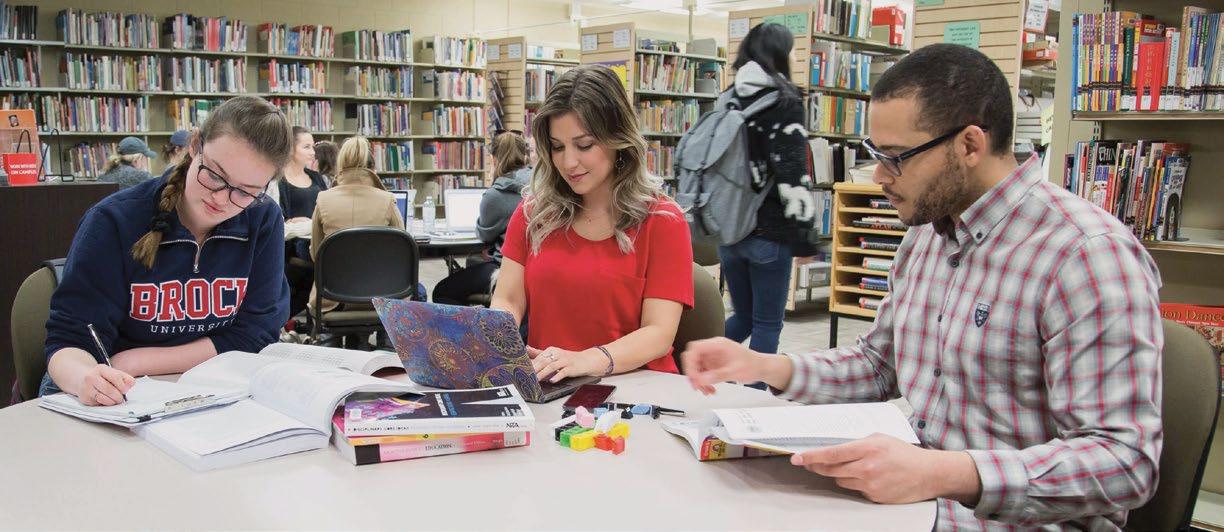
Special Purpose Operating Grant Envelope
There is also a third major component of the MCU operating grants, the Special Purpose Operating Grant Envelope, which represents funding by which the government is able to address system priorities, such as initiatives to support Indigenous learners and students with disabilities. For the purposes of the 2023-24 budget, this envelope includes a number of MCU-funded grants, as detailed in Figure 50.
29
($000s) 2023-24 Budget 2022-23 Budget 2021-22 Actual Grant in Lieu of Municipal Taxation 1,106 1,087 1,106 Access Fund for Students with Disabilities 762 702 779 Indigenous Student Success Fund 336 336 302 Credit Transfer Grant 248 256 238 Access and Inclusion Program 311 234 Campus Safety Grant 133 133 133 Mental Health Support Grant 139 139 234 Mental Health Workers Grant 100 100 194 Other MCU special purpose grants 180 272 754 Total Special Purpose Operating Grant Envelope 3,315 3,259 3,740 2023-24 Budget Report BUDGET DETAILS
Figure 50: Special Purpose Operating Grant Envelope
• Grant in Lieu of Municipal Taxation: The MCU provides subsidies to universities to pay their municipal taxes. The municipal tax (payment in lieu of property taxes) is based on a charge of $75 per domestic FTE; however, the related grant does not change with enrolment. The 2023-24 tax payments are budgeted to be $1.23 million ($1.25 million in 2022-23) and the grant is budgeted to be $1.10 million ($1.09 million in 2022-23); therefore, $0.13 million is budgeted to be unfunded through this grant. Both the grant revenue related to the Grant in Lieu of Municipal Taxation and the offsetting payment in lieu of property taxes are reported as part of the Utilities, Taxes and Insurance responsibility centre.
• Accessibility Fund for Students with Disabilities: The MCU provides funding to support a wide range of services for students with disabilities through the Access Fund for Students with Disabilities (AFSD). These services include access to adaptive computer and software learning technology; arranging notetaking for students who are visually impaired; and interpreter services for students who are deaf, deafened and hard of hearing. Brock’s funding for 2023-24 is budgeted to be $0.76 million ($0.70 million in 2022-23). The grant revenue related to the AFSD is shown as part of Student Wellness and Accessibility.
• The Indigenous Student Success Fund: The MCU supports Indigenous students through funding for student support initiatives, academic enrichment and partnership initiatives. The 2023-24 budget for this funding is $0.34 million ($0.34 million in 202223), which is reported in Hadiyaˀdagénhahs First Nations, Métis and Inuit Student Centre.
• Credit Transfer Grant: The MCU funds support for post-secondary education transfer mobility initiatives. The 2023-24 budget for this funding is $0.25 million ($0.26 million in 2022-23), which is reported in The Office of the Registrar.
• Ontario Post-Secondary Access and Inclusion Program: The MCU provides funding to support students that might not otherwise access postsecondary education. The 2023-24 budget for this funding is $0.31 million ($0.23 million in 202223), which is reported in Student Life and Success.
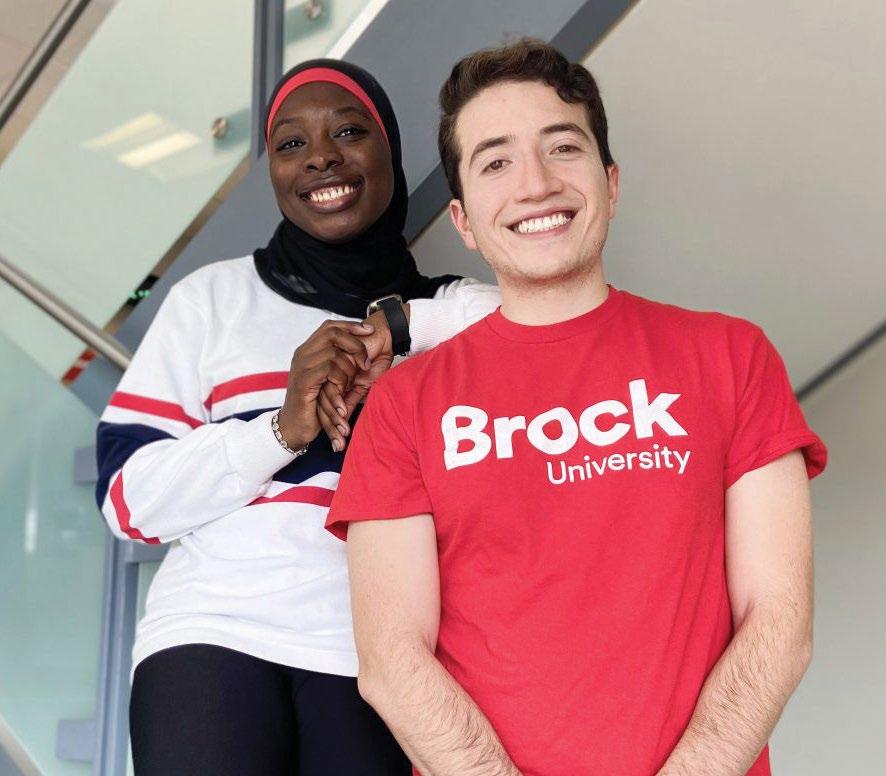
• Campus Safety Grant: The MCU provides funding to support sexual violence prevention and campus safety efforts at publicly assisted postsecondary institutions. The 2023-24 budget for this funding is $0.13 million ($0.13 million in 2022-23), which is reported in Human Rights and Equity Services.
• Mental Health Support for Post-Secondary Education Students Grant and Mental Health Workers Grant: The MCU funds support for mental health initiatives for students. The 2023-24 budget for this funding is $0.14 million ($0.14 million in 2022-23) and $0.10 million ($0.10 million in 2022-23), respectively. Both are reported in Student Wellness and Accessibility.
• Also included in the Special Purpose Operating Grant Envelope are the following: Disabilities Interpreters' Grant and First Generation Bursary funding. The revenue related to these grants is shown as part of Student Wellness and Accessibility, and the Scholarship, Bursaries and Fellowships responsibility centre.
International Student Recovery (ISR)
The ISR offsets MCU operating grants by $750 for every undergraduate and master’s-level international student. This reduction is budgeted to be $1.79 million in 2023-24 ($1.93 million in 2022-23) and is reported in the University Global responsibility centre.
Other MCU and specific-purpose grants
The University receives a number of other MCU grants, not included as part of the ‘MCU operating grants,’ as well as a number of other specific-purpose grants, which are detailed in Figure 51.
30
($000s) 2023-24 Budget 2022-23 Budget 2021-22 Actual Nursing Grant 6,192 4,518 3,537 Research Support Fund 2,500 2,279 2,279 Facilities Renewal Program Funds 3,853 2,953 2,953 Other specific-purpose grants 1,321 720 1,203 Other MCU and specific purpose grants 13,866 10,470 9,972
Figure 51: Other MCU and specific-purpose grants
2023-24 Budget Report BUDGET DETAILS
Nursing Grant
Prior to 2022-23, the Nursing Grant had been separately funded through the college system. Brock received its grant through Loyalist College and was paid on a slipyear basis (based on enrolment in the prior year). In Feb. 2020, the Ontario government announced that colleges and universities were permitted to offer Bachelor of Nursing programs on a stand-alone basis. As such, the Brock-Loyalist Collaborative Nursing program was dissolved. The MCU communicated in Oct. 2021 that the total enrolment at that time of 540 full-time equivalent students (FTEs) would be split evenly between Loyalist College and Brock, meaning each institution would receive an allocation of 270 FTEs. In addition, expansion funding of an additional 107 FTEs has been confirmed by the MCU for 2021-22. Brock anticipates further additional expansion funding for 2022-23 and 202324. While uncertainty still exists on how the funding for nursing students will occur in total, for the purposes of the 2023-24 budget, it was assumed the majority of Brock’s growth in nursing enrolment would be funded and results in a budgeted grant of $6.19 million ($4.52 million in 2022-23). This grant is reported in the University Global responsibility centre.
Research Support Fund
The Research Support Fund is a Government of Canada funding program to assist Canadian post-secondary institutions in offsetting the cost of administering research awards from the three federal granting councils (Natural Sciences and Engineering Research Council, Social Sciences and Humanities Research Council and the Canadian Institute of Health Research). Brock receives funding to support the indirect costs incurred on Tri-Council-funded research through the program. These costs can include maintenance and utilities of libraries and laboratories, salaries for staff or students who provide research administration support, training costs for workplace health and safety, or the administrative costs associated with getting a patent. The amount is determined by a formula that incorporates a base amount and the average of the last three years of research funding from the three agencies. Brock’s funding is estimated to be $2.50 million for 2023-24 ($2.28 in 2022-23). This $2.50 million includes $0.05 million related to additional dedicated security research funding provided by the federal government to equip Canadian research institutions and their research teams with the tools and knowledge to secure their research. The Research Support fund is reported as part of the Office of Research Services.
Facilities Renewal Program funds
The provincial Facilities Renewal Program (FRP) funds are meant to help ensure that academic spaces and supporting infrastructure are maintained in good repair to provide a safe environment to work and study. The distribution of the university sector FRP funds has been determined based on the university’s share of the theoretical space entitlement calculated in accordance with the Council of Ontario Universities’ space standards. The data used in the formula is taken from the Inventory of Physical Facilities of Ontario Universities, which is updated every three years. The funding also includes top-up funding, which is distributed based on an institution's enrolment. The formula also includes a floor so that no institution receives less than 0.5 per cent of the total university sector allocation. On May 2, 2022, the MCU announced that the funding amount for Brock University would increase $0.9 million to $3.8 million for the 2022-23 funding allocations. Communication related to 2023-24 had not been received at the time of budget preparation, as such, the budget for 202324 is consistent with 2022-23 actuals at $3.8 million. The grant revenue related to the Facilities Renewal Program funds is reported in the Capital responsibility centre. The specific projects the Facilities Renewal Project Funds are being used for are detailed as part of the capital and related project budget, starting on page 77.
Other specific-purpose grants
Included in other specific-purpose grants are a number of special grants, including the following:
• Ontario Graduate Scholarships in the amount of $0.60 million in 2023-24 and Queen Elizabeth II program in the amount of $0.08 million in 2023-24. These two grants and their offsetting scholarship expenses are included in the Scholarships, Bursaries and Fellowships responsibility centre.
• Funding from the Niagara Region to support capitalrelated spending in 2023-24 of $0.5 million.
• Bursaries for Students with Disabilities Grant (MCU), Global Skills Opportunity Grant and other smaller special grants. The revenue related to these grants is shown as part of a number of departments, including Student Wellness and Accessibility, the Goodman School of Business and University Global, etc.
31
2023-24 Budget Report BUDGET DETAILS
Internal chargebacks
Internal chargebacks represent revenue received by units within the University for services performed or goods received from other units. The offsetting expenses are within the operating costs of those units that received the service. Internal chargeback revenue is budgeted to be $12.12 million in 2023-24 ($11.98 million in 2022-23) and includes the following:
• Charges for utilities from the Utilities, Taxes and Insurance responsibility centre, mainly to Residences, of $1.67 million ($1.72 million in 2022-23).
• Charges for printing and binding of $0.78 million ($0.78 million in 2022-23) from Printing and Digital Services.
• Facilities Management charges for services, including salary, custodial and maintenance chargebacks of $0.57 million ($0.68 million in 2022-23).
• Campus Safety chargebacks of $0.47 million ($0.12 million in 2022-23), mainly to Residences.
• Information Technology Services charges of $0.40 million ($0.39 million in 2022-23), mainly to Residences.
• Campus Safety charges for goods purchased by units within the University of $0.15 million ($0.15 million in 2022-23).
• Conference Services chargebacks of $0.13 million ($0.02 million in 2022-23).
• Faculty of Mathematics and Science chargebacks for Machine and Electronic Shop and Mass Spectrometer/ Nuclear Magnetic Resonance charges of $0.06 million ($0.06 million in 2022-23). Also included in internal chargebacks are interdepartmental transfers of funds to support operations. The 2023-24 budget includes the following:
• Funding of the Ancillary Services and Residence portion of the capital budget in the amount of $4.0 million ($4.0 million in 2022-23). See page 77 for details of the capital budget.
• Funding from Ancillary Services and Residence to support the financing of the 2020 Bond Debenture in the amount of $3.2 million ($3.2 million in 202223). See page 38 for details of the debt financing.
• Additional inter-departmental transfers include several smaller transfers within and between units related to specific projects and initiatives.
Inter-fund revenue
Inter-fund revenue represents transfers from various funds, including reserves to support operating activities. Inter-fund revenue is budgeted to be $12.51 million in 2023-24 ($12.13 in 2022-23) and includes the following:
• Endowment funding supporting scholarships, bursaries, and fellowships of $2.70 million ($2.65 million in 2022-23), this revenue is offset by interfund expenses for the same amount. For further information on this transfer, see page 85.
• Transfers from Government of Canada, Canada Research Chairs’ grants to fund a portion of the chair holders' salaries and other costs of $0.74 million ($0.70 million in 2022-23), shown in the Faculty of Social Sciences, the Faculty of Mathematics and Science, Faculty of Applied Health Sciences and Research Services.
• Transfers from strategic funds of $5.59 million ($6.94 million in 2022-23).
- Included in these transfers are $4.78 million ($5.43 in 2022-23) from the President, Provost, VicePresident, Research, Associate Vice-President, Development and the land/building purchase strategic initiative funds to support various initiatives within the University, including $1.70 million to support Professional and Continuing Studies, $1.59 million to support Engineering, $0.40 million to support the Research Enterprise, $0.33 million to support Development and Alumni Relations, $0.30 million to support the rental costs of the temporary site of the Burlington Campus and various other small amounts to support other strategic initiatives in the University.
- Also included in these strategic fund transfers are $0.81 million ($1.51 in 2022-23) from the Dean’s Strategic Funds to support ongoing operations in the Faculty of Education ($0.40 million), Goodman School of Business ($0.26 million), Faculty of Applied Heath Sciences ($0.12 million) and the Faculty of Mathematics and Science ($0.03 million).
• Transfer from the contingency reserve of $1.50 million ($nil in 2022-23) to support English as Subsequent Language (ESL) Services whose contribution to the operating budget decreased from almost $2 million prior to the pandemic to $0.2 million in the 2023-24 budget. The $1.5 million in funding represents an investment with the expectation that ESL will generate this net contribution in 2024-25. This funding is reported in the Global responsibility centre.
32
2023-24 Budget Report BUDGET DETAILS
• Spending allocations from Marilyn I. Walker School of Fine and Performing Arts Endowment Fund of $0.54 million ($0.53 million in 2022-23), shown in the Faculty of Humanities.
• Transfers from the capital project reserve of $0.72 million ($0.61 million in 2022-23) to support positions in various units including Information Technology Services, Facilities Management and the Centre for Pedagogical Innovation.
• Spending allocations from other endowments and non-endowed trusts of $0.30 million ($0.17 million), shown in Co-op, Career and Experiential Education, Student Wellness and Accessibility, Goodman School of Business and the Faculty of Humanities.
• A number of other small transfers from operating projects, external research grants as well as course fee revenue.
Other revenue
Other revenue represents revenue from ancillary operations, including residence fees, investment income, sales and services, and asset sale revenue, and represents 17 per cent of total revenue (16 per cent in 2022-23).
As detailed in Figure 52, other revenue is budgeted to be $65.79 million, an increase of $3.61 million over the 2022-23 budget and $15.53 million over 2021-22 actuals.
Figure 52: Other revenue
Ancillary revenue
Total ancillary revenue budgeted in 2023-24 is $40.80 million ($38.12 million in 2022-23). This budget represents a continued recovery in both residence fees and other ancillary revenue as compared to actual results in 2021-22, representing an increase of $9.61 million, and an increase over the 2022-23 budget of $2.68 million. Residence fees are budgeted to be $24.92 million in 2023-24, resulting from a budgeted occupancy rate of 95.5 per cent as compared to the 94.4 per cent occupancy budgeted in 2022-23. Other ancillary revenue growth over the
2022-23 budget of $1.64 million was experienced across most ancillary units, with the majority of growth budgeted in parking by $0.99 million and conference services by $0.47 million.
Investment income
The 2023-24 budgeted investment income includes the interest the University receives on short-term investments of $2.20 million ($1.50 million in 2022-23). The 2022-23 budget included investment income of $0.38 million related to the Mawer balanced fund investments offset by an inter-fund expense transfer. This budget was not included in 2023-24 as it caused a discrepancy between budget and actuals each year as the actuals for these investments do not actually flow into the operating fund given that the income is internally restricted for debt repayment and employee future benefits.
Sales and services
Income generated from sales and services represents a wide variety of sources, including the following: Ontario University Application Centre revenue; recreation and youth program revenue, including aquatic centre instructional fees; various service fees charged on student accounts; health insurance reimbursement; intramural fees and Brock Sports Performance Centre fees; affinity revenue; rental income from Heritage Place Plaza and the newly acquired Schmon Parkway site; revenue from programs, such as Goodman Group programming, BOOST, and international learning programs; chargebacks to external units, including utilities; contributions from the pension plan for pensionrelated expenses; contributions from the endowment fund for endowment-related expenses and student printing fees.
Asset sale revenue
The asset sale revenue relates to the sale of the Hamilton campus. The Hamilton campus was sold in August 2020, with a portion of the proceeds being recognized as imputed interest revenue as a result of the leaseback arrangement with the buyer. During 2022-23 the leaseback arrangement was extended for an additional year, resulting in $6.9 million of asset sale revenue being shifted into next fiscal year to align with the change in timing of receiving the cash proceeds. In 2023-24, $6.87 million of the proceeds of sale, along with $0.13 million of imputed interest, is being recognized and is equally offset by an allocation of $7.0 million to the strategic fund to be used to support certain strategic priorities, including the Burlington campus. This is reported in the University Global responsibility centre.
33
($000s) 2023-24 Budget 2022-23 Budget 2021-22 Actual Residence fees 24,920 23,881 19,080 Other ancillary revenue 15,878 14,238 12,112 Total ancillary revenue 40,798 38,119 31,192 Investment income 2,200 1,884 2,159 Sales and services 15,915 14,239 13,482 Asset sale revenue 6,873 7,934 3,423 Total other revenue 65,786 62,176 50,256
2023-24 Budget Report BUDGET DETAILS
1) Faculty and Professional Librarians – BUFA members, Associate Deans, Associate Vice-Presidents of Research and Associate Librarian; Admin/ Professional – ongoing administrative/professional and exempt staff; OSSTF – support and technical staff; CUPE 1295 FT – full-time maintenance, trades and custodial staff; SAC – Senior Administrative Council; Other ongoing – CUPE 4207-2, CUPE 4207-3 and IATSE; CUPE 4207 – Unit 1 – instructors, teaching assistants, lab demonstrators, course co-ordinators and marker/graders; Other temporary – all other part-time teaching and non-teaching positions, Faculty overloads and stipend transfers.
Operating cost assumptions
Personnel costs
Personnel costs include salaries/wages, benefits and pension costs and represent 65 per cent of the total budgeted costs. Personnel costs are budgeted to be $254.9 million, an increase of $8.6 million from the 2022-23 budget and $33.6 million from 2021-22 actual, as detailed in Figure 53.
Total full-time equivalent (FTE) salaried staff and faculty members (including BUFA limited-term and instructional limited-term faculty appointments) included in the 2023-24 budget is 1,709.5, which represents an increase from the 2022-23 budget of 12.4 FTEs. The increase represents investments in various areas of the University, including the Research Enterprise, Professional and Continuing Studies and ESL, and Engineering in the Faculty of Mathematics and Science. FTEs by unit are detailed in the snapshot section on pages 44 to 75.
Benefit and pension costs include employer contributions to the Brock University Pension Plan, as well as dental, medical and statutory taxes (CPP, EI, EHT and WSIB). Also included is funding of the University’s pension plan deficit obligation. Both the pension plan obligation and the employee future benefits reserve are more fully described starting on page 35 of this report.
Figures 54 and 55 detail personnel costs for part-time teaching by Faculty and by personnel group. Note: the amounts in these figures include stipend transfers, which in some cases would have an offsetting amount in another unit of the University.
(1) Includes salaries and benefits in teaching Faculties for the following: CUPE 4207 – Unit 1, non-union instructors, BUFA overload, stipend transfers and CUPE 4207 – Unit 3.
(1) The figures above include part-time teaching costs reported in the teaching Faculties only. Budgets related to the personnel groups noted in this figure which are reported outside the teaching Faculties are not reported in these figures.
34
($000s) 2023-24 Budget 2022-23 Budget 2021-22 Actual Faculty of Applied Health Sciences 5,091 4,367 3,786 Goodman School of Business 2,401 3,156 3,878 Faculty of Education 6,257 4,921 5,106 Faculty of Humanities 3,469 3,386 3,422 Faculty of Mathematics and Science 3,158 2,846 2,770 Faculty of Social Sciences 5,998 5,792 5,806 Total 26,374 24,468 24,768
Figure 54: Part-time teaching by teaching Faculty (1)
($000s) 2023-24 Budget 2022-23 Budget 2021-22 Actual CUPE 4207 – Unit 1 16,827 16,933 16,547 Non-union instructors 7,362 5,258 5,254 BUFA overload 2,449 2,628 3,577 CUPE 4207 – Unit 3 59 109 78 Stipend transfers (323) (460) (688) Total 26,374 24,468 24,768
Figure 55: Part-time teaching by personnel group(1)
Personnel group (1) ($000s) 2023-24 Budget 2022-23 Budget 2021-22 Actual Salary/ Wage Benefits Total personnel costs Salary/ Wage Benefits Total personnel costs Total personnel costs Faculty and Professional Librarians 98,452 20,783 119,235 96,781 21,515 118,296 109,365 Admin/Professional 56,024 14,882 70,906 52,155 14,083 66,238 56,092 OSSTF 7,610 2,330 9,940 7,858 2,473 10,331 9,216 CUPE 1295 FT 7,414 2,463 9,877 7,154 2,474 9,628 8,506 SAC 7,572 1,477 9,049 6,693 1,438 8,131 6,852 Other ongoing personnel 923 262 1,185 779 218 997 896 Total ongoing personnel 177,995 42,197 220,192 171,420 42,201 213,621 190,927 CUPE 4207 – Unit 1 15,120 1,707 16,827 15,200 1,733 16,933 16,564 Other temporary personnel 16,573 1,288 17,861 14,628 1,080 15,708 13,813 Total temporary personnel 31,693 2,995 34,688 29,828 2,813 32,641 30,377 Total personnel 209,688 45,192 254,880 201,248 45,014 246,262 221,304
Figure 53: Personnel costs
2023-24 Budget Report BUDGET DETAILS
(1) Represents figures prepared in accordance in accordance with Canadian accounting standards for not-for-profit organizations (2015-16 to 2021-22, and have been audited by KPMG LLP (independent auditors). 2015-16 figure includes a reclassification between operating expenses and salaries and benefits made for comparative purposes.
(2) Represents trimester two forecast figures converted to NFPS
(3) Represents budget figures converted to NFPS.
Pension
The pension plan continues to be a topic of interest at our University and for many universities across the province. Our plan’s historical returns are illustrated in Figure 57. Increased diversification of plan assets into infrastructure and real estate assets over the past four years have contributed to investment performance. Every three years, the financial health of the plan is recalculated through an actuarial valuation. The actuarial valuation on the pension plan completed as at July. 1, 2022, indicated the plan was 99 per cent funded on a going-concern basis (98 per cent as at Jan 2020 valuation) and 105 per cent on a solvency basis (106 per cent as at Jan 2020 valuation). The going concern deficit improved mainly due to higher interest rates increasing the discount rate that reduces the present value of the plan liabilities. The actuary sets the expected rates of returns for asset mix based on industry best practices guided by the Canadian Institute of Actuaries. The University has no control or influence over these assumptions used by the actuary. The going concern deficit of $5.3 million ($12.7 million as at Jan 2020 valuation) includes budgeted special payments into the plan of $0.5 million representing an
annual savings of $1.0 million compared to the prior year’s budget. In addition, current service cost and money purchase payments for the plan total $14.1 million for a total cost to the University of $14.6 million annually. Employees also contribute to the money purchase component of the plan (defined contribution) an additional $8.2 million resulting in an employer to employee funding ratio of 1.8 to 1.0.

Net assets available for bene ts ($000s) Returns
The University sector has launched a jointly sponsored pension plan (JSPP). The University Pension Plan (UPP) became operational January 1, 2020. The UPP is now open to new entrants and work is underway at Brock to evaluate the UPP and other JSPP options available to determine if our current plan or other alternatives offer more sustainable pension benefits to our members. Pension cost will continue to rise in the future and grow at a faster pace than the university's operating budget as the costs are tied to salary increases which grow on average faster than the overall budget of
35
Figure 56 shows personnel costs and personnel costs as a percentage of operating costs prepared in accordance with accounting standards for not-for-profit organizations (NFPS) since 2015-16.
-3% decrease Personnel costs Personnel cost as a % of operating expenses 4% increase 3% increase 9% increase 1% increase 5% increase 4% increase 4% increase 3% increase 15-16(1) 16-17(1) 17-18(1) 18-19(1) 19-20(1) 20-21(1) 21-22(1) 22-23 (2) 23-24 (3) 195,754 204,882 212,064 220,714 227,265 220,557 229,489 236,587 258,225 64% 65% 65% 65% 66% 66% 64% 62% 65%
Figure 56: 2015-16 and 2023-24 NFPS personnel costs ($000s)
2015 2016 2017 2018 2019 2020 2021 2022 437,508 449,411 481,174 515,006 561,168 595,224 653,618 596,744 9.5% 3.1% 9.7% 8.4% 8.3% 7.5% 12.5% -6.9%
Figure 57: Pension Plan as of June 30 pension year end ($000s)
2023-24 Budget Report BUDGET DETAILS
the University. Figure 58 shows that over time the size of the pension liabilities grow at a faster rate in comparison to Brock’s operating budget. Salient to the growth in pension costs is the pension stabilization reserve funding of $1.59 million established from 2017-18 year-end surplus remains uncommitted due to the recent improvement in the pension valuation. This reserve is budgeted to remain restricted for future pension stabilization as needed.
The pension plan’s focus on Environmental, Social and Governance (ESG) considerations was also reviewed and updated for the upcoming year. The review covered the Pension Benefits Act (PBA) and fiduciary requirements, ESG developments (regulatory and case law), industry trends, sector trends and relevant specifics of the Brock University Pension Plan. Amendments to the statement of investment policies and procedures for the pension plan incorporates some new wording related to shareholder voting, requirements for the Plan Administrator to consider an investment manager’s processes regarding ESG factors, requirements for investment managers to disclose their policies and practices regarding ESG factors, and whether the investment manager has staff dedicated to research regarding ESG factors.
Additional information on the pension plan may be found at brocku.ca/about/universityfinancials/#auditedpension-statements
Post-retirement benefits
Brock University’s non-pension post-retirement benefits liability as at April 30, 2022 was $25.9 million. Figure 59 describes the nature of these future obligations.
Figure 59
future benefits
at April 30, 2022)
Brock has traditionally had a pay-as-you-go model to fund immediate requirements. For example, in 2022-23, Brock paid $0.31 million related to BUFA’s health-care spending account, as of Feb. 2023. As time goes on, continuation of this practice would impact Brock’s financial sustainability. This would occur as more people retire and the University becomes obligated to pay these benefits, in addition to the benefits of the replacement employee. The reality is these post-retirement costs are similar to Brock’s pension liability, which is funded while employees earning the benefit perform their employment responsibilities. It is in the interest of Brock and its employees that these post-retirement benefits are funded in a similar manner as the pension liability to ensure these future obligations can also be met and do not become an unfunded burden on future budget plans. For these reasons, starting in 2014-15, $0.9 million was reserved annually to begin setting aside assets for this obligation. As of March 31, 2023, this fund has $6.5 million invested representing $4.5 million invested capital and $2.0 million investment income. While the annual contribution of $0.9 million was removed from the budget in 2019-20 as a mitigation target and remains excluded in the 2023-24 budget, the reserve will remain invested in the sinking fund. This amount is in addition to the pay-as-you-go funds already in the budget. It is important to note that in the DBRS Morningstar credit rating they noted, “Brock’s decision to begin reserving for non-pension post-employment benefits is viewed as a prudent practice, which will gradually address growth in these obligations over time.” Ontario universities vary on how they fund postretirement benefits. There are some that have a reserve balance that equals the total liability, and others with no reserve.
36
(as
($000s) Retiree benefits 3,459 Health-care spending account 15,263 Retirement allowance benefits 1,125 Sick leave 253 Disability 5,831 Total 25,931
Employee
Budget expenses Pension liabilities Pension liabilities to budgeted expenses
trajectory ($000s) 2022 2023 2024 384,965 394,204 403,665 660,056 703,952 750,498 1.71 1.79 1.86 2023-24 Budget Report BUDGET DETAILS
Figure 58: Operating budget vs. pension liability
Operating costs
Non-personnel operating costs (operating costs), including inter-fund expenses, represent 35 per cent of the total budgeted expenditures of the University (37 per cent in 2022-23). Operating costs decreased $7.4 million over the 2022-23 budget and increased $13.3 million over 2021-22 actual. Operating costs have been segregated into nine categories. See Figure 60 for a breakdown by category.
Purchased services
Budgeted purchased services for 2023-24 are $17.8 million ($19.6 million in 2022-23). For the purposes of this report, overall purchased services represent the following types of services: contracted services and professional fees, external information technology and telecommunication services, rental/lease costs, and insurance costs. Specific examples of purchased services in the budget include security services; the lease payments for the temporary Burlington Campus, the payment to the First Ontario Performing Arts Centre; physician and counselling services;
payment to Niagara College for the GAME program; consulting, legal and audit fees; liability and property insurance; and internet and mobile phone charges. The decrease as compared to the 2022-23 budget is forecast in a number of areas including student recruitment commissions, custodial and grounds contracted services in Residence, and professional fees in Human Rights and Equity Services.
Utilities and taxes
Budgeted utilities and taxes for 2023-24 are $8.9 million ($8.5 million in 2022-23). Utilities include the cost of heating and cooling, hydro, water and carbon and greenhouse gas costs of $7.53 million ($7.18 million in 2022-23). The majority of the University’s utilities expenses, $6.91 million ($6.27 million in 2022-23), are reported in the Utilities, Taxes and Insurance responsibility centre. Included in this amount is the Federal carbon and green house gas costs of $0.81 million ($0.37 million in 2022-23). In addition, utility expenses of $0.60 million ($0.91 million in 2022-23) are directly reported in specific units, the majority of which is reported in Residences as well as Heritage Plaza. See Figure 61 for a breakdown of the net utilities costs by type. Utilities and taxes also includes $1.40 million ($1.35 million in 2022-23) related to municipal tax, of which the majority is reported in the Utilities, Taxes and Insurance responsibility centre. See page 30 for further discussion on property taxes and the offsetting Grant in Lieu of Municipal Taxation.
37
Figure 60: Budgeted operating costs ($000s)
Water Hydro Heating and cooling Carbon and greenhouse gas costs 2023-2 4 0.81 3.13 2.40 1.19 2022 -2 3 0.37 3.18 2.44 1.19
Figure 61: Utilities by type ($000s)
the 2023-24 Budget Report BUDGET DETAILS 17,838 8,922 13,278 9,078 24,777 5,745 4,567 29,879 25,420 19,578 8,533 12,960 9,098 27,829 5,446 4,703 32,705 26,029 Total 146,881 Total 139,504 Other operating costs Inter-fund expense Cost of sales Library acquisitions Scholarships and fellowships Financial expenditures Utilities and taxes Purchased services 2022-23 Budget Other operating costs Inter-fund expense Cost of sales Library acquisitions Scholarships and fellowships Financial expenditures Utilities and taxes Purchased services Repair and maintenance & capital replacement Repair and maintenance & capital replacement 2023-24 Budget 13% 6% 10% 18% 7% 6% 4% 3% 18% 13% 21% 9% 6% 19% 4% 3% 22% 18%
Financial expenditures
Budgeted financial expenditures for 2023-24 are $13.3 million ($13.0 million in 2022-23). The University’s external debt principal payments of $2.91 million ($2.49 million in 2022-23) and interest payments of $9.89 million ($10.03 million in 2022-23) are included as part of financial expenditures. Figure 62 details the breakdown by the unit where these costs are funded. Note: the $3.2 million of 2020 bond interest funded by Ancillary and Residence in 2023-24 is reported as an interdepartmental chargeback to the Financing unit. All other debt payments are reported directly in the units detailed in Figure 62. Refer to the Financing section on page 83 for a discussion on the University’s debt and financing strategies. Also included as part of financial expenditures are banking charges and payment card fees of $0.48 million ($0.43 million in 2022-23), which are reported in units throughout the University.
Scholarships and student awards
Total budgeted scholarships, fellowships, bursaries and student awards are $24.8 million ($27.8 million in 2022-23), of which undergraduate entrance scholarship funding, financial need bursaries and other student awards are budgeted to be $14.88 million ($17.04 million in 2022-23). This decrease reflects changes to the Brock Scholars program, which was implemented to address the unsustainable cost growth in the undergraduate entrance award program brought on by grade inflation. The Brock Scholars program funding (both entrance and renewal awards) included in the budget is $9.6 million as compared to $12.4 million in 2022-23. The two changes implemented to the program were a change in the top academic tier from 93 per cent and above to 95 per cent and above; and secondly a reduction in the monetary award of each tier by $600. Also included in the undergraduate student awards are $1.28 million ($1.28 million in 2022-23) of employee benefit student tuition waivers.
Graduate student scholarships and fellowships are budgeted to be $9.90 million ($10.78 million in 2022-23). The decrease in graduate funding is related to lower enrolment as compared to the 2022-23 budget. This reduction was offset by additional funding of $0.6 million to support recruitment, retention, and degree progression for domestic Masters’ and PhD students, and international Masters’ students, as well as an increase to the Emergency Bursary envelope and the funding for Indigenous graduate students. Included in the graduate student awards are $0.19 million ($0.19 million in 2021-22) of employee benefit student tuition waivers.
Repairs and maintenance and capital replacement
Repairs and maintenance and capital replacement costs of $9.1 million ($9.1 million in 2022-23) include $4.71 million ($4.73 million in 2022-23) of costs related to repairs and maintenance of devices, buildings and grounds and their related supplies. Also included are $4.36 million ($4.37 million in 2022-23) of furniture, equipment and software and licence purchases that are not included in any projects within the capital and related project budget. Note: funding of the capital and related project budget is reported as part of inter-fund expenses and not as part of repairs and maintenance and capital replacement costs.
The majority of these student awards are reported in the Scholarships, Bursaries and Fellowships (SBF) responsibility centre, with Figure 63 detailing the amounts. See page 73 for further discussion on the SBF responsibility centre.
38
($000s) 2023-24 Budget Financing unit Ancillary and Residence Total 2005 Bond – interest 2,137 2,482 4,619 2020 Bond – interest 571 3,220 3,791 3401 Schmon Parkway –interest 528 528 3401 Schmon Parkway –principal 1,550 1,550 Scotia loan – interest 359 359 Residence – interest 591 591 Residence – principal 1,358 1,358 Total interest and principal payments 5,145 7,651 12,796
Figure 62: Debt payments
($000s) 2023-24 Budget SBF responsibility centre Other units Undergraduate scholarships, bursaries and student awards 13,325 269 Undergraduate tuition waivers 1,283 Graduate fellowships and student awards 9,550 156 Graduate tuition waivers 194 Total 24,352 425
Figure 63: Scholarships, Bursaries and Fellowships
2023-24 Budget Report BUDGET DETAILS
Note: The funding budget also includes the endowment allocated spend related to scholarships and fellowships of $2.70 million for 2023-24 – $2.09 million undergraduate and $0.61 million graduate ($2.65 million in 2022-23 – $2.05 million undergraduate and $0.60 million graduate). This support is reported in the funding budget as a funding source (inter-fund revenue), with the offsetting expense (inter-fund expense) in the SBF responsibility centre.
Library acquisitions
The budgeted library acquisitions of $5.7 million in 2023-24 ($5.4 million in 2022-23) represent the funding to purchase critical information resources (ejournals, books, ebooks, geospatial data, music, full text databases, etc.) and discovery/access/dissemination technologies to support teaching and research. The increase in the budget is consistent with the targets set out in the Fiscal Framework as well as new resources for Engineering.
Cost of sales
Cost of sales of $4.6 million in 2023-24 ($4.7 million in 2022-23) represent the cost of purchasing the items for resale by Ancillary Operations mainly related to the Campus Store.
Inter-fund expense
Budgeted inter-fund expenses for 2023-24 are $29.9 million ($32.7 million in 2022-23). Inter-fund expenses represent transfers from the operating budget to other funds within the University, usually representing internally restricted reserves. The 2023-24 budget includes many significant contributions to internally restricted reserves, as detailed below:
• Funding related to the capital and related project budget of $12.97 million ($14.81 million in 2022-23) as outlined on pages 77 to 81 of this report. The related interest and principal payments of debtfunded projects are included as part of the financial expenditures category.
• Transfers of $2.03 million ($1.85 million in 2022-23) from the Faculties, the Library and other units for professional expense reimbursements (PER) and $1.00 million ($1.15 in 2022-23) from the Research Enterprise to Faculty start-up accounts.

• Transfers of $2.70 million ($2.65 million in 2022-23) to the endowment fund for scholarships (this is offset by inter-fund revenue from the endowment fund).
• Transfers from the Financing responsibility centre of $1.49 million ($1.55 million in 2022-23) to an internally restricted reserve to support the Zone expansion project. For more information, refer to the ‘Financing' snapshot section of this report on page 72.
• Transfers of $1.51 million ($1.56 million 2022-23) from the Research Enterprise to the research with no external obligation fund for funding of several important research initiatives, including VPR Research Excellence programs, CCOVI, the Match of Minds program and the Chancellor’s Chair.
• Transfers of $0.37 million ($0.39 million in 2022-23) from the Teaching Faculties to operating project accounts and internally restricted research funds with no external obligations.
• Transfer of $7.0 million ($8.0 in 2022-23) from University Global to the strategic initiative funds related to the proceeds from the sale of the Hamilton campus.
Other operating costs
Other operating costs represent all other costs not included in the above eight categories, including internal chargeback expenses, travel costs, marketing and advertising expenses, other materials and supplies, membership dues and subscriptions, hospitality costs, postage and courier charges, professional development and training, practicum payments, printing and duplicating costs, conference fees, bad debt expense, and other costs. Also included in the 2023-24 budget is $1.95 million ($3.9 million in 2022-23) of uncommitted strategic/discretionary funds, representing half of a per cent of the budgeted revenue (one per cent in 2022-23).
39
2023-24 Budget Report BUDGET DETAILS
Responsibility budget centre snapshots
Figure 64 and the following snapshots present the budgeted revenue and costs of each of the University’s responsibility centres based on each unit’s responsibility for establishing their respective budgets. The division of responsibility centres is not meant to measure each unit’s total revenue impact or fully loaded costs. As such, revenue shown in the Faculties does not include an allocation of global tuition or operating grant revenue. Revenue shown by the responsibility centre only reflects the tuition, fee and grant revenue specifically budgeted in the respective centres, as well as any other revenue generated within each centre.
Total costs, as shown in the responsibility centres, include salaries, benefits and direct non-personnel costs (operating costs). Support service costs have not been allocated in these figures. For example, the majority of utility costs are shown collectively as part of the Utilities, Taxes and Insurance responsibility centre on page 72, and the majority of scholarships, bursaries and fellowships are reported as part of the Scholarships, Bursaries and Fellowships responsibility centre on page 73. As detailed in the 'Revenue and expense allocation model' section of this report, the revenue and expense allocation model has been developed and allocates all budgeted net operating costs of the University, including support service costs for each of the six teaching Faculties. The Provost, working with Financial Services, utilizes this model as a planning tool. Refer to page 86 for a full discussion of this model.
It should also be noted that direct externally funded research revenue and matching expenses are not included in the budget.

The following snapshots also detail the faculty and staff full-time equivalent (FTE) positions within each unit. The FTE figures represent each evaluated salary position included in the budget (i.e. the salary and benefits related to this position are included in the budget) and represent both filled and unfilled positions. The FTE of a faculty/staff member is calculated based on whether they are full-time, part-time, seasonal, etc. For example, an ongoing part-time position that works 17.5 hours per week would be counted as 0.5 FTE; whereas a full-time position would be counted as one FTE.
During 2022-23, there have been a number of changes to units across the University. Reclassifications were made to the 2022-23 budget as reported in the 2022-23 Budget Report in both budget dollars and FTEs for comparison purposes to the 2023-24 budget when the overall funding budget was not impacted. See Appendix B for details of these adjustments.



40
2023-24 Budget Report
SNAPSHOTS

41 2023-24 Budget Report SNAPSHOTS
Funding budget by responsibility centre
Figure 64 details the funding budget by responsibility centre, which in turn are grouped into one of the following categories: Teaching Faculties, Academic Support, Student Specific, Ancillary, Shared Services, Space and Global.
Figure 64: Funding budget by responsibility centre
42
($000s) 2023-24 Budget 2022-23 Budget Difference of “Net” amounts Page ref. Revenue Personnel costs Non- personnel costs Net Revenue Personnel costs Non- personnel costs Net Teaching Faculties Faculty of Applied Health Sciences 306 (28,523) (922) (29,139) 637 (27,100) (892) (27,355) (1,784) 44 Goodman School of Business 962 (27,239) (2,389) (28,666) 1,372 (28,907) (2,947) (30,482) 1,816 45 Faculty of Education 2,077 (19,607) (647) (18,177) 1,771 (18,988) (616) (17,833) (344) 46 Faculty of Humanities 626 (22,672) (898) (22,944) 593 (22,964) (827) (23,198) 254 47 Faculty of Mathematics and Science 1,803 (24,817) (1,129) (24,143) 2,670 (24,268) (1,022) (22,620) (1,523) 48 Faculty of Social Sciences 398 (38,486) (1,082) (39,170) 644 (39,448) (1,032) (39,836) 666 49 Total Teaching Faculties 6,172 (161,344) (7,067) (162,239) 7,687 (161,675) (7,336) (161,324) (915) Academic Support Faculty of Graduate Studies 446 (1,950) (168) (1,672) 460 (1,749) (180) (1,469) (203) 50 Library 8 (5,470) (6,131) (11,593) 125 (5,492) (5,871) (11,238) (355) 51 Research Enterprise 3,648 (3,213) (3,514) (3,079) 3,977 (2,831) (3,775) (2,629) (450) 52 Centre for Pedagogical Innovation 279 (1,246) (36) (1,003) 68 (954) (35) (921) (82) 53 Professional and Continuing Studies and ESL 3,728 (2,275) (1,048) 405 2,556 (1,810) (701) 45 360 53 Total Academic Support 8,109 (14,154) (10,897) (16,942) 7,186 (12,836) (10,562) (16,212) (730) Student Specific Office of the Registrar 2,719 (6,026) (3,179) (6,486) 2,496 (6,020) (3,185) (6,709) 223 54 Student Wellness and Accessibility 3,281 (4,096) (1,566) (2,381) 3,017 (4,121) (1,399) (2,503) 122 55 Student Life and Success 768 (1,892) (379) (1,503) 666 (1,832) (373) (1,539) 36 56 Brock International 215 (1,726) (194) (1,705) 106 (1,588) (194) (1,676) (29) 57 Hadiya ˀ dagénhahs First Nations, Métis and Inuit Student Centre 580 (454) (126) 369 (339) (33) (3) 3 57 Co-op, Career and Experiential Education 2,572 (4,203) (422) (2,053) 2,419 (3,963) (388) (1,932) (121) 58 Brock Sports and Recreation 8,270 (6,316) (3,279) (1,325) 6,647 (5,491) (2,761) (1,605) 280 59 Total Student Specific 18,405 (24,713) (9,145) (15,453) 15,720 (23,354) (8,333) (15,967) 514 Ancillary Ancillary Operations 15,833 (3,033) (8,762) 4,038 14,184 (2,843) (8,845) 2,496 1,542 60-61 Residences 25,344 (4,573) (18,401) 2,370 24,158 (4,515) (18,283) 1,360 1,010 62 Total Ancillary 41,177 (7,606) (27,163) 6,408 38,342 (7,358) (27,128) 3,856 2,552 2023-24 Budget Report SNAPSHOTS
(1) Includes the following: the offices of the President; the Provost and Vice-President, Academic; the Vice-President, Research; the
Provost, Teaching and Learning, the Associate Vice-President,, Students, the Vice-Provost , Indigenous Engagement, the Vice-President, Advancement
and
43 Figure 64 continued ($000s) 2023-24 Budget 2022-23 Budget Difference of “Net” amounts Page ref. Revenue Personnel costs Non- personnel costs Net Revenue Personnel costs Non- personnel costs Net Shared Services Senior Academic and Administration Team (1) (5,269) (805) (6,074) 38 (4,536) (759) (5,257) (817) 63 Information Technology Services 604 (6,404) (1,870) (7,670) 799 (7,056) (1,929) (8,186) 516 63 Financial Services 575 (2,951) (619) (2,995) 589 (3,051) (749) (3,211) 216 64 Office of People and Culture 374 (3,782) (631) (4,039) 374 (3,981) (752) (4,359) 320 64 University Marketing and Communications (1,811) (814) (2,625) (1,425) (826) (2,251) (374) 65 Development and Alumni Relations 993 (1,654) (367) (1,028) 914 (1,735) (393) (1,214) 186 65 Printing Services 955 (239) (587) 129 1,080 (240) (703) 137 (8) 66 University Secretariat (491) (15) (506) (523) (8) (531) 25 66 Human Rights and Equity Services 636 (1,133) (310) (807) 634 (989) (414) (769) (38) 67 Office of the Ombudsperson 121 (107) (14) 131 (118) (13) 67 Office of Government and Community Relations (563) (52) (615) (548) (52) (600) (15) 68 Institutional Planning, Analysis and Performance (588) (40) (628) (527) (13) (540) (88) 68 Internal Audit and University Risk Management (537) (27) (564) (529) (32) (561) (3) 69 Legal Counsel (639) (140) (779) (694) (21) (715) (64) 69 Total Shared Services 4,258 (26,168) (6,291) (28,201) 4,559 (25,952) (6,664) (28,057) (144) Space Facilities Management 1,957 (12,348) (4,215) (14,606) 1,677 (12,496) (4,310) (15,129) 523 70 Campus Safety Services 594 (1,876) (1,069) (2,351) 150 (1,617) (999) (2,466) 115 71 Campus Development and Community Agreements 307 (28) (1,996) (1,717) 693 (89) (3,013) (2,409) 692 71 Utilities, Taxes and Insurance 3,125 (10,569) (7,444) 3,048 (9,873) (6,825) (619) 72 Financing 4,711 (9,929) (5,218) 5,156 (10,101) (4,945) (273) 72 Total Space 10,694 (14,252) (27,778) (31,336) 10,724 (14,202) (28,296) (31,774) 438 Global Scholarships, Bursaries and Fellowships 3,629 (27,056) (23,427) 3,550 (30,023) (26,473) 3,046 73-74 Capital 7,895 (12,974) (5,079) 6,976 (14,815) (7,839) 2,760 74 University Global 290,057 (6,643) (11,133) 272,281 295,396 (885) (13,724) 280,787 (8,506) 75 Total Global 301,581 (6,643) (51,163) 243,775 305,922 (885) (58,562) 246,475 (2,700) Total University 390,396 (254,880) (139,504) (3,988) 390,140 (246,262) (146,881) (3,003) (985)
Administration; the Vice-Provost and Associate Vice-President, Academic; the Vice-
and
as well as the operating costs of the Board of Trustees
2023-24 Budget Report SNAPSHOTS
Vice-President,
External Relations,
Senate.
Teaching Faculties
Faculty of Applied Health Sciences

Applied Health Sciences supports the priorities of the Institutional Strategic Plan: We deliver and develop high-quality undergraduate, graduate and professional programs, which meet the needs of students and the community; we promote and develop strong basic and applied research foci with outstanding researchers, research partnerships and excellent graduate and undergraduate student research opportunities; our expansive experiential education and practicum opportunities for undergraduate and graduate students along with our extensive network of community partnerships work synergistically to enhance the life and vitality of the Niagara region and beyond; and we prioritize curriculum revision, new program development and student/faculty recruitment and support, which fosters inclusivity, accessibility, reconciliation and decolonization. For more information on the FAHS, visit brocku.ca/applied-health-sciences
Note: Revenue includes $0.19 million ($0.09 million in 2022-23) funding related to Canada Research Chairs (shown as inter-fund revenue). See Figure 65-B for a breakdown of operating expenses by type.
(1) Full-time equivalent (FTE) faculty/librarians represents Brock University Faculty Association (BUFA) probationary and tenured faculty and Associate Deans (both filled and unfilled positions). LTA/ILTA represents BUFA limited-term and instructional limited-term faculty appointments. Faculty on sabbatical are represented as one FTE.
(2) FTE – staff represents evaluated salaried staff positions and ongoing CUPE 1295 positions (both filled and unfilled).
(3) See Figure 13 in 'The Big Picture' pullout for explanation of the figures reported.
(4) See Figure 14 in ‘The Big Picture’ pullout for explanation of the figures reported.
*Note: BUFA positions, BUFA overload and Associate Deans.
44
($000s) 2023-24 Budget 2022-23 Budget 2021-22 Actual Revenue 306 637 113 Personnel costs (28,523) 96.9% (27,100) 96.8% (24,710) 97.5% Operating costs (922) 3.1% (892) 3.2% (632) 2.5% Total costs (29,445) 100% (27,992) 100% (25,342) 100% Net (29,139) (27,355) (25,229) FTE – faculty (1) 102.1 95.6 FTE – LTA/ILTA faculty (1) 6.5 9.3 FTE – staff (2) 42.8 43.9
Figure 65-A
2023-24 Budget 2022-23 Actual 2021-22 Actual 2020-21 Actual Undergraduate average class size Overall 75.9 75.0 86.7 Year 1 148.5 155.9 160.5 Year 2 92.8 96.1 112.2 Year 3 70.0 70.7 83.7 Year 4 47.7 44.6 49.2 Headcount by major (3) 4,391 4,382 4,429 4,412 FTE by major (4) Undergraduate 3,993 4,035 3,979 Graduate 293 289 306 Source: Institutional Planning, Analysis and Performance Faculty* CUPE 4207 – Unit 1 Admin/professional Non-union instructors SAC OSSTF 7 9.8 10.5 1.7 1.9 6.5 69.6
Figure 65-C
Funding of professional expense reimbursement (PER) accounts Interdepartmental funding expense Repair and maintenance and capital replacement Other operating costs Purchased services Travel Scholarships and student awards 34 33 12 11 5 3 2
Figure 65-B: 2023-24 Operating costs (%)
Figure 65-D: 2023-24 Budget personnel costs (including benefits) (%)
2023-24 Budget Report SNAPSHOTS
Goodman School of Business
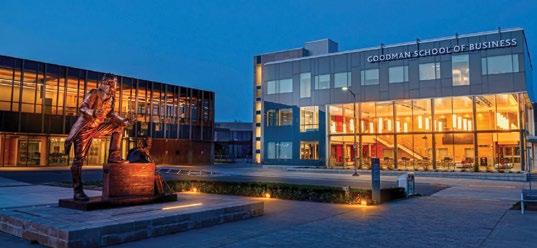
The Goodman School of Business budget supports efforts toward continuous improvement and expanding impact to fulfil not only Goodman, but also Brock’s Institutional Strategic Plan while continuing to work to address gaps identified through the Business School Impact System (BSIS). A key finding of the report is that Goodman contributes $380 million to the Niagara economy through direct, indirect and induced annual contributions. Our push toward continuous improvement has resulted in the re-accreditation of our MBA-CPA program through CPA Ontario and international recognition and accreditation of our Bachelor of Business Administration International Double Degree from the European Foundation for Management Development (EFMD). In addition, we continue to serve our community with professional development, venture development, consulting services and the bi-weekly Business Breathers webinar series through Goodman Group, one of the services the BSIS report repeatedly praised for its impact on the community. Goodman holds an annual Business Matters panel discussion series, with recent topics focusing on Equity, Diversity and Inclusion, and Sustainability. While working with the Office of the Vice-Provost of Indigenous Engagement, Goodman established the annual Indigenous Leader Speaker Series to coincide with National Indigenous Peoples Day. Visit brocku.ca/goodman

Note: Revenue includes $0.45 million ($0.86 million in 2022-23) of program revenue related to Goodman’s professional and executive programs as well as consulting revenue. See Figure 66-B for a breakdown of operating expenses by type.
(1) Full-time equivalent (FTE) faculty/librarians represents Brock University Faculty Association (BUFA) probationary and tenured faculty and Associate Deans (both filled and unfilled positions). LTA/ILTA represents BUFA limited-term and instructional limited-term faculty appointments. Faculty on sabbatical are represented as one FTE.
(2) FTE – staff represents evaluated salaried staff positions and ongoing CUPE 1295 positions (both filled and unfilled).
(3) See Figure 13 in 'The Big Picture' pullout for explanation of the figures reported.
(4) See Figure 14 in ‘The Big Picture’ pullout for explanation of the figures reported.
*Note: BUFA positions, BUFA overload and Associate Deans.
45
($000s) 2023-24 Budget 2022-23 Budget 2021-22 Actual Revenue 962 1,372 729 Personnel costs (27,239) 91.9% (28,907) 90.7% (27,913) 92.2% Operating costs (2,389) 8.1% (2,947) 9.3% (2,361) 7.8% Total costs (29,628) 100% (31,854) 100% (30,274) 100% Net (28,666) (30,482) (29,545) FTE – faculty (1) 80.9 82.2 FTE – LTA/ILTA faculty (1) 12.6 14.0 FTE – staff (2) 41.4 44.6 Purchased services Marketing and advertising Funding of professional expense reimbursement (PER) accounts Other operating costs Repair and maintenance and capital replacement Funding of project accounts Travel Scholarships and student awards 43 13 10 11 8 6 4 5
2023-24 Budget 2022-23 Actual 2021-22 Actual 2020-21 Actual Undergraduate average class size Overall 49.7 45.5 50.0 Year 1 61.8 59.4 59.9 Year 2 61.4 55.8 64.1 Year 3 39.8 38.9 41.4 Year 4 37.5 32.8 35.7 Headcount by major (3) 3,055 3,173 3,368 3,415 FTE by major (4) Undergraduate 2,828 3,017 3,089 Graduate 580 601 615 Source: Institutional Planning, Analysis and Performance Faculty* Admin/professional CUPE 4207 – Unit 1 OSSTF SAC Non-union instructors Other 1.6 10.0 3.7 1.3 82.9 0.2 0.3
Figure 66-A
Figure 66-C
Figure 66-B: 2023-24 Operating costs (%)
Figure 66-D: 2023-24 Budget personnel costs (including benefits) (%)
2023-24 Budget Report SNAPSHOTS
Faculty of Education
The Faculty of Education (FOE) is a leader in the delivery of academic programs related to learning and teaching across the lifespan. Our academic programs, scholarship and creative activities, and service, are recognized for their excellence and career orientation. We collaboratively offer Indigenous Education programs to support the educational and professional formation of teachers in remote communities and university education pathways for Indigenous adults in communities across Ontario. Our outstanding accredited Teacher Education programs respond to the needs of Ontario's boards of education including in the much-needed fields of technological education. Adult Education and Early Childhood Education (ECE) are Brock leaders as fully online programs, drawing in diverse student populations and professionals to complete a university degree while maintaining employment and family responsibilities. While the Early Childhood Education (ECE) program is a degree completion pathway for ECE educators across Ontario and beyond, our advanced certificates and micro-certificates feature Canadian Culture and Education, Leadership in Community-based Education, literacy, and post-secondary education. Our graduate (MEd, PhD) programs provide rigorous academic and professional education for teachers and school, university, college, community, and industry leaders. Visit brocku.ca/education
Note: Revenue includes $1.29 million ($1.49 million in 2022-23) of student fees related to Continuing Teacher Education and Adult Education. See Figure 67-B for a breakdown of operating expenses by type.
Other operating costs
Funding of professional expense reimbursement (PER) accounts
Repair and maintenance and capital replacement
Purchased services
Travel
Marketing and advertising
Scholarships and student awards
Funding of project accounts
(1) Full-time equivalent (FTE) faculty/librarians represents Brock University Faculty Association (BUFA) probationary and tenured faculty and Associate Deans (both filled and unfilled positions). LTA/ILTA represents BUFA limited-term and instructional limited-term faculty appointments. Faculty on sabbatical are represented as one FTE.

(2) FTE – staff represents evaluated salaried staff positions and ongoing CUPE 1295 positions (both filled and unfilled).

(3) See Figure 13 in 'The Big Picture' pullout for explanation of the figures reported.
(4) See Figure 14 in ‘The Big Picture’ pullout for explanation of the figures reported.
*Note: BUFA positions, BUFA overload and Associate Deans.
30 30 8 11 11 1 5 4
($000s) 2023-24 Budget 2022-23 Budget 2021-22 Actual Revenue 2,077 1,771 1,596 Personnel costs (19,607) 96.8% (18,988) 96.9% (18,324) 97.4% Operating costs (647) 3.2% (616) 3.1% (484) 2.6% Total costs (20,254) 100% (19,604) 100% (18,808) 100% Net (18,177) (17,833) (17,212) FTE – faculty (1) 43.0 46.3 FTE – LTA/ILTA faculty (1) 11.0 11.5 FTE – staff (2) 38.8 40.2
Figure 67-A
2023-24 Budget 2022-23 Actual 2021-22 Actual 2020-21 Actual Undergraduate average class size Overall 47.2 49.4 45.6 Year 1 51.8 55.7 79.2 Year 2 26.7 29.4 28.2 Year 3 52.9 60.2 44.4 Year 4 53.8 49.5 48.0 Headcount by major (3) 1,859 1,792 1,895 1,920 FTE by major (4) Undergraduate 1,677 1,701 1,599 Graduate 127 162 168 Source: Institutional Planning, Analysis and Performance Faculty* Non-union instructors Admin/professional OSSTF CUPE 4207 – Unit 1 SAC Other 9.9 3.3 2.3 5.3 27.5 49.7 2.0
Figure 67-C
Figure 67-B: 2023-24 Operating costs (%)
46 2023-24 Budget Report SNAPSHOTS
Figure 67-D: 2023-24 Budget personnel costs (including benefits) (%)
Faculty of Humanities
The world has changed utterly in the past few years, and those changes have been most apparent in their impact on the lives and spirits of individual human beings. That's where the Humanities come in. Our researchers and creative practitioners examine the cultural, historical, and intellectual frameworks of the world and the human experience, and have significant impact both locally and internationally. We work on figuring out what really happened or is happening, how we can know, and what we can do about it.
We are the very embodiment of the Institutional Strategic Plan: our students have an experience unparalleled in Ontario universities, both in the classroom and beyond, as they engage with the world and consider how to improve it. We enhance the life of our community through creative performances, exhibits and intellectual events; and we actively pursue inclusion and accessibility through our teaching, research, creative activity and service. Along the way, as well, we help inoculate against “Fake News” and extremism by fostering a respect for rigour and truth in our teaching, scholarship and creative activity. Visit brocku.ca/humanities/
Note: Revenue includes $0.54 million ($0.53 million in 2022-23) of spending allocations from the Marilyn I. Walker School of Fine and Performing Arts Endowment Fund . See Figure 68-B for a breakdown of operating expenses by type.
Funding of professional expense reimbursement (PER) accounts
Purchased services
Other operating costs Materials and supplies
Funding of project accounts Repair and maintenance and capital replacement Travel


(1) Full-time equivalent (FTE) faculty/librarians represents Brock University Faculty Association (BUFA) probationary and tenured faculty and Associate Deans (both filled and unfilled positions). LTA/ILTA represents BUFA limited-term and instructional limited-term faculty appointments. Faculty on sabbatical are represented as one FTE.
(2) FTE – staff represents evaluated salaried staff positions and ongoing CUPE 1295 positions (both filled and unfilled).
(3) See Figure 13 in 'The Big Picture' pullout for explanation of the figures reported.
(4) See Figure 14 in ‘The Big Picture’ pullout for explanation of the figures reported.
*Note: BUFA positions, BUFA overload and Associate Deans.
47
($000s) 2023-24 Budget 2022-23 Budget 2021-22 Actual Revenue 626 593 546 Personnel costs (22,672) 96.2% (22,964) 96.5% (22,370) 96.8% Operating costs (898) 3.8% (827) 3.5% (745) 3.2% Total costs (23,570) 100% (23,791) 100% (23,115) 100% Net (22,944) (23,198) (22,569) FTE – faculty (1) 89.7 88.7 FTE – LTA/ILTA faculty (1) 3.2 3.8 FTE – staff (2) 28.4 29.9 Other SAC Non-union instructors Faculty* CUPE 4207 – Unit 1 Admin/professional OSSTF 74 6 4.4 14.7 1.1 3.4 0.2 74.2 2.0
Figure 68-A
2023-24 Budget 2022-23 Actual 2021-22 Actual 2020-21 Actual Undergraduate average class size Overall 34.5 32.3 32.8 Year 1 68.4 67.3 63.9 Year 2 34.3 31.4 32.7 Year 3 21.5 19.2 19.3 Year 4 12.7 10.4 11.3 Headcount by major (3) 1,985 1,968 1,914 1,885 FTE by major (4) Undergraduate 1,794 1,717 1,688 Graduate 54 60 60 Source: Institutional Planning, Analysis and Performance
Figure 68-C
6 6
44 21 10 10
3
Figure 68-B: 2023-24 Operating costs (%)
2023-24 Budget Report SNAPSHOTS
Figure 68-D: 2023-24 Budget personnel costs (including benefits) (%)
Faculty of Mathematics and Science

The Faculty of Mathematics and Science (FMS) develops and delivers programs (many with a co-op option) and courses to provide knowledge and hands-on experiences that serve as a strong foundation for its students. FMS aligns with the Institutional Strategic Plan in many ways, especially by fostering a culture that focuses on multidisciplinary and transdisciplinary approaches (as seen in Neuroscience, Biotechnology, etc.); being a leader in bringing in funding from a wide range of sources to support research infrastructure and capacity; and having researchers' work in a wide range of areas with local and global impact, from pharmaceutical development to grape and wine innovation. FMS is also home to the Yousef Haj-Ahmad Department of Engineering. Brock is slated to be one of only three Universities in Canada to offer integrated Engineering by Fall 2024 (subject to Government approval), an approach to engineering education that addresses emerging needs and challenges in the engineering field. Visit brocku.ca/mathematics-science

Note: Revenue includes $1.59 million ($1.56 million in 2022-23) of funding from strategic funds for Engineering and $0.09 million ($0.23 million in 2022-23) funding related to Canada Research Chairs (shown as inter-fund revenue).
See Figure 69-B for a breakdown of operating expenses by type.
(1) Full-time equivalent (FTE) faculty/librarians represents Brock University Faculty Association (BUFA) probationary and tenured faculty and Associate Deans (both filled and unfilled positions). LTA/ILTA represents BUFA limited-term and instructional limited-term faculty appointments. Faculty on sabbatical are represented as one FTE.
(2) FTE – staff represents evaluated salaried staff positions and ongoing CUPE 1295 positions (both filled and unfilled).
(3) See Figure 13 in 'The Big Picture' pullout for explanation of the figures reported.
(4) See Figure 14 in ‘The Big Picture’ pullout for explanation of the figures reported.
*Note: BUFA positions, BUFA overload and Associate Deans.
48
2023-24 Budget Report SNAPSHOTS Repair and maintenance and capital replacement Funding of professional expense reimbursement (PER) accounts Materials and supplies Other operating costs Purchased services Funding of project accounts Travel Scholarships and student awards 35 22 16 6 4 5 3 9
2023-24 Budget 2022-23 Actual 2021-22 Actual 2020-21 Actual Undergraduate average class size Overall 86.2 83.9 94.9 Year 1 224.1 220.9 243.6 Year 2 48.7 47.7 58.0 Year 3 30.4 32.8 33.9 Year 4 21.1 20.8 24.2 Headcount by major (3) 2,473 2,420 2,420 2,449 FTE by major (4) Undergraduate 2,092 2,107 2,174 Graduate 183 177 163 Source: Institutional Planning, Analysis and Performance Faculty* Admin/professional CUPE 4207 – Unit 1 OSSTF SAC Other 74 6 16.2 1.8 66.9 0.1 12.4 2.6
Figure
69-C
Figure 69-B: 2023-24 Operating costs (%)
Figure 69-D: 2023-24 Budget personnel costs (including benefits) (%)
($000s) 2023-24 Budget 2022-23 Budget 2021-22 Actual Revenue 1,803 2,670 710 Personnel costs (24,817) 95.6% (24,268) 96.0% (21,915) 94.9% Operating costs (1,129) 4.4% (1,022) 4.0% (1,171) 5.1% Total costs (25,946) 100% (25,290) 100% (23,086) 100% Net (24,143) (22,620) (22,376) FTE – faculty (1) 81.0 79.8 FTE – LTA/ILTA faculty (1) 5.0 4.3 FTE – staff (2) 55.8 51.8
Figure 69-A
Faculty of Social Sciences
Brock’s largest Faculty offers cutting-edge programs and diverse experiential learning opportunities, providing students with opportunities to push boundaries while developing the tools required to succeed in an ever-changing world. Home to both new and emerging fields of study, including environmental sustainability, politics, economics, psychology, labour studies, communication theory and business communications, applied disability studies, child and youth studies, social justice, applied linguistics, popular culture and film studies, geography and tourism, gender studies, and sociology, the Faculty of Social Sciences prepares students for multiple career paths. An emphasis on understanding complex phenomena through a variety of lenses helps students become innovative, engaged citizens ready to tackle the problems that matter most to them. Highlights of our strategic investments that promote institutional priorities include certificate program development; enhanced course offerings in blended, online and accelerated formats; and additional cohorts in professional accreditation programs. These initiatives increase accessibility for part-time students, provide opportunities for adult learners and promote community outreach. Visit brocku.ca/social-sciences/

Note: Revenue includes $0.35 million ($0.31 million in 2022-23) funding related to Canada Research Chairs (shown as inter-fund revenue). See Figure 70-B for a breakdown of operating expenses by type.
(1) Full-time equivalent (FTE) faculty/librarians represents Brock University Faculty Association (BUFA) probationary and tenured faculty and Associate Deans (both filled and unfilled positions). LTA/ILTA represents BUFA limited-term and instructional limited-term faculty appointments. Faculty on sabbatical are represented as one FTE.
(2) FTE – staff represents evaluated salaried staff positions and ongoing CUPE 1295 positions (both filled and unfilled).

(3) See Figure 13 in 'The Big Picture' pullout for explanation of the figures reported.
(4) See Figure 14 in ‘The Big Picture’ pullout for explanation of the figures reported.
*Note: BUFA positions, BUFA overload and Associate Deans.
49
2023-24 Budget 2022-23 Actual 2021-22 Actual 2020-21 Actual Undergraduate average class size Overall 72.1 73.1 75.3 Year 1 227.7 233.6 226.4 Year 2 97.4 98.3 105.2 Year 3 45.6 49.7 49.9 Year 4 24.5 21.4 21.2 Headcount by major (3) 5,360 5,348 5,362 5,543 FTE by major (4) Undergraduate 4,565 4,599 4,828 Graduate 399 409 412 Source: Institutional Planning, Analysis and Performance Funding of professional expense reimbursement (PER) accounts Other operating costs Scholarships and student awards Purchased services Funding of project accounts Repair and maintenance and capital replacement Travel Internal chargeback expense 49 11 10 8 7 6 2 7 Faculty* CUPE 4207 – Unit 1 Admin/professional OSSTF SAC 6 74 7 5.3 14.9 0.7 2.8 76.3
Figure 70-C
Figure 70-B: 2023-24 Operating costs (%)
2023-24 Budget Report SNAPSHOTS Figure 70-A ($000s) 2023-24 Budget 2022-23 Budget 2021-22 Actual Revenue 398 644 482 Personnel costs (38,486) 97.3% (39,448) 97.5% (38,397) 97.4% Operating costs (1,082) 2.7% (1,032) 2.5% (1,025) 2.6% Total costs (39,568) 100% (40,480) 100% (39,422) 100% Net (39,170) (39,836) (38,940) OG FTE – faculty (1) 155.8 154.0 FTE – LTA/ILTA faculty (1) 7.5 11.1 OG FTE – staff (2) 43.1 43.5
Figure 70-D: 2023-24 Budget personnel costs (including benefits) (%)
Academic support
Faculty of Graduate Studies
Figure 71
(1) Full-time equivalent (FTE) faculty/librarians represents Brock University Faculty Association (BUFA) probationary and tenured faculty and Associate Deans (both filled and unfilled positions). LTA/ILTA represents BUFA limited-term and instructional limited-term faculty appointments. Faculty on sabbatical are represented as one FTE.
(2) FTE – staff represents evaluated salaried staff positions and ongoing CUPE
Brock embraces integrative graduate education as a pathway to independence and a breadth of career options built on a foundation of collegial mentorship, collaboration, transparency and merit. Accordingly, our 52 graduate programs embrace contemporary issues, highlighting and pushing the boundaries of current thought, ongoing progress, and future developments across and between disciplines. The Faculty of Graduate Studies (the Faculty) has a critical role in meeting the Institutional Strategic Plan’s goal to build research capacity across the University, thereby positioning Brock as a key comprehensive university for the 21st century.
The Faculty is the centralized administrative and academic entity for the University’s graduate programs and therefore operates across all Faculties and is intimately involved in integrative recruitment and retention efforts for both undergraduate and graduate levels. The Faculty aligns with the Institutional Strategic Plan by ensuring these initiatives encourage inclusivity, accessibility, reconciliation and decolonization.
The Faculty oversees all graduate applications, admissions and registration, ongoing enrolment and records, funding, internal and external graduate scholarships and awards, and graduate student essential skills and professional development programming.

In collaboration with Brock’s Graduate Council and the Senate Graduate Studies Committee, the Faculty ensures the development and enforcement of all relevant rules, regulations and policies concerning graduate studies. In collaboration with the Graduate Students’ Association, the Faculty also advocates for graduate student needs and issues on campus. In alignment with the Institutional Strategic Plan, the Faculty hopes to offer a transformational and accessible academic and university experience to our graduate students, and enhance the life and vitality of our local region and beyond. For more information, visit brocku.ca/graduate-studies
Note: Revenue includes $0.39 million ($0.42 million in 2022-23) from the Ontario University Application Centre.
50
2023-24 Budget Report SNAPSHOTS
($000s) 2023-24 Budget 2022-23 Budget 2021-22 Actual Revenue 446 460 449 Personnel costs (1,950) 92.1% (1,749) 90.7% (1,487) 89.4% Operating costs (168) 7.9% (180) 9.3% (176) 10.6% Total costs (2,118) 100% (1,929) 100% (1,663) 100% Net (1,672) (1,469) (1,214) FTE – faculty (1) 1.0 1.0 FTE – staff (2) 20.0 16.6
(1) Full-time equivalent (FTE) faculty/librarians represents Brock University Faculty Association (BUFA) probationary and tenured faculty and Associate Deans (both filled and unfilled positions). LTA/ILTA represents BUFA limitedterm and instructional limited-term faculty appointments. Faculty on sabbatical are represented as one FTE.
(2) FTE – staff represents evaluated salaried staff positions and ongoing CUPE 1295 positions (both filled and unfilled).
The Brock University Library enriches teaching, learning and research at Brock through collaborative expertise, rich content and inclusive spaces. The Library supports student success by providing the competencies, tools and resources that learners need to excel in a changing environment; advances knowledge by providing access to scholarly information and through active engagement in the research lifecycle; and inspires discovery by fostering creative engagement with technology. The Brock University Library includes the
James A. Gibson Library; the Map, Data and GIS Library; the Archives and Special Collections; and the Makerspace in the Rankin Family Pavilion. The Library comprises six departments and a staff of 50, of whom 20 are professional librarians. The Brock Library's strategic plan has four strategic pillars highlighting student success; the research lifecycle; community engagement; and strengthening capacity. For more information, visit brocku.ca/library

51
2023-24 Budget Report SNAPSHOTS Figure 72-A ($000s) 2023-24 Budget 2022-23 Budget 2021-22 Actual Revenue 8 125 199 Personnel costs (5,470) 47.2% (5,492) 48.3% (5,125) 47.7% Operating costs (6,131) 52.8% (5,871) 51.7% (5,623) 52.3% Total costs (11,601) 100% (11,363) 100% (10,748) 100% Net (11,593) (11,238) (10,549) FTE – faculty (1) 19.0 19.0 FTE – LTA/ILTA faculty (1) 1.0 1.0 FTE – staff (2) 30.2 30.1
Library
50 50 Operating Acquistions
Figure 72-B: 2023-24 total costs by cost centre (%)
Research Enterprise
Figure 73-A
FTE – staff represents evaluated salaried staff positions and ongoing CUPE 1295 positions (both filled and unfilled).
The Research Enterprise includes the Office of Research Services (ORS), Animal Care Services (ACS), the Office of Research Ethics (ORE), the Brock LINC innovation and entrepreneurship hub, and funding for transdisciplinary research and activities, including the Cool Climate Oenology and Viticulture Institute (CCOVI). (Note: Costs related to the Office of the Vice-President, Research are included in the Senior Academic and Administration Team responsibility centre.)
The Research Enterprise supports Brock’s strategic priority of advancing research capacity across the University. The Research Enterprise units continuously strive to enhance service to researchers and the broader community by identifying opportunities for improving process efficiencies and reducing timelines. The 2023-24 budget includes measures to improve operations through personnel and software advancements, including a focus on guiding research policies and practices through the lens of Equity, Diversity and Inclusion. The Research Enterprise provides a focal point for funders, industry, community groups and researchers to connect and continue to increase awareness of Brock University as a centre of research excellence.
The Brock LINC aims to foster a culture of creativity and innovation, grow entrepreneurship, and support research innovation and capacity at the University. Programs and services support users through the innovation journey. For more information, visit brocku.ca/linc/
CCOVI is Brock’s flagship transdisciplinary institute. It defines a place within and beyond the University for research and networking to advance the Canadian grape and wine industry. Faculty, students, and staff partner with academic communities, federal and provincial government research organizations, and regional grape and wine industry groups across Canada, as well as cool climate wine regions around the world. For information about CCOVI, visit brocku.ca/ccovi
Brock continues to support several other transdisciplinary research institutes, including Brock–Niagara Validation, Prototyping and Manufacturing Institute (VPMI); Canada–Caribbean Institute; Institute for Lifespan Development Research; Niagara Community Observatory; and Social Justice Research Institute. Find out more at brocku.ca/research-atbrock/institutes-and-centres/
Note: Revenue includes $2.50 million of grant revenue related to the Research Support Fund ($2.28 million in 2022-23). Operating costs include $1.16 million of funding for research support through VPR Research Excellence, Chancellor’s Chair, Match of Minds and other programs ($1.16 million in 2022-23), $1.0 million of funding for start-up funds and related costs for new faculty members and librarians ($1.15 million in 202223), and $0.34 million of funding for CCOVI ($0.34 million in 2022-23).
Faculty 5 8 8
Funding 10
Animal
O
O 37 15 17
52 2023-24 Budget Report SNAPSHOTS
($000s) 2023-24 Budget 2022-23 Budget 2021-22 Actual Revenue 3,648 3,977 2,504 Personnel costs (3,213) 47.8% (2,831) 42.9% (2,259) 34.0% Operating costs (3,514) 52.2% (3,775) 57.1% (4,391) 66.0% Total costs (6,727) 100% (6,606) 100% (6,650) 100% Net* (3,079) (2,629) (4,146) FTE – staff (1) 32.0 29.3 (1)
* The above costs do not reflect the direct revenue or expenses of research, nor do they reflect the research portion of Faculty members’ salary and benefits (typically 40 per cent) and other overhead-related
costs. Faculty members’ salary and benefits are reflected in the teaching Faculties.
ce of Research Services
of internal research grants
Start-up, recruitment, relocation
Care Services CCOVI Brock LINC
ORS staff assist researchers in crafting grant proposals, administering contracts and funding, and providing support for commercialization and intellectual property management. A major portion of the ORS budget is devoted to internal funding for research activities. ORE supports research involving humans and ACS supports research involving animals. For information about these offices, visit brocku.ca/research ce of Research Ethics
Figure 73-B: 2023-24 total costs by cost centre (%)
Centre for Pedagogical Innovation
Professional and Continuing Studies and ESL
(1) FTE – staff represents evaluated salaried staff positions and ongoing CUPE 1295 positions (both filled and unfilled).
The Centre for Pedagogical Innovation (CPI), as defined in the 2023-24 budget, includes teaching and learning advancement and online learning.
CPI fosters a culture of excellence in teaching and learning across the University through supporting instructional staff and critical digital infrastructure.
CPI brings people together to explore effective teaching and learning practices, as well as innovative pedagogies, both in the classroom and online. CPI also assists departments and instructors in the design, development, and delivery of courses and programs.

For more information, visit brocku.ca/pedagogical-innovation/
Professional and Continuing Studies (PCS) supports one of the Institutional Strategic Plan’s goals of ‘Expanding Brock’s lifelong learning opportunities for our students and members of the community.’ This includes flexible and inclusive courses and program delivery formats, expanding and formalizing responsibilities for lifelong learning such as part-time degree offerings and professional development opportunities, and creating initiatives that further skills for working professionals (micro credentialing) and offer learning opportunities for older adults. For information about PCS, visit brocku.ca/continuing-education
ESL supports the Institutional Strategic Plan and Brock’s goals for internationalization. ESL Services is a path for international students and those with English as an Additional Language (EAL) to gain essential language skills, which facilitates their successful participation in Brock’s undergraduate programs. For information on ESL Services, visit brocku.ca/esl-services
Note: Included in revenue is $1.7 million of strategic funding to offset the start-up costs of PCS ($1.5 million in 2022-23). Also included is $1.5 million of funding from the contingency reserve (reported in University Global) to support ESL. The expectation is that ESL will generate this net contribution in 2024-25.
53
74 ($000s) 2023-24 Budget 2022-23 Budget 2021-22 Actual Revenue 279 68 38 Personnel costs (1,246) 97.2% (954) 96.5% (926) 96.1% Operating costs (36) 2.8% (35) 3.5% (38) 3.9% Total costs (1,282) 100% (989) 100% (964) 100% Net (1,003) (921) (926) FTE – staff (1) 12.5 11.0
Figure
51 49 Professional and Continuing Studies English as a Subsequent Language (ESL)
Figure 75-B: 2023-24 total costs by cost centre (%) ($000s) 2023-24 Budget 2022-23 Budget 2021-22 Actual Revenue 3,728 2,556 618 Personnel costs (2,275) 68.5% (1,810) 72.1% (918) 89.6% Operating costs (1,048) 31.5% (701) 27.9% (106) 10.4% Total costs (3,323) 100% (2,511) 100% (1,024) 100% Net 405 45 (406) FTE – staff (1) 20.7 15.6
Figure 75-A
2023-24 Budget Report SNAPSHOTS
(1) FTE – staff represents evaluated salaried staff positions and ongoing CUPE 1295 positions (both filled and unfilled).
Student specific
Office of the Registrar and Enrolment Services
maintaining the integrity of the University’s student academic record. For information on the Office of the Registrar, visit brocku.ca/registrar

Note: Revenue includes $1.50 million ($1.45 million in 2022-23) from the Ontario Universities' Application Centre and $0.25 million ($0.26 million in 2022-23) in grant revenue related to the Credit Transfer Institutional Grant. Operating costs include $1.50 million ($1.53 million in 2022-23) of contracted services mainly related to international student recruitment commissions.
The Office of the Registrar and Enrolment Services (ORES) supports the Institutional Strategic Plan by providing a wide range of enrolment services that include national and international recruitment, admissions, front-line services (Brock Central), central academic advising, registration, curriculum management support, maintenance and enhancement of the student information system, scheduling of timetables and examinations, grade reporting, academic adjudication and degree audit, student transfers and articulation agreements, and Convocation. It issues official academic documents and is responsible for
54 2023-24 Budget Report SNAPSHOTS
Figure
($000s) 2023-24 Budget 2022-23 Budget 2021-22 Actual Revenue 2,719 2,496 2,974 Personnel costs (6,026) 65.5% (6,020) 65.4% (5,133) 66.0% Operating costs (3,179) 34.5% (3,185) 34.6% (2,642) 34.0% Total costs (9,205) 100% (9,205) 100% (7,775) 100% Net (6,486) (6,709) (4,801) FTE – staff (1) 71.8 74.4
76-A
(1) FTE – staff represents evaluated salaried staff positions and ongoing CUPE 1295 positions (both filled and unfilled).
46 27 22 32
O ce of The Registrar International Student Recruitment Student Recruitment Credit Transfer Convocation
Figure 76-B: 2023-24 total costs by cost centre (%)
Student Wellness and Accessibility
The team at the Student Wellness and Accessibility Centre (SWAC) are driven by the vision of health, wellness and personal success for all students. The team consists of Student Health, Health Promotion, Counselling and Accessibility Services. Our unit supports the Institutional Strategic Plan by supporting a transformational and accessible academic and university experience; enhancing the life and vitality of our local region and beyond through community partnerships; and fostering a culture of inclusivity, accessibility, reconciliation and decolonization. Operations are supported through grants from BUSU, GSA, MCU and the Niagara Community Foundation. For more information, visit brocku.ca/health-wellness-accessibility
Student Health Services offers a diverse range of health-care services. Primary care is available to students at the main campus in two locations –Campus Pharmacy and Harrison Hall, as well as Marilyn I. Walker School of Fine and Performing Arts and the Hamilton/Burlington campus; services include physical exams, sexual and reproductive health, first aid for injuries, mental health, wellness counselling, injections, prescriptions, COVID vaccinations and referrals to other health professionals and services.
Student Accessibility Services supports students with disabilities and medical conditions (physical and mental), as well as learning and sensory disabilities during their time at the University. Staff work with students to develop individualized accommodation plans based on documented disability-related needs. They also provide individualized and group support to build students’ self-advocacy skills and learning strategies in keeping with their strengths.
Personal Counselling Services offers students individual, group and crisis counselling. These services are provided by professional therapists employed by Brock as well as contracted through purchase of services agreements with LifeWorks (formerly Morneau Shepell), Canadian Mental Health Association of Niagara and Community Addiction Services of Niagara. Students can also access intensive supports through our From Intention to Action (FITA) program.
The Health Promotion team provides information, programming and outreach for students in important aspects of student life, such as stress management, healthy relationships and physical and mental wellness.
Note: Revenue includes $1.28 million ($1.15 million in 2022-23) of student ancillary fees and $1.10 million ($1.04 million in 2022-23) of grant revenue related to a number of MCU grants, including the Access Fund for Students with Disabilities. Operating costs include $1.27 million ($1.21 million in 2022-23) of professional fees and contracted services, including physicians and counselling services.

($000s) 2023-24 Budget 2022-23 Budget 2021-22 Actual Revenue 3,281 3,017 3,750 Personnel costs (4,096) 72.3% (4,121) 74.7% (3,266) Operating costs (1,566) 27.7% (1,399) 25.3% (2,044) 38.5% Total costs (5,662) 100% (5,520) 100% (5,310) 100% Net (2,381) (2,503) (1,560) FTE – staff (1) 45.9 46.2
Figure 77-A
(1) FTE – staff represents evaluated salaried staff positions and ongoing CUPE 1295 positions (both filled and unfilled).
Student Accessibility Services Health Services Personal Counselling Health Promotion Student Wellness and Accessibility Administration 38 35 20 3 4 55 2023-24 Budget Report SNAPSHOTS
Figure 77-B: 2023-24 total costs by cost centre (%)
Student Life and Success
Student Affairs is committed to providing a safe living and learning environment that promotes student success. The Student Affairs team is responsible for overseeing several policies and services, including supporting students-at-risk, administering the Student Code of Conduct and offering mediation services.
Faith and Life provides opportunities for friendship, education, spiritual counselling and personal growth.
For more information, visit brocku.ca/student-life-success
Student Life and Success (SLS) is comprised of Student Life, Student Affairs, Learning Services, and Faith and Life. Our department supports the Institutional Strategic Plan by offering programming and services that support student success both academically and outside the classroom.
Student Life offers programs and services that support student success through co-curricular learning activities, campus involvement, leadership development, community engagement and off-campus living.
Learning Services supports Brock students with a broad range of academic challenges as they transition to and progress through their university life. Workshops and drop-in services are available throughout the year to help students with time management, note-taking, writing, math and science, exam preparation and more.
Note: Revenue includes $0.31 million ($0.23 million in 2022-23) of grant revenue related to the Ontario PostSecondary Access and Inclusion Program.

($000s) 2023-24 Budget 2022-23 Budget 2021-22 Actual Revenue 768 666 216 Personnel costs (1,892) 83.3% (1,832) 83.1% (1,589) 88.7% Operating costs (379) 16.7% (373) 16.9% (203) 11.3% Total costs (2,271) 100% (2,205) 100% (1,792) 100% Net (1,503) (1,539) (1,576) FTE – staff (1) 20.0 18.0
Figure 78-A
(1) FTE – staff represents evaluated salaried staff positions and ongoing CUPE 1295 positions (both filled and unfilled).
85 2 13
Student Life and Learning Services Student A airs Faith And Life
56 2023-24 Budget Report SNAPSHOTS
Figure 78-B: 2023-24 total costs by cost centre (%)
Brock International
Hadiyaˀdagénhahs First Nations, Métis and Inuit Student Centre
(1) FTE –staff represents evaluated salaried staff positions and ongoing CUPE 1295 positions (both filled and unfilled).
Brock International supports the Institutional Strategic Plan through the facilitation of strategic global partnerships and support services for Brock students and scholars.
Brock International Services is responsible for:


• Provision of programs, activities and services that support student well-being, success, career transition, settlement, and immigration that are specifically tailored to the needs of the international student community
• Developing partnerships and agreements that increase Brock’s global reach and engagement
• Increasing access to global learning opportunities for students and scholars through exchange, mobility programs and international co-operation
• Fostering a culture of inclusivity and community engagement
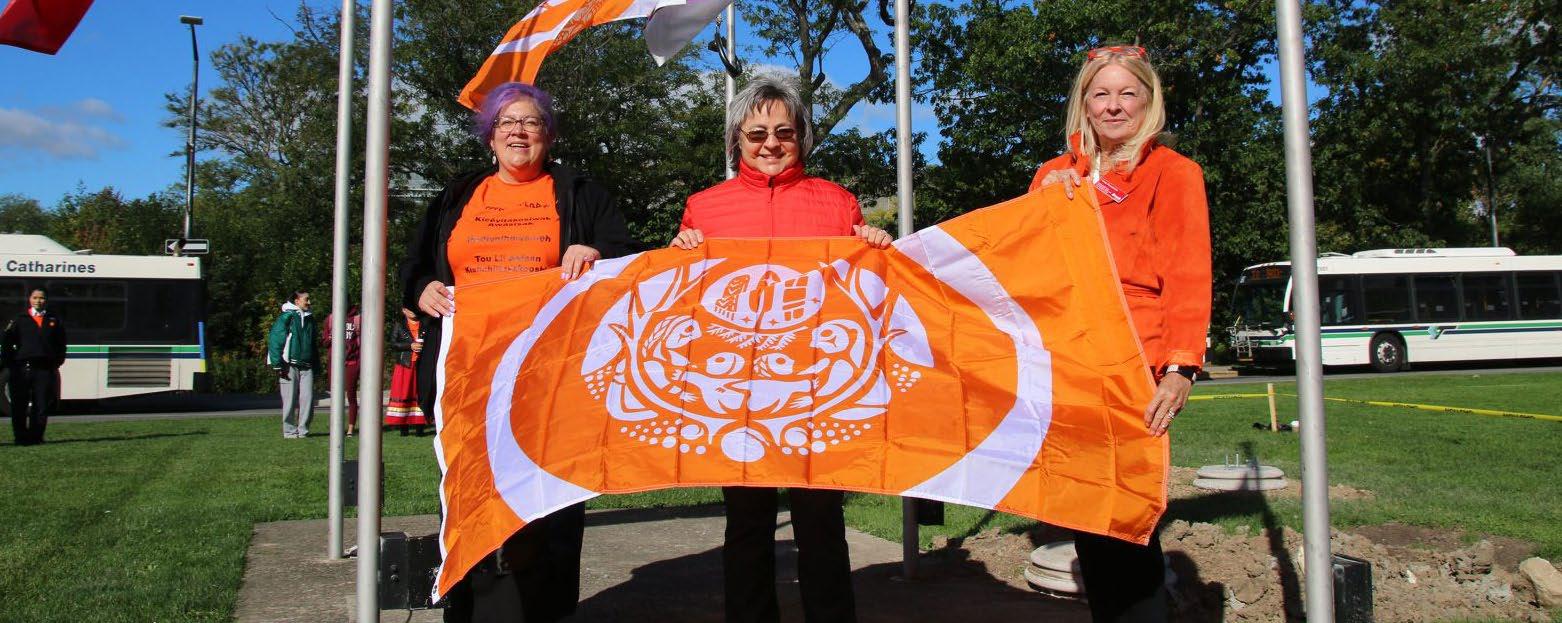
For more information on Brock International Student Services, visit brocku.ca/international/
(1) FTE – staff represents evaluated salaried staff positions and ongoing CUPE 1295 positions (both filled and unfilled).
The Hadiyaˀdagénhahs First Nations, Métis, and Inuit Student Centre (the Centre) is a space for all students to feel welcome. The Centre aids in cultural, social, and academic supports and is committed to maintaining and enhancing Indigenous students' cultural identity in an academic setting. The Centre's team, and many community partners, work collaboratively to ease the transition to university by providing a safe and supportive environment throughout the learning journey. For more information visit brocku.ca/hadiyadagenhahs
Note: Revenue includes $0.34 million ($0.34 million in 2022-23) of grant revenue related to the Indigenous Student Success Fund. Also included in revenue is $0.24 million of student ancillary fees, which were introduced in fall 2023.
57
Figure 79 ($000s) 2023-24 Budget 2022-23 Budget 2021-22 Actual Revenue 215 106 115 Personnel costs (1,726) 89.9% (1,588) 89.1%(1,014) 88.5% Operating costs (194) 10.1% (194) 10.9%(132)11.5% Total costs (1,920) 100% (1,782) 100%(1,146) 100% Net (1,705) (1,676) (1,031) FTE – staff (1) 18.1 15.3
Figure 80 ($000s) 2023-24 Budget 2022-23 Budget 2021-22 Actual Revenue 580 369 312 Personnel costs (454) 78.3% (339) 91.1%(256) 85.3% Operating costs (126) 21.7% (33)8.9% (44) 14.7% Total costs (580) 100% (372) 100%(300) 100% Net - (3) 12 FTE – staff (1) 5.5 4.0
2023-24 Budget Report SNAPSHOTS
Acting Vice-Provost, Indigenous Engagement Robyn Bourgeois, Phyllis Webstad, and Director of Hadiyaˀdagénhahs First Nations, Métis and Inuit Student Centre Cindy Biancaniello hold the Survivors’ Flag, which was raised during Webstad’s visit to Brock on Friday, Sept 23, 2022.
Co-op, Career and Experiential Education
Career Education offers career exploration and development information and resources to support students and alumni. In addition, Career Education provides employers and community members with information and services about on-campus recruiting and talent brand opportunities. Included in the Career Education unit is also Goodman Career Education.
Co-op, Career and Experiential Education (CCEE) supports the Institutional Strategic Plan and Strategic Mandate Agreement with the Ontario government. CCEE is the overarching department for student and new graduate employment, experiential education, and career development on campus –both for undergraduate and graduate students. The department consists of the following operational areas: Co-operative Education, Career Education (Campus and Goodman Career Education), and Experiential Education. A team of dedicated human resources, career development and experiential professionals work with students, employers, faculty, and community members to support their employment and/or experiential needs. For more information, visit brocku.ca/ccee
Co-operative Education offers a valuable opportunity for students to enhance their education by acquiring career-related work experience before graduation. Undergraduate and graduate students gain practical experience, develop a network of contacts and obtain a better understanding of careers in their field.

Experiential Education promotes faculty, staff, students and community partners working together to provide opportunities for students to apply their classroom learning through hands-on experience. Undergraduate and graduate students reflect on their experiences to build skills, realize competencies, and contribute to the community, to prepare for their careers and build beneficial connections. Experiential opportunities include internships, placements, field courses, service learning, labs and more, and are available in every Faculty at Brock.
Note: Revenue includes $2.02 million ($1.90 million in 2022-23) of co-op student fees. In addition, undergraduate co-operative education students pay tuition (applicable half-credit fee for each work term). However, like the Faculties, the revenue shown in the units does not include the allocation of Global tuition. Also included in revenue is $0.12 million of endowment funds from the Dr. Gerald B. Mitchell endowment fund.
58 2023-24 Budget Report SNAPSHOTS
Figure 81-A ($000s) 2023-24 Budget 2022-23 Budget 2021-22 Actual Revenue 2,572 2,419 2,338 Personnel costs (4,203) 90.9% (3,963) 91.1% (3,511) 84.8% Operating costs (422) 9.1% (388) 8.9% (631) 15.2% Total costs (4,625) 100% (4,351) 100% (4,142) 100% Net (2,053) (1,932) (1,804) FTE – staff (1) 47.0 44.6 (1) FTE – staff represents evaluated salaried staff positions and ongoing CUPE 1295 positions (both filled and unfilled).
Co-op Education Campus Career Education Co-op, Career and Experiential Education – Administration Experiential Education Centre of Excellence Goodman Career Education 37 21 14 12 6 10
Figure 81-B: 2023-24 total costs by cost centre (%)
Brock Sports and Recreation
Figure 82-A
(1) FTE – staff represents evaluated salaried staff positions and ongoing CUPE 1295 positions (both filled and unfilled).
Brock Sports takes a leadership role and engages the community through sporting events and activities, tournaments, community partnerships, and the Badgers Sports Camp programs. Badgers men’s and women’s teams provide more than 700 students with the opportunity to participate in OUA and USPORTS competitions. Brock Sports also runs the Brock Sports Performance Centre and the Brock Sports Medicine Clinic. For more information, visit gobadgers.ca
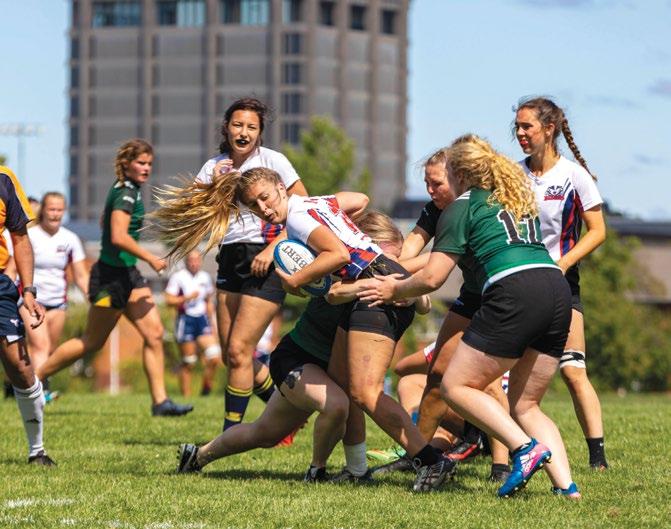

Brock Recreation provides programming for students including a wide variety of intramural activities, group and individual fitness programs, aquatics, open recreation opportunities, club sport programs for students and community, certification courses and leadership courses. The department also provides community-based programming, including all levels of aquatic programs (learn to swim through competitive club swimming and lifeguard training), camps and
programming for children and youth, school-based programs and community adult memberships for aquatics and fitness. Brock Recreation is committed to providing an inclusive, accessible, and respectful experience for all of its program participants, staff and volunteers. For information on programming, visit brocku.ca/recreation
Note: Revenue includes $3.76 million ($3.62 million in 2022-23) of student ancillary fees and $4.04 million ($2.53 million in 2022-23) of sales and services revenue, including program/activity and instructional fees related to school-based programs, Youth University camps, aquatics programs, other youth and community-based programming and intramurals, Badgers men’s and women’s teams, and Badgers Sports Camp programs. Operating costs include $0.31 million related to rental/ lease costs ($0.20 in 2022-23), included in this amount is rental costs for using Canada Games Park.
($000s) 2023-24 Budget 2022-23 Budget 2021-22 Actual Revenue 8,270 6,647 4,865 Personnel costs (6,316) 65.8% (5,491) 66.5% (4,112) 65.3% Operating costs (3,279) 34.2% (2,761) 33.5% (2,185) 34.7% Total costs (9,595) 100% (8,252) 100% (6,297) 100% Net (1,325) (1,605) (1,432) FTE – staff (1) 39.8 38.9
55
45 Brock Sports Brock Recreation
59 2023-24 Budget Report SNAPSHOTS
Figure 82-B: 2023-24 total costs by cost centre (%)
Ancillary
Ancillary Services
Ancillary Services is comprised of Residences, Dining Services and Brock Card, Campus Store, Parking Services, and Conference Services. Campus Development and Community Agreements, as well as Printing and Digital Services (described on pages 71 and 66 of this report) are also managed as part of Ancillary Services.
Ancillary Services aligns with the University strategic plan by offering a transformational and accessible academic and university experience. Its mission is to provide outstanding services that benefit the University community, with a vision of enhancing the University through engaged experiences. The four areas of focus are university customer experience, university contribution, quality products and services and people and partnerships.
The 2022-23 Fiscal Framework Update provided guidance for Ancillary operations to fully fund all capital improvements and additions, fund a deferred maintenance reserve, and grow their surplus contribution towards the University budget by four per cent each year. The global pandemic impacted Ancillary Services more than any other area within the University from a financial perspective. As the University recovers from the pandemic, the budgeted Ancillary and Residence contribution in the 202324 year will increase 66 per cent from the 2022-23 budget to $6.4 million. This budget also includes funding of the debt related to the Ancillary Services student experience project of $3.2 million. There remains risk to this budget related to enrolment as well as the future of hybrid academic and work models. The 2023-24 budget also provides funding of $0.29 million to increase Campus Safety Services resources for student residences.
Campus Store
The Campus Store manages the retail environment on campus as the primary retailer at Brock University. It includes everything from course materials, to your favourite Brock or Badger sweatshirt. The Campus Store is committed to leveraging the purchasing power of Brock to ensure it is providing affordable options that meet the needs of its customers. For more information, visit campusstore.brocku.ca
Note: Campus Store operating costs include $4.56 million ($4.67 million in 2022-23) of cost of sales.
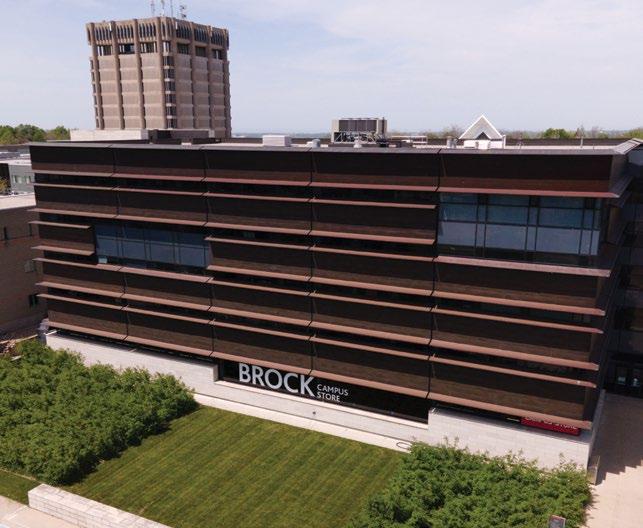
Conference Services
With an experienced team of conference co-ordinators, and facilities for every occasion, Brock Conference Services delivers exceptional experiences one event at a time. Focused on the customer experience, conference co-ordinators work with internal and external clients, making Brock University the ideal place to facilitate local, national and international conferences. For more information, visit brocku.ca/conference-services/
Parking Services
As the first touchpoint for many campus guests, Parking Services issues permits, manages parking pay systems, special event parking, parking lot enforcement, and ticket appeals on campus. Committed to excellent customer service, Parking Services works with partners across campus and local transit providers to ensure a positive, safe, and accessible experience for all customers travelling to campus. For more information, visit brocku.ca/parking-services/
Note: Parking Services operating costs include a $0.41-million ($0.40 million in 2022-23) contribution to the capital and related projects budget and $0.18 million ($0.18 million in 2022-23) of funding of debt payments related to the ancillary/residence student experience projects.
60 2023-24 Budget Report SNAPSHOTS
Dining Services and Brock Card
Valuing healthy, quality and convenient food options to fuel the mind, as well as special dietary needs, Dining Services operates eight locations, as well as catering and vending. Dining Services also manages all food and beverage contracts with external vendors and brings new brands to campus to meet the needs of today's students. Dining Services is committed to providing seamless and comprehensive services and choices, while supporting a healthy and sustainable university environment
The Brock Card is the official identification (ID) card for students, faculty and staff at the University. The Brock Card functions primarily as Brock ID and as a payment card on campus and with community partners. In addition, the Brock Card serves many other purposes, such as a campus recreation centre membership card, a transit card (when affixed with a current bus pass sticker), meal plan card, door access, and it is used to control access to specific areas/buildings on campus.
For more information, visit brocku.ca/dining-services/
Note: Dining Services and Brock Card operating costs include a $0.25-million contribution to the capital and related projects budget and $0.18 million ($0.18 million in 2022-23) of funding of debt payments related to the ancillary/residence student experience projects.

(1) FTE – staff represents evaluated salaried staff positions and ongoing CUPE 1295 positions (both filled and unfilled).
* Included in operating costs is cost of sales (COS.) Operating costs do not include allocated costs such as lighting, security, etc.
61
($000s) Campus Store Parking Services Conference and Event Services Dining Services and Brock Card AVP Ancillary Services Total Ancillary Operations 2023-24 Budget Revenue 6,500 4,655 1,217 3,461 15,833 Personnel costs (964) (532) (390) (424) (723) (3,033) Operating costs* (5,085) (984) (590) (1,970) (133) (8,762) Total costs (6,049) (1,516) (980) (2,394) (856) (11,795) Net 451 3,139 237 1,067 (856) 4,038 2022-23 Budget Revenue 6,615 3,729 697 3,143 14,184 Personnel costs (892) (470) (366) (420) (695) (2,843) Operating costs* (5,315) (997) (491) (1,838) (204) (8,845) Total costs (6,207) (1,467) (857) (2,258) (899) (11,688) Net 408 2,262 (160) 885 (899) 2,496 2021-22 Actual Revenue 6,223 3,390 (1) 2,751 12,363 Personnel costs (765) (229) (197) (357) (798) (2,346) Operating costs* (4,947) (744) (46) (1,652) (73) (7,462) Total costs (5,712) (973) (243) (2,009) (871) (9,808) Net 511 2,417 (244) 742 (871) 2,555 OG FTE – Staff (1) Budget 2023-24 8.9 4.9 4.0 3.6 7.0 28.4 Budget 2022-23 7.9 3.4 3.6 3.6 7.0 25.5
Figure
83
2023-24
SNAPSHOTS
Budget Report
Residences

Brock University is home to nearly 2,800 students during the academic year. In total, there are eight on-campus buildings that offer traditional, townhouse and semi-suite housing options. Completion of the newest building, Residence 8, saw the first full cohort of 308 students move in January 2022.
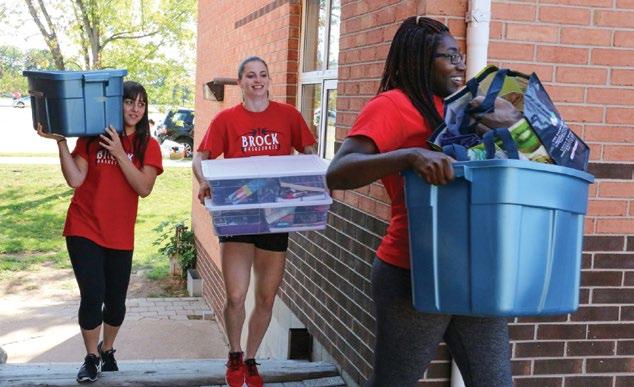


Based on expected enrolment targets, Residences includes a budget of 95.5 per cent occupancy for 2023-24. Business development in areas of overnight accommodations and strategic on-campus partnerships, as well as future improvements to enrolment are projected to improve occupancy to 98.5 per cent occupancy in future years.

For more information, visit brocku.ca/residence
Note: Revenue includes $24.92 million ($23.88 million in 2022-23) of residence fees. Operating costs include $1.75 million ($1.65 million in 2022-23) of residence annual lease payments; $0.57 million ($0.55 million in 2022-23) of direct utility costs and $1.71 million ($1.71 million in 2022-23) of utility costs charged back to Residences; $4.43 million ($4.43 million in 2022-23) of debt payments; contribution to financing the 2020 bond of $2.85 million ($2.85 million in 2022-23); contribution to the capital and related projects budget of $3.38 million ($3.62 million in 2022-23) and $1.43 million ($1.48 million in 2022-23) of repairs and maintenance and capital replacement costs. Also includes $0.29 million of interdepartmental funding for Campus Safety Services staff (nil 2022-23).

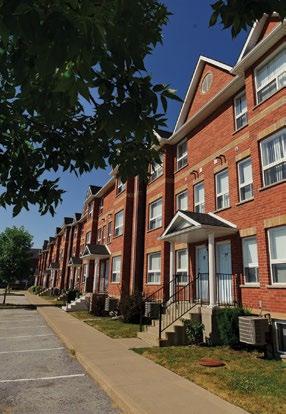
Figure 84-A ($000s) 2023-24 Budget 2022-23 Budget 2021-22 Actual Revenue 25,344 24,158 19,440 Personnel costs (4,573) 19.9% (4,515) 19.8% (2,990) 17.2% Operating costs (18,401) 80.1% (18,283) 80.2% (14,351) 82.8% Total costs (22,974) 100% (22,798) 100% (17,341) 100% Net 2,370 1,360 2,099 FTE – staff (1) 44.2 43.6 (1) FTE – staff represents evaluated salaried staff positions and ongoing CUPE 1295 positions (both filled and unfilled).
Village Residence DeCew Residence Residence 8 Lowenberger Residence Quarryview Residence Earp Residence Vallee Residence Gateway Residence 29 14 12 11 10 10 11 3
62 2023-24 Budget Report SNAPSHOTS
Figure 84-B: 2023-24 total revenue by cost centre (%)
Shared services
Senior Academic and Administration Team
Information Technology Services
As the University moves forward with the Institutional Strategic Plan, the University’s leadership is taking an active role in advancing the strategic priorities as set out in this plan.
The Senior Academic and Administration Team, as defined in the 2023-24 budget report, represents a number of the offices of senior administration as well as the operating costs of the Board of Trustees and Senate. The senior administrative offices included are: the President; the Vice-President, Administration; the Provost and Vice-President, Academic; the VicePresident, Research; the Vice-President Advancement and External Relations; the Vice-Provost and Associate Vice-President, Academic; the Associate VicePresident, Students; the Vice-Provost, Indigenous Engagement; and the Vice-Provost, Teaching and Learning.
Information Technology Services (ITS) is a trusted partner in the University’s teaching, learning, research, and administrative initiatives and in the broader Niagara community. Our mission is to foster collaboration and trust, develop and enhance a reliable technologyrich environment, provide secure and accessible systems, and continue promoting a service-oriented culture within ITS to support the Brock community. ITS is comprised of five teams: Enterprise Solutions, Client Services, IT Infrastructure, the Security team and the Project and Administrative Support Office (PASO). For more information on ITS, visit brocku.ca/information-technology
Note: Revenue includes $0.40 million ($0.39 million 2022-23) of internal chargeback revenue related to the Residence Technology Fee. Operating costs include $1.11 million ($1.11 million in 2022-23) of repairs and maintenance and capital replacement costs.

63
($000s) 2023-24 Budget 2022-23 Budget 2021-22 Actual Revenue 38 108 Personnel costs (5,269) 86.7% (4,536) 85.7% (3,951) 91.3% Operating costs (805) 13.3% (759) 14.3% (376) 8.7% Total costs (6,074) 100% (5,295) 100% (4,327) 100% Net (6,074) (5,257) (4,219) FTE – staff (1) 31.5 26.6
Figure 85
(1) FTE – staff represents evaluated salaried staff positions and ongoing CUPE 1295 positions (both filled and unfilled).
($000s) 2023-24 Budget 2022-23 Budget 2021-22 Actual Revenue 604 799 436 Personnel costs (6,404) 77.4% (7,056) 78.5% (6,077) 77.2% Operating costs (1,870) 22.6% (1,929) 21.5% (1,797) 22.8% Total costs (8,274) 100% (8,985) 100% (7,874) 100% Net (7,670) (8,186) (7,438) FTE
62.2 68.7
Figure 86-A
– staff (1)
Infrastructure Enterprise Solutions Client Services Project and Administrative Support O ce (PASO) and Security 35 30 22 13
(1) FTE – staff represents evaluated salaried staff positions and ongoing CUPE 1295 positions (both filled and unfilled).
Figure 86-B: 2023-24 total costs by cost centre (%)
2023-24 Budget Report SNAPSHOTS
In addition to the budget reported in the ITS responsibility centre, Information Technology Services' capital projects are budgeted in the Capital responsibility centre. Details of these expenditures can be found starting on page 77.
Financial Services
Office of People and Culture
Financial Services is responsible for the efficient control, budgetary guidance and analytics of the financial activities of the University through development of the Fiscal Framework documents in support of the Institutional Strategic Plan. Financial Services also has shared responsibility for various operating units. Procurement Services, the Student Accounts and Financial Aid (SAFA) office, and Central Receiving and Mail Services are also part of Financial Services. For more information on Financial Services, visit brocku.ca/finance
With a renewed focus on progressive and responsive strategic management of the people, culture and work environment at Brock, Human Resources is being reimagined as the Office of People and Culture.
The Office of People and Culture (P&C) develops strategy and creates and administers programs, policies and procedures to effectively manage the employee life cycle to support the creation of a sustainable, high-performing organization.

1) Managerial Advising & Talent Acquisition
Through the P&C's main portfolios of
2) Labour & Employment Relations,
3) People Service, Systems & Analytics
4) Organizational Development & Effectiveness
5) Health, Safety & Wellness
6) Total Rewards & Payroll (including Compensation, Benefits, Pension and Payroll), and 7) EDI Culture & Education, the P&C team focuses on attracting, retaining and developing the key talent needed to execute against the institution's four strategic priorities. This office is immediately focused on advancing our equity, diversity and inclusion (EDI) efforts, revising our compensation program to better align with the market, weaving flexibility and innovation into our hybrid work practices, and enhancing our learning and development programs. As well, P&C will continue to play an important role in creating and supporting a safe, welcoming and effective organizational culture. To learn more about the Office of People and Culture and how they support faculty and staff, visit brocku.ca/hr
64 2023-24 Budget Report SNAPSHOTS
($000s) 2023-24 Budget 2022-23 Budget 2021-22 Actual Revenue 575 589 541 Personnel costs (2,951) 82.7% (3,051) 80.3% (2,879) 78.7% Operating costs (619) 17.3% (749) 19.7% (779) 21.3% Total costs (3,570) 100% (3,800) 100% (3,658) 100% Net (2,995) (3,211) (3,117) FTE – staff (1) 33.4 34.6
Figure 87-A
(1) FTE – staff represents evaluated salaried staff positions and ongoing CUPE
1295
positions (both filled and unfilled).
($000s) 2023-24 Budget 2022-23 Budget 2021-22 Actual Revenue 374 374 236 Personnel costs (3,782) 85.7% (3,981) 84.1% (3,524) 82.5% Operating costs (631) 14.3% (752) 15.9% (749) 17.5% Total costs (4,413) 100% (4,733) 100% (4,273) 100% Net (4,039) (4,359) (4,037) FTE – staff (1) 37.5 40.2
Figure 88
Financial Services Procurement Services SAFA Central Receiving and Mail Services Finance – University Wide 35 22 20 14 9
(1) FTE – staff represents evaluated salaried staff positions and ongoing CUPE 1295 positions (both filled and unfilled).
Figure 87-B: 2023-24 total costs by cost centre (%)
University Marketing and Communications (Advancement and External Relations)
Development and Alumni Relations (Advancement and External Relations)
As part of Advancement and External Relations, University Marketing and Communications (UMC) provides the strategic direction for Brock University’s brand, marketing and communications efforts. As stewards of Brock’s brand and reputation, UMC tells the Brock story to the University’s many and varied audiences, including students, prospective students, staff and faculty, the community, industry, and the government. UMC’s key responsibilities include brand management, integrated marketing and communications, media relations and public affairs, social media, web and digital content development, and community engagement. For information, visit brocku.ca/marketing-communications

(1) FTE – staff represents evaluated salaried staff positions and ongoing CUPE 1295 positions (both filled and unfilled).
As part of Advancement and External Relations, the Department of Development and Alumni Relations aligns with the Institutional Strategic Plan by raising funds for strategic plan fundraising priorities, including funding for the transformational student experience, enhancing research, and collaborating with partners from the local region and beyond to deliver philanthropic support. The department is responsible for Brock’s philanthropic activity, alumni engagement and maintaining records to stay in touch with Brock’s more than 100,000 alumni. The department works with donors who provide philanthropic support for University priorities, including capital projects, teaching and learning, technology and student support, as well as with the volunteer Brock University Alumni Association Board of Directors. For more information, visit brocku.ca/alumni
65
Figure 89-A ($000s) 2023-24 Budget 2022-23 Budget 2021-22 Actual Revenue 7 Personnel costs (1,811) 69.0% (1,425) 63.3% (1,233) 60.4% Operating costs (814) 31.0% (826) 36.7% (808) 39.6% Total costs (2,625) 100% (2,251) 100% (2,041) 100% Net (2,625) (2,251) (2,034) FTE – staff (1) 21.0 16.7 (1) FTE – staff represents evaluated salaried staff positions and ongoing CUPE 1295 positions (both filled and unfilled). 2023-24 Budget Report SNAPSHOTS
($000s) 2023-24 Budget 2022-23 Budget 2021-22 Actual Revenue 993 914 660 Personnel costs (1,654) 81.8% (1,735) 81.5% (1,389) 79.0% Operating costs (367) 18.2% (393) 18.5% (369) 21.0% Total costs (2,021) 100% (2,128) 100% (1,758) 100% Net (1,028) (1,214) (1,098) FTE –
(1)
Figure 90-A
staff
18.5 19.0
Development
Relations Alumni Relations Annual Fund from Telegrad Alumni Association 57 35 7 1
and Donor
Figure 90-B: 2023-24 total costs by cost centre (%)
Printing Services
University Secretariat
Printing Services will be managed through Ancillary Services starting May 2023. Printing Services provides both internal printing and the management of the fleet of multifunction copiers across campus. This area provides a wide range of print materials for academic, administrative and student print requirements. For information, visit brocku.ca/printing
Note: Revenue includes $0.81 million ($0.93 million in 2022-23) of internal charges to other departments.
The University Secretariat supports the Institutional Strategic Plan by working to ensure the University’s two governing bodies (Board of Trustees and Senate) and their committees operate effectively and efficiently by providing governance expertise, research and analysis, and general support. The Secretariat has accountability for the University's policy framework and processes.
For more information on the University Secretariat, visit brocku.ca/university-secretariat
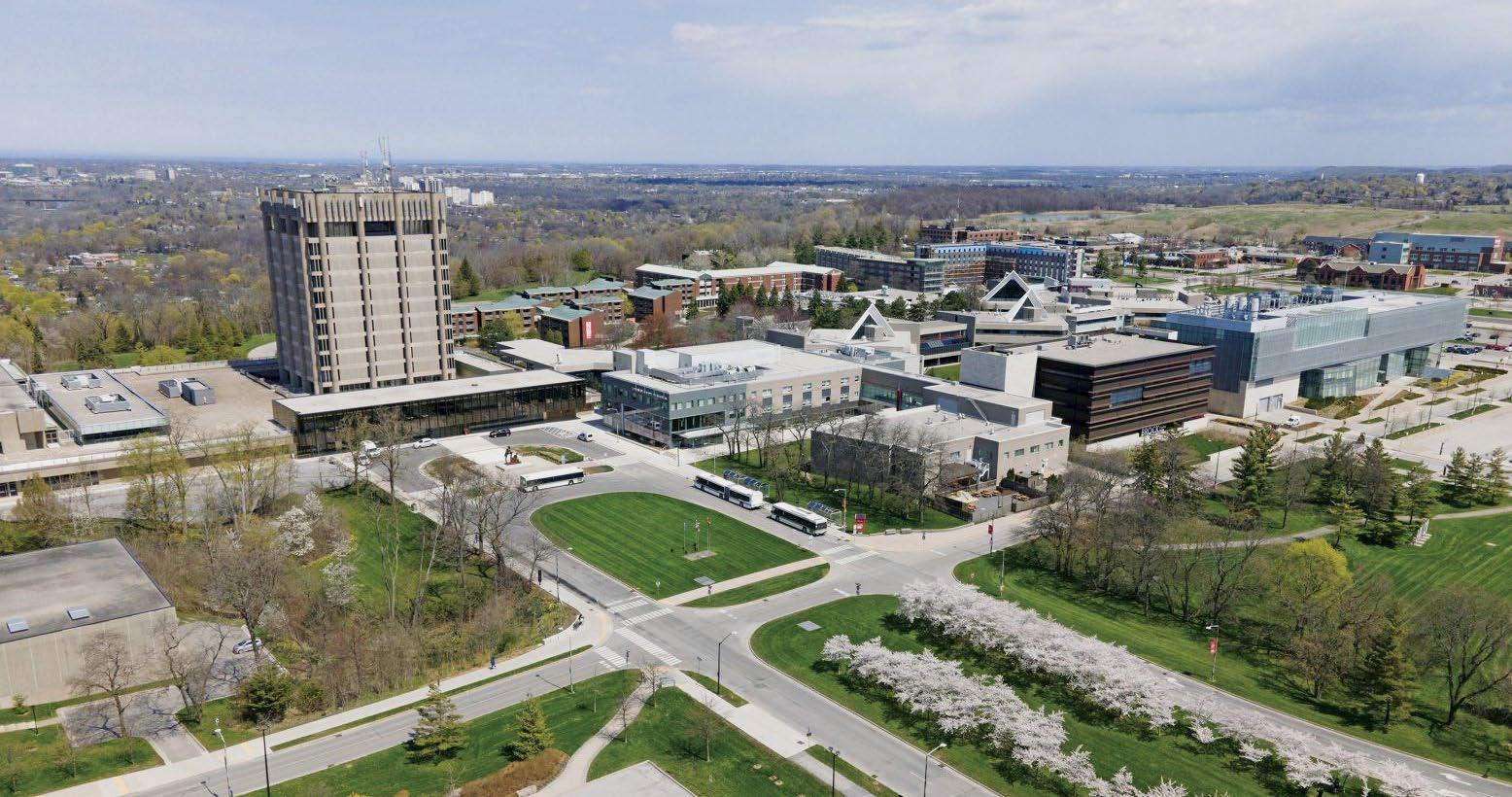
2023-24 Budget Report SNAPSHOTS 66
($000s) 2023-24 Budget 2022-23 Budget 2021-22 Actual Revenue 955 1,080 778 Personnel costs (239) 28.9% (240) 25.5% (356) 36.0% Operating costs (587) 71.1% (703) 74.5% (633) 64.0% Total costs (826) 100% (943) 100% (989) 100% Net 129 137 (211) FTE – staff (1) 3.0 3.0
Figure 91
(1) FTE – staff represents evaluated salaried staff positions and ongoing CUPE 1295 positions (both filled and unfilled).
($000s) 2023-24 Budget 2022-23 Budget 2021-22 Actual Revenue Personnel costs (491) 97.0% (523) 98.5% (796) 97.8% Operating costs (15) 3.0% (8) 1.5% (18) 2.2% Total costs (506) 100% (531) 100% (814) 100% Net (506) (531) (814) FTE – staff (1) 4.0 5.8
Figure 92
(1) FTE – staff represents evaluated salaried staff positions and ongoing CUPE 1295 positions (both filled and unfilled).
Human Rights and Equity Services
Office of the Ombudsperson
Human Rights and Equity Services supports the Institutional Strategic plan as a resource for all members of the Brock community, providing information, education and complaint resolution related to harassment, discrimination, sexual violence, accessibility and bullying. For more information on Human Rights and Equity, visit brocku.ca/human-rights

Note: Revenue includes $0.50 million ($0.50 million in 2022-23) of student ancillary fees. Operating Expenses include $0.13 million ($0.31 million in 2022-23) of contracted and professional fees.
The Student Ombudsperson is a confidential, independent and impartial service for undergraduate and graduate students. The Ombudsperson can support individuals who have complaints or concerns by providing resources and advice, facilitating communication, assisting with informal problem solving, assisting with appeal procedures and investigating concerns. When appropriate, the Ombudsperson may also make recommendations on changes to University policies or procedures. For more information, please visit brocku.ca/ombuds/
Note: Revenue includes $0.12 million ($0.13 million in 2022-23) of student ancillary fees.
2023-24 Budget Report SNAPSHOTS 67
($000s) 2023-24 Budget 2022-23 Budget 2021-22 Actual Revenue 121 131 Personnel costs (107) 88.4% (118) 90.1% Operating costs (14) 11.6% (13) 9.9% Total costs (121) 100% (131) 100% Net - -FTE – staff (1) 1.0 1.1 (1) FTE
Figure
94
– staff represents evaluated salaried staff positions and ongoing CUPE 1295 positions (both filled and unfilled).
($000s) 2023-24 Budget 2022-23 Budget 2021-22 Actual Revenue 636 634 731 Personnel costs (1,133) 78.5% (989) 70.5% (891) 43.5% Operating costs (310) 21.5% (414) 29.5% (1,159) 56.5% Total costs (1,443) 100% (1,403) 100% (2,050) 100% Net (807) (769) (1,319) FTE – staff (1) 9.3 7.9
Figure 93
(1) FTE – staff represents evaluated salaried staff positions and ongoing CUPE 1295 positions (both filled and unfilled).
Office of Government and Community Relations
Institutional Planning, Analysis and Performance
The Office of Government and Community Relations builds relationships at all levels of government and with valued community partners to advance Brock University's strategic priorities and to raise awareness about the University's unique areas of strength by:
• Monitoring and providing advice on public policy and programs
• Developing, building and broadening relationships with elected representatives, non-elected officials and community partners
• Supporting Brock’s government advocacy
• Acting as a liaison and central point of contact
• Co-ordinating strategic communications and engagement
• Facilitating government and community partner visits to Brock’s campus
• Engaging with sector associations, including Universities Canada and the Council of Ontario Universities (COU)
• Matching community needs with University expertise to build community capacity
• Partnering with community partners across the Niagara region and beyond to help solve problems, generate research solutions, and co-create knowledge
For more information on the Office of Government and Community Relations, visit brocku.ca/government-relations

Institutional
Planning, Analysis and Performance
(IPAP) strives to be recognized as a leader in higher education for developing innovative analytics, informing data-driven decision making and having an unparalleled culture of data governance and accountability. Through the collection, evaluation, and organization of enrolment, survey, and other institutional data, we translate campus data into useful information for the government, the Brock community, and the general public. IPAP also provides analytics to support Brock's leaders in their pursuit of improving institutional effectiveness and overall student success. For more information, please visit brocku.ca/institutional-analysis
68
Figure
($000s) 2023-24 Budget 2022-23 Budget 2021-22 Actual Revenue 3 Personnel costs (563) 91.5% (548) 91.3% (515) 93.6% Operating costs (52) 8.5% (52) 8.7% (35) 6.4% Total costs (615) 100% (600) 100% (550) 100% Net (615) (600) (547) FTE – staff (1) 5.0 6.0
95
Figure
($000s) 2023-24 Budget 2022-23 Budget 2021-22 Actual Revenue 48 Personnel costs (588) 93.6% (527) 97.6% (340) 95.0% Operating costs (40) 6.4% (13) 2.4% (18) 5.0% Total costs (628) 100% (540) 100% (358) 100% Net (628) (540) (310) FTE – staff (1) 6.0 5.0
(1) FTE – staff represents evaluated salaried staff positions and ongoing CUPE 1295 positions (both filled and unfilled).
96
(1) FTE – staff represents evaluated salaried staff positions and ongoing CUPE 1295 positions (both filled and unfilled).
2023-24 Budget Report SNAPSHOTS
Internal Audit and University Risk Management
Legal Services

Internal Audit independently assesses the strength of the University’s risk-management and control processes. We support the achievement of the University’s guiding value of ensuring sustainable, accountable and transparent stewardship of public and private resources through traditional risk and control-based reviews, assurance and compliance audits, project oversight and support, and investigations. University Risk Management, which includes the management of Brock’s insurance portfolio, supports the management of risks through a framework that identifies, assesses, monitors and reports on the status of the University’s principal risks. For more information, visit brocku.ca/internal-audit
The University’s Legal Services unit provides legal advice and support to the University to advance the mission and strategic priorities of the University while mitigating legal risks and promoting compliance with all legal and regulatory requirements. As part of this mandate, the Legal Services unit includes investigations services, managing and conducting investigations into allegations of harassment and discrimination. The Legal Services unit also oversees the administration of the University’s Freedom of Information and Protection of Privacy Act responsibilities and manages the University’s records management program. For more information, visit brocku.ca/legal/
69
Figure
($000s) 2023-24 Budget 2022-23 Budget 2021-22 Actual Revenue Personnel costs (537) 95.2% (529) 94.3% (382) 89.0% Operating costs (27) 4.8% (32) 5.7% (47) 11.0% Total costs (564) 100% (561) 100% (429) 100% Net (564) (561) (429) FTE – staff (1) 4.0 4.0
97
(1) FTE – staff represents evaluated salaried staff positions and ongoing CUPE 1295 positions (both filled and unfilled).
($000s) 2023-24 Budget 2022-23 Budget 2021-22 Actual Revenue Personnel costs (639) 82.0% (694) 97.1% (4) 100% Operating costs (140) 18.0% (21) 2.9% - 0.0% Total costs (779) 100% (715) 100% (4) 100% Net (779) (715) (4) FTE – staff (1) 5.3 5.3
Figure 98
2023-24 Budget Report SNAPSHOTS
(1) FTE – staff represents evaluated salaried staff positions and ongoing CUPE 1295 positions (both filled and unfilled).
Space
Facilities Management
maintenance; ground maintenance; capital planning, design and construction; project management; code and bylaw compliance; and cleaning and nonhazardous waste management. For more information, visit brocku.ca/facilities-management

Facilities Management supports the Institutional Strategic Plan by providing an exceptionally clean, safe, accessible and well-maintained physical environment for the University community by planning and developing services that are sustainable and supportive of academic excellence, including the sustainable operation of our District Energy System; facility
Note: Revenue includes $0.57 million ($0.68 million in 2022-23) of revenue related to internal charges to other departments within the University, mainly salary chargebacks. Operating costs include $2.15 million ($2.15 million in 2022-23) of repairs and maintenance and capital replacement costs, and $2.15 million ($1.68 million in 2022-23) of contracted services and professional fees, including maintenance, custodial and grounds contracted services. Utilities costs are not included in the Facilities Management budget and are reported as part of the Utilities, Taxes and Insurance responsibility centre on page 72.
70
In addition to the budget reported in the Facilities Management responsibility centre, Facilities Management capital projects are budgeted in the Capital responsibility centre. Details of these expenditures can be found starting on page 77.
($000s) 2023-24 Budget 2022-23 Budget 2021-22 Actual Revenue 1,957 1,677 653 Personnel costs (12,348) 74.6% (12,496) 74.4% (11,396) 75.7% Operating costs (4,215) 25.4% (4,310) 25.6% (3,665) 24.3% Total costs (16,563) 100% (16,806) 100% (15,061) 100% Net (14,606) (15,129) (14,408) FTE – staff (1) 139.9 146.0 (1) FTE – staff represents evaluated salaried staff positions and ongoing CUPE 1295 positions (both filled and unfilled).
Figure 99
2023-24 Budget Report SNAPSHOTS
Campus Safety Services
Campus Development and Community Agreements
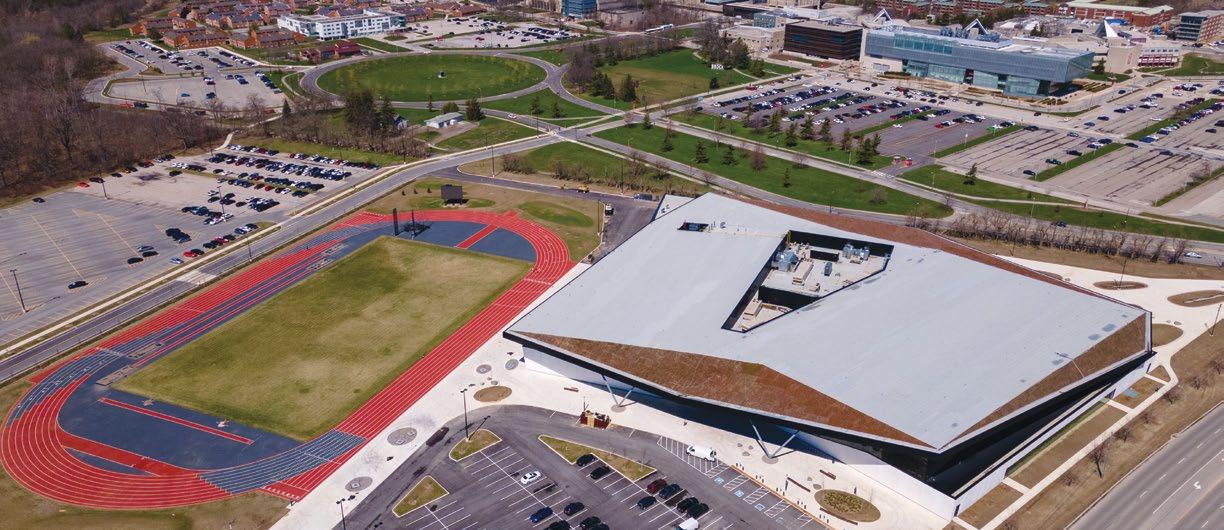
Campus Safety Services is a dedicated team of experienced and skilled professionals who ensure the safety and security of the Brock Community along with all of its campuses and properties. We align our goals and objectives with the Institutional Strategic Plan to ensure the campus experience is engaging and meets the needs of our students, faculty, staff and visitors. We provide individual personal safety planning, threat assessments, teaching and learning opportunities, mentorship, and support to meet the needs of the entire Brock community. Campus Safety is closely connected and in partnership with all external emergency responders to our campus in order to train and respond together for emergency preparedness and awareness. Campus Safety Services continues to work closely with all Emergency Responders and the Niagara Region Public Health unit. For more information on our services, videos and safety applications, visit brocku.ca/campus-security
Note: Revenue includes $0.29 million of interdepartmental funding to support Campus safety services in Residences. Operating costs include $0.95 million ($0.87 million in 2022-23) of contracted security services.
Campus Development includes the rental revenue and related expenses for Heritage Plaza, which houses McDonald's, Tim Hortons, The Campus Pharmacy and Medical Clinic, and other retailers. Community Agreements include payments for community events, First Ontario Performing Arts Centre, and a transfer to BUSU for transit funding. Also part of this portfolio is the Canada Summer Games Park Consortium.
71
($000s) 2023-24 Budget 2022-23 Budget 2021-22 Actual Revenue 594 150 212 Personnel costs (1,876) 63.7% (1,617) 61.8% (1,746) 63.7% Operating costs (1,069) 36.3% (999) 38.2% (996) 36.3% Total costs (2,945) 100% (2,616) 100% (2,742) 100% Net (2,351) (2,466) (2,530) FTE – staff (1) 22.0 18.0 (1) FTE – staff represents evaluated salaried staff positions and ongoing CUPE 1295 positions (both filled and unfilled).
Figure 100
Figure
($000s) 2023-24 Budget 2022-23 Budget 2021-22 Actual Revenue 307 693 1,066 Personnel costs (28) 1.4% (89) 2.9% (87) 3.7% Operating costs (1,996) 98.6% (3,013) 97.1% (2,248) 96.3% Total costs (2,024) 100% (3,102) 100% (2,335) 100% Net (1,717) (2,409) (1,269) FTE – staff (1) 0.2 0.6 (1) FTE – staff represents evaluated salaried staff positions and ongoing CUPE 1295 positions (both filled and unfilled) 2023-24 Budget Report SNAPSHOTS
101
Utilities, Taxes and Insurance Financing
The Utilities, Taxes and Insurance responsibility centre includes all centrally billed utility costs of $6.91 million ($6.27 million in 2022-23), including $0.81 million ($0.38 million in 2022-23) of federal carbon taxes.
This represents the majority of the University's total utility costs of $7.53 million ($7.18 million 2022-23). See Figure 61 on page 37 for details of utility costs. The remaining utility costs are billed directly to operating units. As detailed in Figure 102-B, offsetting these utility costs are chargebacks to Residences and external units to the University.
As further detailed in Figure 102-B, included in operating costs are municipal taxes (payment in lieu of property taxes), offset by the Grant in Lieu of Municipal Taxes. For more details, see page 30. The remaining operating costs are made up of repairs and maintenance and capital replacement costs, the majority of which are related to the University's central utilities building; insurance costs, contracted services and professional fees, and other operating costs.
The Financing responsibility centre includes the portion of the principal and interest payments of the University’s external debt, which is not included in Residences or in Ancillary Services. The budget includes principal payments of $1.55 million ($1.0 million in 2022-23) related to debt for 3401 Schmon Parkway. 2022-23 budget included principal of $0.23 related to the debt for the Roy and Lois Cairns Health and Bioscience Research Complex (RLCHBRC). Interest of $6.81 million ($6.87 million in 2022-23) related to the debt for the 2045 $93-million debenture (2005 bond), the 2060 $125-million debenture (2020 bond), the Scotia loan and 3401 Schmon Parkway were included in the budget. 2022-23 also included interest related to the debt for RLCHBRC. For details on all interest and principal payments included in the budget, see Figure 62 on page 38. For a breakdown of the debt and more information on Brock’s financing strategies and all debt outstanding, see page 83.
The revenue in the Financing responsibility centre in the 2023-24 budget represents the Zone expansion student ancillary fee of $1.49 million ($1.55 million in 2022-23), which is being transferred to an internally restricted reserve (sinking fund) as part of inter-fund expenses to support the repayment of the Zone Expansion project. Also included is a transfer from Ancillary and Residence to fund $3.22 million ($3.22 million in 2022-23) of the 2020 bond debenture debt payments. The 2022-23 budget included revenue of $0.38 million of investment income on the sinking fund, which was transferred to an internally restricted reserve to support the 2005 bond. This is not included in 2023-24 to align the budget more closely with actuals as the investment income is directly reported in the sinking fund.
72
Figure
($000s) 2023-24 Budget 2022-23 Budget 2021-22 Actual Revenue 3,125 3,048 2,440 Personnel costs - 0.0% - 0.0% (4) 0.1% Operating costs (10,569) 100% (9,873) 100% (7,863) 99.9% Total costs (10,569) 100% (9,873) 100% (7,867) 100% Net (7,444) (6,825) (5,427) Figure
($000s) 2023-24 Budget 2022-23 Budget 2021-22 Actual Revenue 4,711 5,156 1,510 Personnel costs - 0.0% 0.0% 0.0% Operating costs (9,929) 100% (10,101) 100% (10,593) 100% Total costs (9,929) 100% (10,101) 100% (10,593) 100% Net (5,218) (4,945) (9,083)
102-A
103
Operating costs –Total $10,569 Utilities Municipal taxes Contracted services and professional fees Repairs and maintenance and capital replacement Insurance Other 6,914 2,019 1,231 1,106 500 1,286 395 243 O setting revenue –Total $3,125 Internal chargebacks ($1,670) & external chargebacks ($349) Grant in Lieu of Municipal Taxation
2023-24 Budget Report SNAPSHOTS
Figure 102-B: 2023-24 operating costs vs. offsetting revenue ($000s)
Scholarships, Bursaries and Fellowships
prevented from attending post-secondary education because of a lack of financial support programs. The MCU requires all colleges and universities that receive public funding to provide enough financial aid to cover a student’s assessed needs for expenses directly related to his or her program that are not fully met by OSAP. Also included in need-based awards is Brock’s bursary assistance of $0.90 million ($0.43 million in 2022-23), as well several other specialty awards, including the Student International Mobility Awards, Emergency Bursaries, etc.
The Scholarships, Bursaries and Fellowships budget supports the Institutional Strategic Plan by helping and supporting students in attending the University. This unit represents the majority of Brock’s undergraduate and graduate scholarships, bursaries and fellowships (SBFs). Of the total SBFs reported in this unit, $16.70 million ($18.83 million in 2022-23) relates to support for undergraduate students and $10.36 million ($11.20 million in 2022-23) relates to support for graduate students, including endowment-allocated scholarships and student awards. In 2023-24 there are two new awards included in undergraduate scholarships, the Black, Indigenous, and people of colour (BIPOC) award and the Child Welfare Political Action Committee Canada award.
Undergraduate
The undergraduate SBFs can be split into four main types: University-funded, those funded by government grants, student tuition waivers and those funded by endowments.
Total budgeted undergraduate University-funded SBFs of $13.18 million ($15.36 million in 2022-23) are either merit-based or need-based.
• Merit-based awards are budgeted to be $11.33 million ($14.04 million in 2022-23). Merit-based awards include Brock Entrance Scholars Awards of $3.12 million ($5.53 million in 2022-23) and renewals of those scholarships of $6.49 million ($6.82 million in 2022-23), as well as a number of other awards, including course-based scholarships, the International Student Ambassador Award, the Principal’s Awards, etc.
• Need-based awards are budgeted to be $1.85 million ($1.32 million in 2022-23). These include funding related to the requirements of the Student Access Guarantee (SAG), an MCU initiative that states that no qualified Ontario student should be
• Undergraduate student tuition waivers for Brock faculty and staff and their dependents are budgeted to be $1.28 million ($1.28 million in 2022-23).
Total grant-funded undergraduate SBFs for 2023-24 are budgeted to be $0.14 million ($0.13 million in 2022-23), which are directly offset with grant revenue.
Starting in 2018-19, the funding budget includes the endowment-allocated spend related to scholarships and student awards. The undergraduate portion for 2023-24 is $2.09 million ($2.05 million 2022-23). This support is shown in the budget as an inter-fund expense, with an offsetting inter-fund revenue of the same amount.
The following chart details the proportion of the total undergraduate SBFs (in this unit) by type – meritbased, need-based, tuition waivers, endowmentfunded and grant-funded.
73
($000s) 2023-24 Budget 2022-23 Budget 2021-22 Actual Revenue 3,629 3,550 3,551 Personnel costs 0.0% 0.0% 0.0% Operating costs (27,056) 100% (30,023) 100% (25,750) 100% Total costs (27,056) 100% (30,023) 100% (25,750) 100% Net (23,427) (26,473) (22,199)
Figure 104-A
Global Brock Scholars and renewals Other 12 1 68 85 15 11 8 Merit-based Needs-based Tuition waivers Endowment-funded Grant-funded
(%) 2023-24 Budget Report SNAPSHOTS
Figure 104-B: 2023-24 undergraduate scholarships and student awards
Graduate
The majority of graduate SBFs are in the form of University-funded fellowships of $7.51 million ($8.13 million in 2022-23). Other graduate SBFs of $1.02 million ($1.24 million in 2022-23) include University-funded entrance scholarships and awards for excellence, research awards, and bursaries. In addition, there are scholarships funded two-thirds by the MCU, in the amount of $1.02 million ($1.03 million in 2022-23), with an offsetting grant revenue of $0.68 million ($0.66 million in 2022-23).
Also included in graduate SBFs are student tuition waivers for Brock faculty and their dependents and Brock staff, which are budgeted to be $0.19 million ($0.19 million in 2022-23).
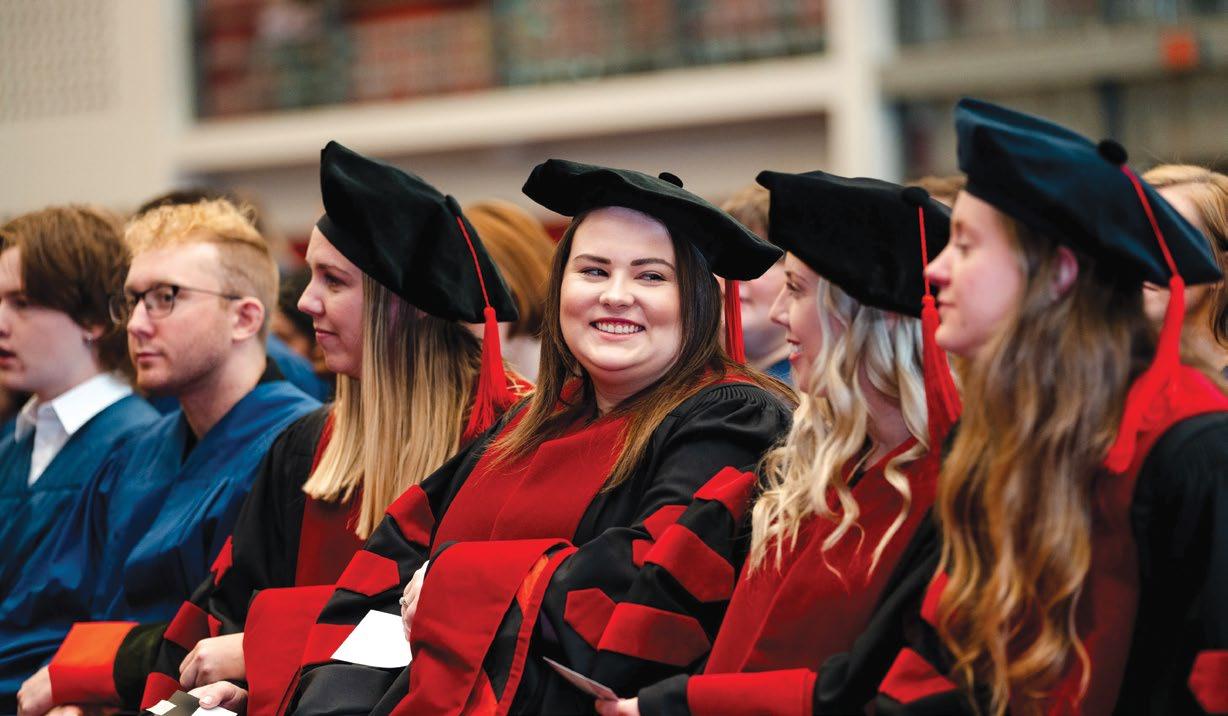
As previously mentioned, starting in 2018-19, the funding budget includes the endowment-allocated spend related to scholarships and student awards. The graduate portion for 2023-24 is $0.62 million ($0.60 million in 2022-23). This support is shown in the budget as an inter-fund expense, with an offsetting inter-fund revenue of the same amount.
The Capital responsibility centre represents the total funding of both the Facilities Management projects of $8.21 million ($9.49 million in 2022-23) and the Information Technology Services projects of $4.77 million ($5.33 million in 2022-23) in the capital and related project budget. Offsetting these costs is the contribution from Ancillary and Residence to the capital and related project budget of $4.04 million ($4.02 million in 2022-23). Also included in revenue is Facilities Renewal Program Funds of $3.85 million ($2.95 million in 2022-23). See page 31 for a discussion of these funds. See pages 77 to 81 for details of the capital and related project budget.
74
Figure
($000s) 2023-24 Budget 2022-23 Budget 2021-22 Actual Revenue 7,895 6,976 8,790 Personnel costs - 0.0% 0.0% 0.0% Operating costs (12,974) 100% (14,815) 100% (15,028) 100% Total costs (12,974) 100% (14,815) 100% (15,028) 100% Net (5,079) (7,839) (6,238)
Capital
105
2023-24 Budget
SNAPSHOTS
Report
University Global
• Asset sale revenue in the amount of $6.87 million ($7.93 million in 2022-23) related to the sale of the Hamilton campus. The $6.87-million proceeds, along with the $0.13 million imputed interest, is offset by an allocation of $7.0 million ($8.0 million in 2022-23) to the strategic fund to be used to support strategic priorities including the new Burlington campus.
• Inter-fund revenue from contingency reserve of $1.50 million to support the English as a Subsequent Language (ESL) program.
University Global represents those costs and revenue that are University-wide and are not budgeted for by any Faculty or department, including the majority of student tuition, MCU operating grants and anticipated salary increases that haven’t yet been awarded. University Global also includes $1.95 million, representing 0.5 per cent of overall revenue ($3.90 million representing one per cent of overall revenue in 2022-23) of unallocated funding to support the Institutional Strategic Plan. These funds will be distributed to Faculties or departments throughout 2023-24 for identified projects that directly support the priorities identified in the Institutional Strategic Plan. Full details of the University Global costs and revenue are described below.
Revenue for University Global includes the following:
• Tuition of $180.05 million ($190.70 million in 2022-23) as detailed in Figure 41 on page 24.
• Grant revenue of $94.76 million ($90.38 million in 2022- 23) as follows:
– Core operating grant of $41.44 million ($48.36 million in 2022-23) – see page 29.
– Differentiation envelope of $48.42 million ($39.43 million in 2022-23) – see page 28.
– Nursing grant of $6.19 million ($4.52 million in 2022-23) – see page 31.
– Niagara Region Brock LINC grant of $0.50 million ($0 million in 2022-23) – see page 31.
– International Student Recovery Fee of $1.79 million ($1.91 million in 2022-23), which offsets the reduction mentioned above in grant revenue – see page 30.
• Interest on short-term investments of $2.20 million ($1.50 million in 2022-23) – see page 33.
• Other revenue of $2.88 million ($2.82 million in 2022- 23), which includes $0.13 million ($0.7 million in 2022-23) of imputed interest related to the sale of the Hamilton campus.
• Included in the 2022-23 budget was $0.15 million from strategic funds to offset the cost of the rapid antigen program.
Personnel costs for University Global includes $6.42 million ($1.86 million in 2022-23) related to salary and wage increases that are anticipated but not yet awarded or negotiated. Note: The salary and wage increases that were anticipated but not yet awarded or negotiated included in the Global responsibility unit in the 2022-23 Budget Report have since been allocated to the respective units and are therefore reported as such in this Budget Report. See Appendix B for further details. University Global also includes other personnel costs not allocated to any department of $0.40 million ($0.68 million in 2022-23). Offsetting these costs are budgeted savings from voluntary vacation buy back of $0.18 million ($0.09 million in 2022-23).
Operating costs for University Global include the following:
• Strategic funding to support the Institutional Strategic Plan in the amount of $1.95 million ($3.9 million in 2022-23), which was introduced as part of the operating budget for the first time in 2020-21.
• Funding of $7.0 million ($8.0 million in 2022-23) to the strategic fund related to the sale of the Hamilton campus.
• Other operating costs of $2.19 million ($2.11 million in 2022-23), which includes University memberships, allowances for uncollectable funds, payment to Niagara College related to its share of the GAME program and other University-wide expense items.
75
($000s) 2023-24 Budget 2022-23 Budget 2021-22 Actual Revenue 290,057 295,396 275,262 Personnel costs (6,643) 37.4% (885) 6.1% 2,827 (35.9%) Operating costs (11,133) 62.6% (13,724) 93.9% (10,707) 135.9% Total costs (17,776) 100% (14,609) 100% (7,880) 100% Net 272,281 280,787 267,382
Figure 106
2023-24 Budget Report SNAPSHOTS

76 2023-24 Budget Report CAPITAL
Capital and related projects budget
Background
The capital and related project budget was approved on Dec. 15, 2022 by the Board of Trustees after inputgathering from the Brock community. The process to develop this capital and related project budget began in the summer of 2022, when Facilities Management and Information Technology Services first published proposed projects and sought input. Further discussions were held at committee levels, including the Senate Information Technology and Infrastructure Committee and the Senate Planning, Priorities and Budget Advisory Committee. The capital plan was developed in support of the Institutional Strategic Plan for the University. Approving the capital and related projects budget in late November or early December allows Facilities Management and Information Technology Services time to start planning the projects so, where possible, they can be accomplished in the spring and summer when the campus is less busy, as well as to ensure there is sufficient time to obtain competitive pricing.
Information and updates on the 2022-23 capital and related projects can be found in the 2022-23 trimester reporting at brocku.ca/about/university-financials. A key feature of this capital and related project planning is that any unspent funds of the 2022-23 capital and related projects budget will be reserved at April 30, 2023 and be moved into fiscal 2023-24 so the projects can be completed.
Capital and related projects overview
The 2023-24 capital and related projects budget (capital plan) is $12.97 million (Information Technology Services Projects – $4.77 million; Facilities Management Projects – $8.20 million). The specific projects are detailed in Figures 109 and 110.
As shown in Figure 107, the funding of the capital plan is made up as follows: $9.12 million is funded by the operating budget – both ancillary ($4.04 million) and non-ancillary contributions ($5.08 million), and $3.85 million is funded from Facilities Renewal.
It is important to note that the 2022-23 Fiscal Framework set out targeted capital plan funding of $14.8 million for 2023-24. Due to the current financial environment and the continued mitigation strategies, $1.86 million of funding for the capital plan was held back related to projects that were determined to be lower priority.
Non-ancillary contribution –$5.079 million
Ancillary contribution –$4.042 million
Facilities Renewal Program –$3.853 million
The 2023-24 capital and related projects budget identifies key areas of investment, including the District Energy Water Supply replacement ($0.56 million), residence and dining services projects ($3.89 million), core subscription and strategic student solutions ($2.05 million), classroom modernization ($0.45 million), Learning Management System ($0.37 million) and parking lot repairs and maintenance ($0.41 million). The capital plan includes $9.22 million in deferred maintenance spending, which exceeds the fiscal framework target of $6.0 million, and $0.26 million reserved for residence renewal as approved in the student experience infrastructure projects.
The primary driver informing much of the Facilities Management campus planning regarding deferred maintenance has been the condition assessment performed by VFA Inc. VFA, through the Council of Ontario Universities (COU), maintains a common reporting tool to track facilities conditions across Ontario universities for deferred maintenance reporting. In 2019-2020, Ontario universities conducted a data harmonization to ensure the data is now calculated in a consistent manner with other broader public sector organizations.
The condition assessment report (May 2022) by VFA Inc. determined the University has $315 million in deferred maintenance requirements (including residences) that have accumulated over a number of years. Although this level of maintenance is not obviously apparent when walking the halls of the University, the reality is that much of the deferred maintenance is related to roofs, HVAC, electrical, plumbing and accessibility. An important observation is that this deferred maintenance figure does not include information technology. The specific classifications of areas of deferred maintenance are included in Figure 108.
77
39 31 30
2023-24 Budget Report CAPITAL
Figure 104: Capital Budget funding source (%)
Figure 107: Capital Budget funding source (%)
The Facility Condition Index (FCI) metric provides a methodology to determine the relative condition of a single building, group of buildings or total facilities and is calculated by dividing the deferred maintenance backlog by the current replacement value. The lower the FCI, the better the condition. Brock’s backlog of deferred maintenance items, as described below, results in the FCI for Brock of 0.22, which translates to “Poor” (an FCI>0.15).
Looking back over the past years, the turning point of the capital program really occurred when the Board of Trustees endorsed a motion to invest $6 million in deferred maintenance in the 2014-15 budget. The intent of the $6-million contribution was to at least maintain deferred maintenance and FCI at its current level. It should be noted that the capital plan has been accelerated through decisions to source external financing (incremental funding outside of the operating budget) and investments in student experience projects. The 2022-23 Fiscal Framework re-established the commitment to fund deferred maintenance of at least $6 million annually.
In addition to the 2023-24 capital and related projects budget, other units maintain significant capital replacement and repairs and maintenance budgets. The Facilities Management budget has $2.15 million in capital replacement and repairs and maintenance costs, Residences has $1.43 million, other Ancillary Operations have $1.11 million and the Information Technology Services budget has $1.11 million included as part of its operating costs. These budgets support building, mechanical, electrical and grounds maintenance projects ranging from elevator maintenance to door repairs to upgrades in equipment and technology.

78
Deferred maintenance ($000s) Current replacement value ($000s) FCI Academic and administrative Main campus 177,483 877,899 0.20 East campus 2,715 42,394 0.06 Satellite campuses (1) 4,641 60,850 0.08 Total academic and administrative 184,839 981,143 0.19 Site and utility infrastructure Roadways 4,075 4,058 1.00 Parking lots 6,628 7,627 0.87 Water supply mains 15,150 13,563 1.12 Storm sewer 18,811 15,902 1.18 Electrical distribution 32,763 32,117 1.02 Service tunnels 1,709 16,078 0.11 Other 32,122 38,175 0.84 Total site and utility infrastructure 111,258 127,520 0.87 Residence Total residence 18,692 325,750 0.06 Total 314,789 1,434,413 0.22
Figure 108: COU VFA Data (as at May 2022)
Source: VFA Facility Asset Condition Database.
2023-24 Budget Report CAPITAL
(1) Satellite campuses: Includes Brock Research and Innovation Centre, and the Marilyn I. Walker School of Fine and Performing Arts.
79 Figure 109: Capital and related project budget –Information Technology Services projects Project ($000s) 2023-24 Source of funds/Cash flow Total project costs Brock University values Reporting criteria Facilities Renewal Program funds Ancillary and Residence Other operating Student experience Teaching and learning Research Regulatory Campus community Deferred Maintenance (DM) Non-Deferred Maintenance New or flexible PCI compliance 250 250 250 Network switches –administrative –DM 156 156 156 Network switches –administrative –growth 20 20 20 Network switches –residences –growth 26 26 26 Network switches –residences –DM 178 178 178 Network appliances –administrative –DM 12 12 12 Wireless –administrative –growth 83 83 83 Wireless –administrative –DM 24 24 24 Wireless –residence –DM 180 180 180 Audio visual –DM 46 46 46 Audio visual (including video conferencing) –growth 46 46 46 UPS –administrative –DM 40 40 40 UPS –residence –DM 30 30 30 Closed circuit TV –administrative –DM 40 40 40 Closed circuit TV –residence –DM 10 10 10 Proxy card –DM 10 10 10 Servers –DM 86 34 120 120 Cabling infrastructure 50 50 50 Alarms/security/IP clocks –DM 25 25 25 Telephone system –replacement 250 250 250 Datacentre renovation 550 550 550 Total new or flexible 324 424 1,398 2,146 1,671 475 Core activities Core subscription fees 1,573 1,573 1,573 Core strategic student solutions 480 480 480 Learning management system 370 370 370 Student information system 200 200 200 Total core activities2,623 2,6232,623 Total 324 424 4,021 4,769 1,671 3,098 2023-24 Budget Report CAPITAL
80 2023-24 Budget Report CAPITAL Figure 110: Capital and related project budget –Facilities Management Capital Renewal Plan Project ($000s) 2023-24 Source of funds/Cash flow Total project costs Brock University values Reporting criteria Facilities Renewal Program funds Ancillary and Residence Other operating Student experience Teaching and learning Research Regulatory Campus community Deferred Maintenance (DM) Non-Deferred Maintenance University deferred maintenance District energy water supply replacement 555 555 555 Flooring renewal 50 50 50 Interior and exterior door replacement 50 50 50 Painting of public spaces 50 50 50 Energy efficiency upgrades 150 150 150 Annual high-voltage maintenance 100 100 100 Annual building automation system controls modernization 100 100 100 HVAC upgrades and replacement 600 600 600 Roof replacement 350 350 350 Elevator modernization program 350 350 350 Water line replacement and repairs 255 255 255 Motor control centre upgrade 110 110 110 Road repairs 130 130 130 Install chlorine gas to building automation system 100 100 100 Total University deferred maintenance 2,9502,950 2,950Campus site upgrades Furniture repair and replacement 50 50 50 Athletics upgrades 100 100 100 Total campus site upgrades150 150150 Teaching and learning space renovation Classroom modernization and renewal 450 450 450 Total teaching and learning space renovation 450450 450AODA (1) Accessible Built Environment (ABE) Barrier-free exterior paths of travel 50 50 50 Miscellaneous AODA upgrades 80 80 80 Total AODA (1) Accessible Built Environment 130130 130 -
81 2023-24 Budget Report CAPITAL Figure 110: Capital and related project budget –Facilities Management Capital Renewal Plan (continued) Project ($000s) 2023-24 Project spending Total project costs Brock University values Reporting criteria Facilities Renewal Program funds Ancillary and Residence Other operating Student experience Teaching and learning Research Regulatory Campus community Deferred Maintenance (DM) Non-Deferred Maintenance Audits and studies Annual Facility Condition Audits (VFA Inc.) 80 80 80 Total audits and studies80 8080 Vehicles Brock fleet replacement 150 150 150 Total vehicles150 150150 Parking lots Parking lot repair and maintenance 410 410 410 Total parking lots410410 410Residence Residence infrastructure renewal 1,000 1,000 1,000 Residence 8 infrastructure reserve 157 157 157 Village Residences –interior and exterior renewal 2,000 2,000 2,000 Residence HVAC upgrades 350 350 350 Dining Services renewal 250 250 250 Decew Residence infrastructure reserve 103 103 103 Residence furniture replacement 25 25 25 Total Residence3,8853,885 3,610 275 TOTAL 3,530 4,295 380 8,205 7,550 655 (1) AODA –Accessibility for Ontarians with Disabilities
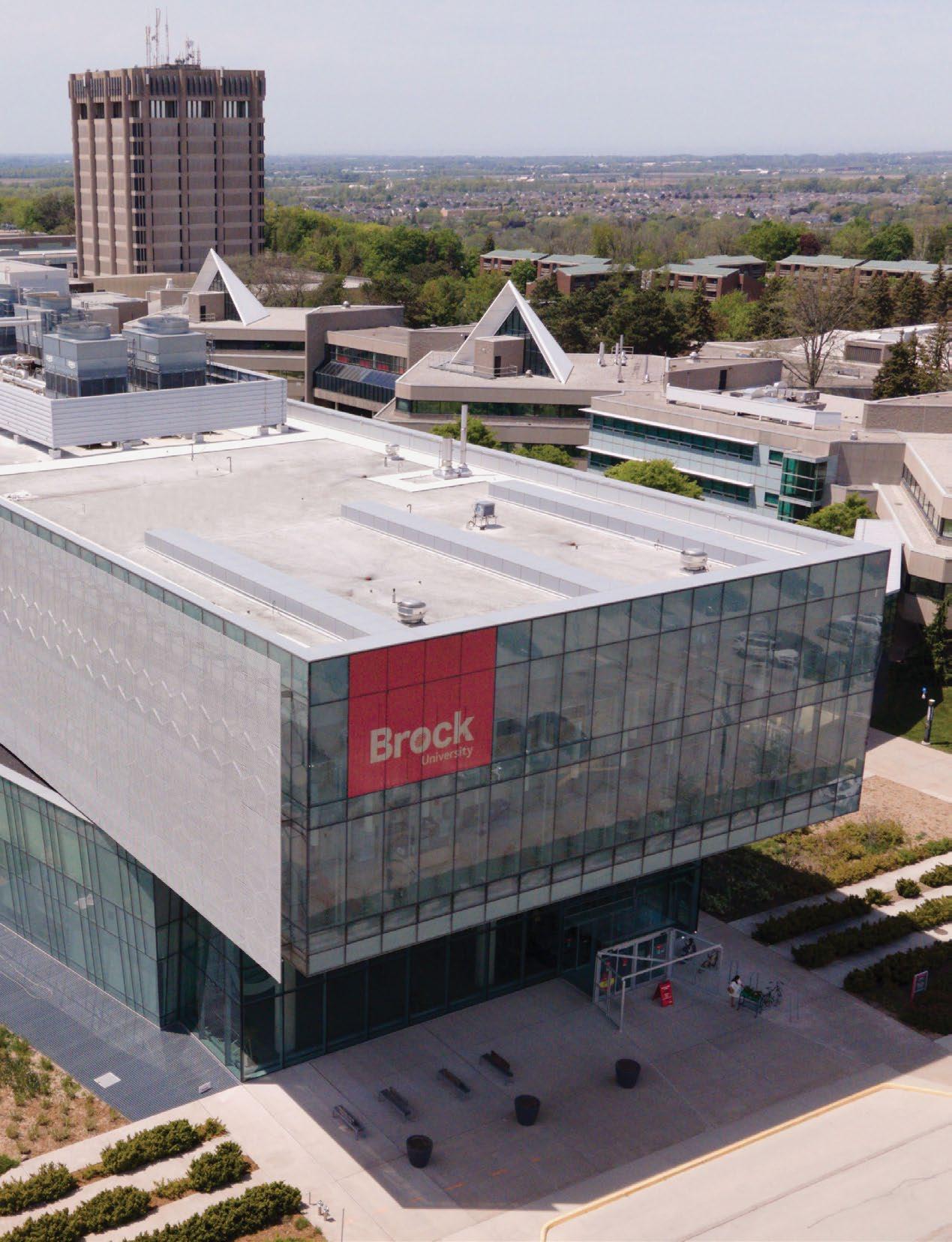
82 2023-24 Budget Report TREASURY
Financing
Figure 111 details the current and projected external debt of the University, which is within financial metric ranges of the University’s current credit rating. The 2022-23 Fiscal Framework Update continues with the holistic approach to Brock’s capital financing strategy that allows for decisions to be made in support of strategic priorities in a fiscally sustainable manner. Maintaining the University’s credit rating at A (high) or better is a strategic priority that remains in the Fiscal Framework. The impact on the University’s credit rating will be considered for any new debt and will be supported by a complete repayment plan, including Board-approved assumptions for sinking fund strategies if required.
DBRS Morningstar maintained Brock’s credit rating on March 2, 2023, with the Issuer Rating and Senior Unsecured Debentures rating of “A (high)”, with a trend of “Stable”. The continued trend of “Stable” reflects DBRS Morningstar's positive outlook regarding Brock’s financial sustainability and is the result of the prudent fiscal measures taken across the University throughout
the year. DBRS Morningstar continues to expect the University to post balanced operating results, or better, on a consolidated basis.
Brock’s debt repayment strategy is on track thanks to the successes in navigating the global pandemic and maintaining balanced operating results throughout. Brock secured additional debt financing of $15.5 million on June 27, 2022 to fund the acquisition of 3401 Schmon Parkway from Enbridge Inc. The loan includes a fixed interest rate of 3.91 per cent through an interest rate swap agreement, locked in for 5 years, amortizing over a fifteen-year period. The acquired property is 8.16 acres of land, with an 86,591 square foot commercial building on the site. The strategic acquisition was made to address the growing space requirements of the University with usage being determined through a renewed space master planning process underway. Brock also repaid the remaining $20.6 million balance outstanding on the loan for the Roy and Lois Cairns Health and Bioscience Research Complex which matured on July 4, 2022. There also
(1) Fiscal full-time enrolment (FFTE). For a definition, refer to page 88. Note: April 30, 2022 FFTE figures have been updated and decreased by 91 as they had to be resubmitted to the Ministry following an enrolment audit. Forecasted FFTEs beyond 2022 have not been updated from the 2022-23 Fiscal Framework.
83
2023-24 Budget Report TREASURY
($000s) Unless otherwise noted Actual Forecast April 30, 2017 April 30, 2018 April 30, 2019 April 30, 2020 April 30, 2021 April 30, 2022 April 30, 2023 April 30, 2024 April 30, 2025 2005 Bond 93,000 93,000 93,000 93,000 93,000 93,000 93,000 93,000 93,000 Roy and Lois Cairns Health and Bioscience Research Complex 24,863 24,109 23,319 22,491 21,624 20,715 3401 Schmon Parkway 14,333 12,968 11,561 Residence 15,215 14,333 13,385 12,366 11,271 10,095 8,831 7,473 6,014 Marilyn I. Walker School of Fine and Performing Arts (MIWSFPA) 15,960 15,240 14,520 2020 Bond and Scotia loan 14,400 139,400 139,400 139,400 139,400 125,000 Total debt 149,038 146,682 144,224 142,257 265,295 263,210 255,564 252,841 235,575 Total student FFTE (1) 20,086 20,303 20,548 21,597 21,896 21,598 22,475 22,980 23,090 Total debt/FFTE (in dollars)(1) $7,420 $7,225 $7,019 $6,587 $12,116 $12,187 $11,371 $11,003 $10,202 Debt reduction strategy Sinking fund – 2005 Bond 6,413 6,696 7,370 7,607 8,843 8,437 8,859 9,302 10,172 Sinking fund – 2020 Bond 1,532 3,107 4,797 7,480 Debt repayment reserve 2,895 4,457 6,753 384 1,884 3,153 M. Walker donation – MIWSFPA 5,326 5,470 5,617 Other donations – MIWSFPA 717 851 932 Total assets for debt reduction 15,351 17,474 20,672 7,991 10,727 13,122 11,966 14,099 17,652 Net debt 133,687 129,208 123,552 134,266 254,568 250,088 243,598 238,742 217,923 Net debt/FFTE (in dollars)(1) $6,656 $6,364 $6,013 $6,217 $11,626 $11,579 $10,839 $10,389 $9,438
Figure 111: Outstanding debt
remains $14.4-million excess capital from the 2020 Series B Debenture for a loan renewal with Scotiabank due June 2024. These funds will remain invested until 2024, at which time the loan will be repaid unless approval is obtained for a major capital investment to support our strategic priorities before that time.
The existing sinking fund for the Series A Debenture issued in 2005 continues to grow ahead of schedule due to strong investment returns. The existing sinking fund requires operating budget contributions to begin in 2024-25 and accelerating in 2028-29 with the debt cost for the Sunlife Residence Loan being repurposed into the sinking fund when it is fully repaid.
Brock’s debt strategy is supported by Figure 112, which compares Brock’s key debt metrics to that of other universities in our comprehensive category as well as the Council of Ontario Universities' (COU) minimum recommended thresholds. Appendix F provides full definitions for each financial health metric.
The following details a high-level explanation of our debt metrics.
• The first two ratios describe how Brock utilizes a greater proportion of its annual operating expense to fund debt obligations.
• The interest coverage ratio measures the ability to fund interest charges from cash generated through operations. It remains above the guidance of 2.00 set by the Board of Trustees and above the ratio of 2.50 considered to be the standard by DBRS Morningstar for Brock’s current credit rating of A high.
• The viability ratio is essentially how much of the institution’s debt could be paid off with expendable resources. The average institution in our category could pay all its debt with expendable resources, whereas Brock can only pay off 39 per cent and is therefore vulnerable to unplanned events.
(1) Calculated using financial information from 13 comprehensive universities.
(2) Certain 2021 metrics have been updated due to revisions in certain universities' financial statements.

84
Brock Median(1) COU Minimums April 2022 April 2021 April 2022 April 2021 (2) Debt burden ratio 3.5% 3.7% 2.5% 2.6% N/A Interest burden % 3.2% 3.4% 2.1% 1.5% 5.0% Interest coverage 2.98 3.00 3.22 4.48 N/A Viability ratio 38.8% 32.9% 88.5% 99.2% 30.0%
Figure 112: Financial health metrics
2023-24 Budget Report TREASURY
Endowment summary
The funding budget includes the full endowmentallocated spend related to undergraduate and graduate scholarships and student awards. This support is shown in the funding budget as a funding source (interfund revenue) with the offsetting expense (inter-fund expense). The endowment fund policy can be found at brocku.ca/policies/
The full activity of the endowment for the past three years is shown in Figure 113. Figure 114 details the 2023-24 approved endowment spending of $3.7 million, which includes both the student awards spending allocations as well as the operating and capital.
Includes the MIWSFPA endowment spending allocation, which can be used for both capital and operating.
Figure 115 details the Top 10 endowments as of April 30, 2022. Due to the timing of preparing and approving this budget, the information presented is as of April 30, 2022. This information will be updated for April 30, 2023 and incorporated into the University’s 2022-23 Annual Report.
Appel Entrance Scholarship for Excellence
Amalia Setacci Award
85
($000s) Actual 2021-22 2020-21 2019-20 Opening Endowment 123,810 103,896 107,026 Spending (3,180) (3,091) (2,929) Investment Income and Unrealized (Loss)/Gain (2,242) 19,893 (1,553) New Endowments 637 3,112 1,352 Ending Endowment 119,025 123,810 103,896
Figure 113
Amount ($000s) Name Purpose 20,166 Marilyn I. Walker SFPA Fund Supports the MIWSFPA 8,835 The Harrison-Thompson Bursary Trust Supports Undergraduate Awards 3,356 The Joyce Foundation Bursary Supports Undergraduate Awards 3,237 Dr. Gerald B. Mitchell Fund in Experiential Learning Supports Research, Student Experience and Programming 2,767 VP Research Discretionary Fund VP Research Discretionary
Dr. & Mrs. Moriyama Graduate
Fund Supports Graduate Awards
Bluma
Supports Graduate Awards 1,702 Luigi and
Supports Undergraduate Awards 1,577 Ruth Evely
Estate Supports Undergraduate Awards 1,550 Provost Discretionary Enhancement Fund Provost Discretionary
114 Endowment Approved spending ($000s) 2023-24 2022-23 Undergraduate Scholarships 892 867 Undergraduate Bursaries 982 969 Undergraduate Prizes 216 214 Graduate Awards 615 602 Operating 363 384 Capital 603 596 Total 3,671 3,632
Figure 115: Top 10 endowments (April 30, 2022)
2,200
Fellowship
2,110
Williamson
Figure
2023-24 Budget Report TREASURY
Revenue and expense allocation model
The revenue and expense allocation model was developed through a consultative process with allocation methodologies approved by the Deans and the Provost. The model has three key functions to support academic and financial planning of the University:
1. Enhances the understanding of how revenues are generated and how costs are incurred and allocated at the Faculty level in a transparent manner.
2. Supports longer-term resource allocation decisionmaking for academic units.
3. Establishes an incentive mechanism to ensure yearend surplus funds are allocated to the Faculties and to support institutional strategic priorities. The model has certainly improved understanding of University activities from a financial perspective and reinforces the interdependence of all Faculties and support units, building a culture of unity. Unspent funding is allocated back to Faculties in accordance with the terms of reference approved by the Provost and Deans. These allocations support strategic priorities of the Faculties consistent with the Institutional Strategic Plan.
Figure 116 is a visual representation of the 2023-24 budget, using the details of the revenue and expense allocation model shown in Figure 117. This model reports the full operating budget and portrays expenses as a percentage of revenues allocated to each Faculty and in total. The model identifies three Faculties generating net positive contributions and three Faculties requiring additional funding from these positive contributions to support their operations. Through guidance from the Strategic Academic Leadership Team (SALT), this model reports all tuition allocated to the course students take and the Faculty the course belongs to, regardless of a student’s home Faculty. Taking a student-centric approach, allocating tuition based on a 100 per cent students-in-seats model, facilitates the ongoing review of academic program requirements and supports increased flexibility in programs for students to take additional elective credits.
Going forward, the model will continue to be evaluated and adjustments to the model will be made, in consultation with the SALT, where appropriate to ensure the model is meeting its goals as well as supporting the Institutional Strategic Plan.
86
100% 0 20 40 60 80 100 120 140 160 Total FOSS FMS FOH FOE GSB FAHS 13 11 12 6 56 3 6 78 13 14 10 12 16 7 8 58 19 6 11 54 Space costs Direct costs 103 88 121 137 99 101 92 Scholarships Academic and student support Overhead 86 17 15 9 10 11 17 10 10 51 12 16 5 7 52
2023-24 Budget Report ALLOCATION MODEL
Figure 116: 2023-24 Budget costs as a percentage of total revenue
Figure 117: Full revenue and expense allocation model –2023-24
(1) See page 42 for units included in Space Costs. Note: Space Costs are allocated directly to Faculties in this section. The space costs
respective lines in the allocation model.
(2) Excludes Research Support Fund grant revenue as shown separately as part of revenue.
(3) See pages 42 and 43 for details of units included in these categories.
87 2023-24 Budget Report ALLOCATION MODEL
Budget ($000s) Faculty of Applied Health Sciences Goodman School of Business Faculty of Education Faculty of Humanities Faculty of Mathematics and Science Faculty of Social Sciences Total Revenue Global tuition by teaching Faculty (undergraduate) 21,444 24,450 12,481 17,094 31,774 46,210 153,453 Global tuition by teaching Faculty (graduate) 2,868 4,311 1,134 608 2,316 3,785 15,022 International Student Program tuition 10,892 473 206 11,571 Direct revenue 306 962 2,077 626 1,732 398 6,101 Grant 29,359 12,352 9,569 8,955 10,886 24,934 96,055 Research Support Fund grant revenue 543 56 46 144 988 723 2,500 Total revenue 54,520 53,023 25,780 27,427 47,902 76,050 284,702 Contribution margins Direct ongoing personnel costs 23,415 24,709 12,915 19,005 20,513 32,471 133,028 Direct temporary personnel costs 5,108 2,530 6,692 3,667 3,179 6,015 27,191 Direct operating costs 922 2,389 647 898 1,046 1,082 6,984 Contribution margin (before scholarships and bursaries) 25,075 23,395 5,526 3,857 23,164 36,482 117,499 Scholarships, bursaries and fellowships 6,133 3,124 1,451 2,455 4,809 5,455 23,427 Contribution margin (after scholarships and bursaries) 18,942 20,271 4,075 1,402 18,355 31,027 94,072 Space costs (1) Space costs 3,380 1,741 2,548 2,776 4,582 3,613 18,640 Net contribution (after space costs) 15,562 18,530 1,527 (1,374) 13,773 27,414 75,432 Academic support and student specific units Research Enterprise, Technical Services and Science Stores (2) 1,849 152 125 390 3,575 2,076 8,167 Faculty of Graduate Studies 324 560 177 80 181 460 1,782 Library 3,171 2,219 1,348 1,464 1,804 3,893 13,899 Other Academic Support and Student Specific units (3) 4,787 3,333 2,028 2,167 2,698 5,845 20,858 Net contribution (before overhead allocations) 5,431 12,266 (2,151) (5,475) 5,515 15,140 30,726 Overhead allocations Shared services (3) 6,234 4,979 2,923 3,780 4,050 7,733 29,699 Ancillary operations and Residence contribution (892) (621) (377) (403) (502) (1,089) (3,884) Capital 1,155 811 496 536 665 1,416 5,079 University Global 541 632 296 728 873 750 3,820 Net contribution (1,607) 6,465 (5,489) (10,116) 429 6,330 (3,988)
related to Academic Support, Student Support and Shared Services units are included in the
Appendix A
Enrolment definitions
The following are measures of enrolment, as reported in this budget report.
• All-in enrolment: Includes degree-seeking, non-degree-seeking, additional qualifications and certificate programs.
• Degree-seeking: A student seeking either a bachelor’s degree, a first professional degree, or a graduate master’s or PhD degree.
• Non-degree-seeking undergraduate: Those on a Letter of Permission, those auditing a course/ program, or someone enrolled in undergraduate courses but with no program declaration.
• Full-time equivalent (FTE) enrolment: One undergraduate fiscal FTE (FFTE) represents a student whose study load in the fiscal year is equal to the normal full-time study load for their program and level of registration in the academic year. Undergraduate student FFTEs are summed over all academic terms. One graduate FTE is based on the registration level, full-time or part-time, of a student for an academic term; full-time = 1.000 FTEs, part-time = 0.300 FTEs. Graduate student FTEs are summed over Fall and Summer academic terms; This methodology aligns with the studentbased FTEs reported to the Ministry and ensures that a single student, whether undergraduate or graduate, is treated equally as a full-time equivalent. Undergraduate FFTEs and graduate FTEs, when considered in combination, are termed FTEs. Note: certain new-entry winter registrations were also added to FTEs to more accurately reflect actual and budgeted tuition.
• Fiscal full-time equivalent (FFTE) enrolment: Graduate FFTEs are equal to graduate FTEs; however, they are summed over all academic terms. Undergraduate FFTEs and graduate FFTEs, when considered in combination, are termed FFTEs.
• Eligible FTEs: Those that are associated with programs or students that are approved by the Ontario government for funding purposes. Certain categories of students are ineligible (international, additional qualification and co-op on work term being the three largest groups).
• Headcount enrolment: A snapshot of the number of individuals who are attending the University at a particular point in time, usually Nov. 1 of each Academic Year, and the response to the commonly asked question: “How many students does Brock have?”
• Weighted grant units (WGUs): WGUs are used in reporting enrolment to the Ontario government for funding purposes and represent a weighted enrolment measure. The WGUs for Brock University range from 1.0 for General Arts to 3.2 for PhD students.
Appendix B
Figure 118: Reclassifications by function
Summary of budget adjustments
As a result of certain changes in preparing the 2023-24 budget as well as changes that occurred during the 2022-23 year, reclassifications were made to the 2022-23 budget as reported in the 2022-23 Budget Report for comparison purposes when the overall funding budget was not impacted. Figures 118 and 119 detail these reclassifications by function and by responsibility centre with the most notable reclassifications highlighted with explanations. Faculty and staff full-time equivalent (FTE) impacts related to the adjustments are also shown in Figure 119.
Reclassifications by function
• During 2022-23, budgets for positions of $0.43 million were established and funded from additional strategic reserve funds of $0.11 million (offset in inter-fund revenue), operating strategic funds of $0.29 million (offset in other operating costs) and $0.03 million offset in internal chargeback revenue.
• During 2022-23, $0.15 million of budgeted interfund expenses and $0.23 million of other operating costs were offset by additionally budgeted interfund revenue of $0.38 million related to certain obligations.
Reclassifications by responsibility centre
• During 2022-23, $1.60 million of personnel rate increases were allocated out from the University Global responsibility centre to other units throughout the University, as these specific amounts were not known at the time of preparing the 202223 budget. This total related to salary increases to administrative/professional, OSSTF, CUPE 1295, CUPE 4207 unit 2 & 3 and IATSE staff.
88
($000s) 2022-23 approved budget(1) Reclass. 2022-23 adjusted budget Revenue Student fees 204,268 204,268 Grant revenue 99,589 99,589 Internal chargebacks 11,948 32 11,980 Inter-fund revenue 11,981 146 12,127 Other revenue 62,176 62,176 Total revenues 389,962 178 390,140 Operating costs Personnel costs (245,830) (432) (246,262) Inter-fund expense (32,690) (15) (32,705) Other operating costs (114,445) 269 (114,176) Total operating costs (392,965) (178) (393,143) Mitigation target 3,003 3,003 Funding deficit - - -
2023-24 Budget Report APPENDICES
(1) Agrees to the 2022-23 Budget Report
• During 2022-23, the budget for the President’s Advisory Committee on Human Rights, Equity and Decolonization (PACHRED) was moved to the President’s Office ($.03 million) from Human Rights and Equity Services. The budget related to the Office of the Ombudsperson was also separated from Human Rights and Equity Services. This transfer had no net budget impact as this office is fully funded by student ancillary fees.
• During 2022-23, ongoing position moves/changes were made between the following units in the University, with the noted impacts to their budgets: Human Resources, increase of $0.08 million; Human
Rights and Equity Services, decrease of $0.08 million; Library, increase of $0.1 million; Office of the Registrar, increase of $0.1 million; Senior Academic and Administrative Team, increase of $0.1 million; Faculty of Education, decrease of $0.02 million; Brock International, increase of $0.2 million; Professional and Continuing Studies, decrease of $.03 million and Government Relations, decrease of $0.2 million.
• For purposes of the 2023-24 budget, Printing Services, with a net budget of $0.14 million, was separated from Marketing and Communications.
89
($000s) 2022-23 approved budget(1) Salary rate increase & other reclasses 2022-23 adjusted budget 202223 FTE changes Teaching Faculties Faculty of Applied Health Sciences (27,250) (105) (27,355) Goodman School of Business (30,400) (82) (30,482) Faculty of Education (17,798) (35) (17,833) Faculty of Humanities (23,088) (110) (23,198) 0.5 Faculty of Mathematics and Science (22,500) (120) (22,620) 0.9 Faculty of Social Sciences (39,683) (153) (39,836) Total Teaching Faculties (160,719) (605) (161,324) Academic Support Faculty of Graduate Studies (1,450) (19) (1,469) Library (11,108) (130) (11,238) 1.0 Research Enterprise (2,596) (33) (2,629) Centre for Pedagogical Innovation (906) (15) (921) Professional and Continuing Studies and ESL 21 24 45 (0.4) Total Academic Support (16,039) (173) (16,212) Student Specific Office of the Registrar (6,532) (177) (6,709) 2.0 Student Wellness and Accessibility (2,455) (48) (2,503) Student Life and Success (1,517) (22) (1,539) Brock International (1,469) (207) (1,676) 0.3 Hadiyaˀdagénhahs First Nations, Métis and Inuit Student Centre (3) (3) Co-op, Career and Experiential Education (1,880) (52) (1,932) Brock Sports and Recreation (1,554) (51) (1,605) Total Student Specific (15,407) (560) (15,967) Ancillary Ancillary Operations 2,528 (32) 2,496 Residences 1,397 (37) 1,360 Total Ancillary 3,925 (69) 3,856 (1) Agrees to the 2022-23 Budget Report.
Figure 119: Reclassifications by responsibility centre
($000s) 2022-23 approved budget(1) Salary rate increase & other reclasses 2022-23 adjusted budget 202223 FTE changes Shared Services Senior Academic and Administrative Team (5,065) (192) (5,257) 2.0 Information Technology Services (8,080) (106) (8,186) 0.8 Financial Services (3,163) (48) (3,211) Office of People & Culture (4,215) (144) (4,359) 1.0 Marketing and Communications (2,083) (168) (2,251) (3.0) Development and Alumni Relations (1,191) (23) (1,214) Printing Services 137 137 3.0 University Secretariat (523) (8) (531) (0.8) Human Rights and Equity Services (876) 107 (769) (2.1) Office of the Ombudsperson 1.1 Office of Government and Community Relations (789) 189 (600) Institutional Planning, Analysis & Performance (536) (4) (540) Internal Audit and University Risk Management (556) (5) (561) Legal Counsel (712) (3) (715) 0.8 Total Shared Services (27,789) (268) (28,057) Space Facilities Management (14,948) (181) (15,129) Campus Safety Services (2,435) (31) (2,466) Campus Development and Community Agreements (2,408) (1) (2,409) Utilities, Taxes and Insurance (6,825) (6,825) Financing (4,945) (4,945) Total Space (31,561) (213) (31,774) Global Scholarships, Bursaries and Fellowships (26,473) (26,473) Capital (7,839) (7,839) University Global 278,899 1,888 280,787 Total Global 244,587 1,888 246,475 Total University (3,003) (3,003) 7.1
Figure 119: Reclassifications by responsibility centre (cont'd)
2023-24 Budget Report APPENDICES
Appendix C
Reconciliation of funding budget to financial statements
The University’s funding budget is prepared on a funding basis, which represents committed cash. The funding basis should not be confused with the audited Financial Statements, which are prepared in accordance with accounting standards for not-for-profits (NFPS). To allow for comparison to the annual Financial Statements, the budget has also been prepared based on the NFPS. In order to accomplish this task, certain accounting entries and reclassifications are required. Figures 120 and 121 detail these entries, with the following explanations.
NFPS Adjustments
1. Course fees – Course fee revenue, along with the offsetting spending, is included as part of the NFPS Financial Statements. This revenue and spending is not recorded on a funding basis. An estimate of the 2023-24 course fee spending, along with the offsetting revenue, has been included as part of the NFPS adjustments.
2. Student fees (for capital) - Student fees received by the University to fund capital purchases, specifically the Zone Expansion fee, are included as part of deferred capital contributions in the NFPS financial statements and amortized into revenue over the useful life of the capital item it funded. However, on a funding basis, they are reported as student fee revenue. The NFPS adjustment represents the 2023-24 budget for the fee.
3. Capital Grants – The Facilities Renewal Program Funds received by the University are used for capital purchases and are included as part of deferred capital contributions in the NFPS Financial Statements and later amortized over the useful life of the capital items it funded. However, on a funding basis, this grant is recorded as revenue. The NFPS adjustment represents the 2023-24 budget for the Facilities Renewal Program Funds.
4. Research, including fellowships – Research grants for restricted purposes and the offsetting research expenses, including fellowships, have not been included as part of the funding budget; however, they are included as part of the NFPS Financial Statements. An estimate has been included as part of the NFPS adjustments, based on the average of the prior three years’ actual figures (2019-20 to 2021-22).
5. Amortization – Amortization is a non-cash expense and is therefore not included in the funding basis. For Financial Statement purposes, capital asset amortization is recorded to reflect the usage of capital assets, and amortization of deferred capital contributions (restricted external donations and grants) is amortized over the useful life of the assets they have funded. The 2023-24 forecasted
amortization figures are included as part of the NFPS adjustments.
6. Endowment and trust spending – Spending in the endowment fund and non-endowed trust fund, mainly in the form of scholarships, is included as an expense, with an offsetting revenue as part of the NFPS Financial Statements. This spending is not recorded as part of operating expenses on a funding basis (with the exception of inter-fund transactions). The approved endowment spending for 2023-24 and an estimate of the trust spending for 2023-24 has been included as part of the NFPS adjustments, along with the offsetting revenue.
7. Proceeds of asset sales – The net proceeds of the Hamilton campus will be recorded on a funding basis as the cash is received, while the NFPS statements will record the gain on sale of these assets in accordance with accounting standards. This adjustment represents the difference in these methods.
8. Principal payments – Principal payments of longterm debt represent cash outflows and therefore are recorded as expenses on a funding basis. These payments are not considered expenses in the NFPS Financial Statements, as they reduce a liability. The 2023-24 budgeted principal payments have been eliminated in the NFPS adjustments.
9. Capital purchases in operating – Capital purchases made as part of operating spending are recorded as an expense on a funding basis, while they are recorded as an asset in the Statement of Financial Position for NFPS purposes. The NFPS adjustment represents the purchases as part of 2023-24 but which the University expect to capitalize.
10. Non-capital purchases in capital and related project fund – Non-capital purchases (including personal costs) made in the capital and related project fund are reported as an expense in the NFPS Financial Statements but are not recorded in the funding basis as the expense would have been recognized upon funding the reserve. The NFPS adjustment represents the non-capital purchases estimated to be made in 2023-24.
11. Post-retirement benefits – The NFPS adjustment represents an estimate of the actuarially determined adjustment to employee future benefits related to current service. An adjustment is required because this amount represents an expense in the NFPS Financial Statements; however, since it doesn’t reflect a cash outflow, it is not recorded in the funding basis.
12. Pension – The NFPS adjustment represents the estimated paydown of the pension liability if the actuarial assumptions are met. The amount is recorded as a funding expense in the budget however, the NFPS Financial Statements do not require this amount to be expensed, as it is shown as a reduction to the pension liability.
90
2023-24 Budget Report APPENDICES
Internal chargebacks
Internal chargeback revenue and the offsetting expenses of $12.12 million are included in the funding basis; however, they are eliminated in the NFPS Financial Statements as they only represent internal charges between departments.
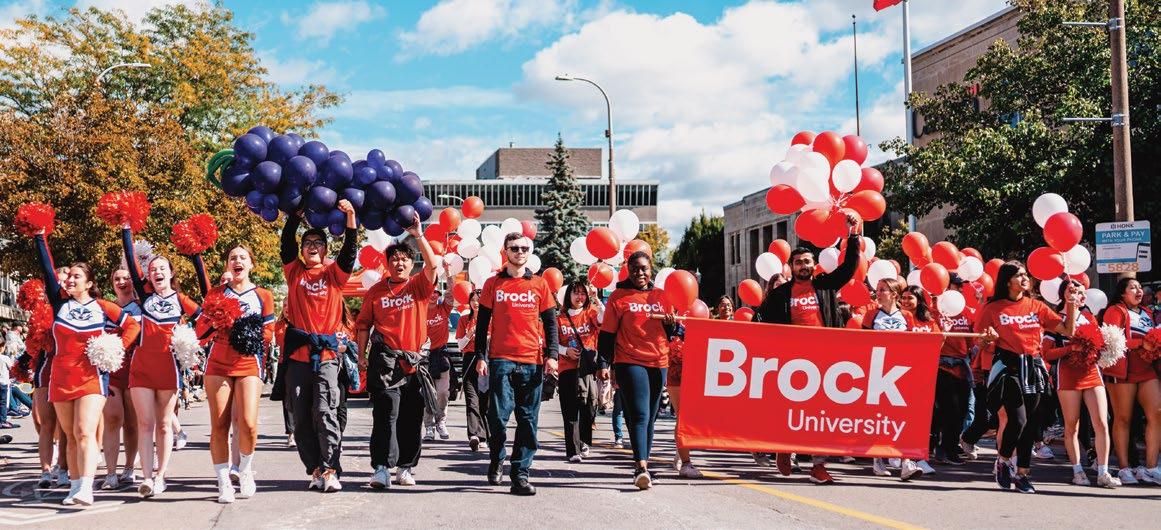
Inter-fund Transfers
Activity, including expenses and externally-funded revenue in the internally restricted funds, is recorded as part of the NFPS Financial Statements. For the purposes of the budget, the net change in these reserves are assumed to be negligible. However, the transfers to and from these funds are reported on a funding basis as they represent committed cash transactions. The budgeted inter-fund revenue of $12.51 million and inter-fund expenses of $29.88 million are eliminated as part of NFPS Financial Statements as they only represent internal movement of funds. Refer to pages 32 and 39 for explanations of these transfers.
91
($000s) 2023-24 Funding Budget NFPS adjustments Notes – see Figure 121 Eliminate inter-fund transfers Eliminate internal chargebacks 2023-24 NFPS budget Revenue Student fees 194,728 (787) 1-2 193,941 Grant revenue 105,254 (3,853) 3 101,401 Internal chargebacks 12,118 (12,118)Inter-fund revenue 12,510 (12,510)Research revenue 12,222 4 12,222 Other revenue 65,786 8,077 5-7 73,863 Total revenue 390,396 15,659 (12,510) (12,118) 381,427 Operating costs Personnel costs (254,880) (3,345) 4,10-12 (258,225) Inter-fund expense (29,879) (1,643) 4,6 31,522Other operating costs (109,625) (44,028) 1,4-6,8-10 12,118 (141,535) Total costs (394,384) (49,016) 31,522 12,118 (399,760) Funding surplus/ deficit (3,988) (33,357) 19,012 - (18,333) Figure 121 Notes Reconciliation of NFPS adjustments ($000s) 1 Course fee revenue 704 2 Student fees (for capital) (1,491) 3 Capital grants (3,853) 4 Research, including fellowships 12,222 5 Amortization of deferred capital contributions 10,150 6 Endowment and trust spending 4,681 7 Proceeds of asset sales (6,754) Total revenue adjustments 15,659 1 Course fee spending (704) 4 Research spending –personnel (3,243) 4 Research spending –operating costs (8,979) 5 Amortization of capital assets (33,211) 6 Endowment and trust spending (4,681) 8 Principal payments 2,908 9 Capital purchases in operating 1,640 10 Capital and infrastructure project reserves spending – personnel (357) 10 Capital and infrastructure project reserves spending – operating (2,644) 11 Post-retirement benefits (279) 12 Pension 534 Total costs adjustments (49,016)
Figure 120
2023-24 Budget Report APPENDICES
Appendix D
Tuition fee policy, governmentfunded programs
On March 2, 2023, the MCU released the 2023-24 tuition fee framework for domestic students in Ontario. The framework set out the following:
1. Continue the tuition fee freeze for domestic students at 2022-23 levels (applicable for all years of study).
2. Provide institutions the flexibility to increase tuition fees for domestic out-of-province students up to 5% (applicable for all years of study).
3. Subject to the submission of an application and ministry approval, tuition fee increases over a multiyear timeframe will be permitted for certain programs with lower-than-average tuition rates for comparable programs (applicable to firstyear incoming students starting 2023-24). Tuition adjustments for these programs are referred to as Tuition Anomalies.
Brock University will increase the tuition fees for undergraduate domestic out-of-province students by 5.0 per cent starting in the fall term; however, this increase will not be implemented for graduate students. As at the time of preparing this report, the University has submitted applications for tuition anomalies but has yet to receive ministry approval. The fee changes for the 2023-24 academic year are detailed in Figure 122.

Tuition fee policy, non-government-funded programs
International students in undergraduate and graduate programs and cost-recovery programs are not eligible for provincial government funding, and therefore universities are not governed by the government’s tuition policy in setting tuition rates for this student group. A differentiated approach is taken to account for demand after benchmarking to fees charged at other Ontario universities. Starting in 2022-23, a cohort model was introduced for undergraduate international tuition rates where each year, Year 1 students will see an eight per cent increase followed by rates frozen for four additional years. Figure 123 details the 2023-24 non-government-funded program rates that were proposed to and approved by the Board of Trustees in December 2022.
Intensive English Language Program (IELP) (online) 54.0%
Intensive English Language Program (IELP) (in person) 36.0%
92
Figure 122
Undergraduate Programs – out-ofprovince students (all applicable years) Up to 5.0% Undergraduate Programs – remaining 0.0% Graduate Programs – out-of-province students (all applicable years) Up to 5.0% Graduate Programs – remaining 0.0% Tuition anomalies Subject to ministry approval Brock University Board-approved 2023-24 rates Undergraduate Programs – out-ofprovince students (all applicable years)(1) 5.0% Undergraduate Programs – remaining 0.0% Graduate Programs 0.0% Tuition anomalies (1) Subject to ministry approval
domestic out-of-province increase and tuition anomalies will be
the Board of Trustees
part
May 2023 board meeting.
MCU tuition guidelines
(1) The
presented to
as
of the
International program types Tuition increase Undergraduate international students – years 1, 6
Other
Figure 123: Brock University board approved 2023-24 rate increases
and above 8.0% Undergraduate international students – years 2-5 0.0% Graduate international students (Research programs) 0% Graduate international students (Professional programs) 5.0% International student programs (ISPs) 5.0%
programs
Continuing Teacher Education – Additional Qualification courses (AQ) 0.7%
2023-24 Budget Report APPENDICES
Appendix E


Multi-year financial results on a funding basis
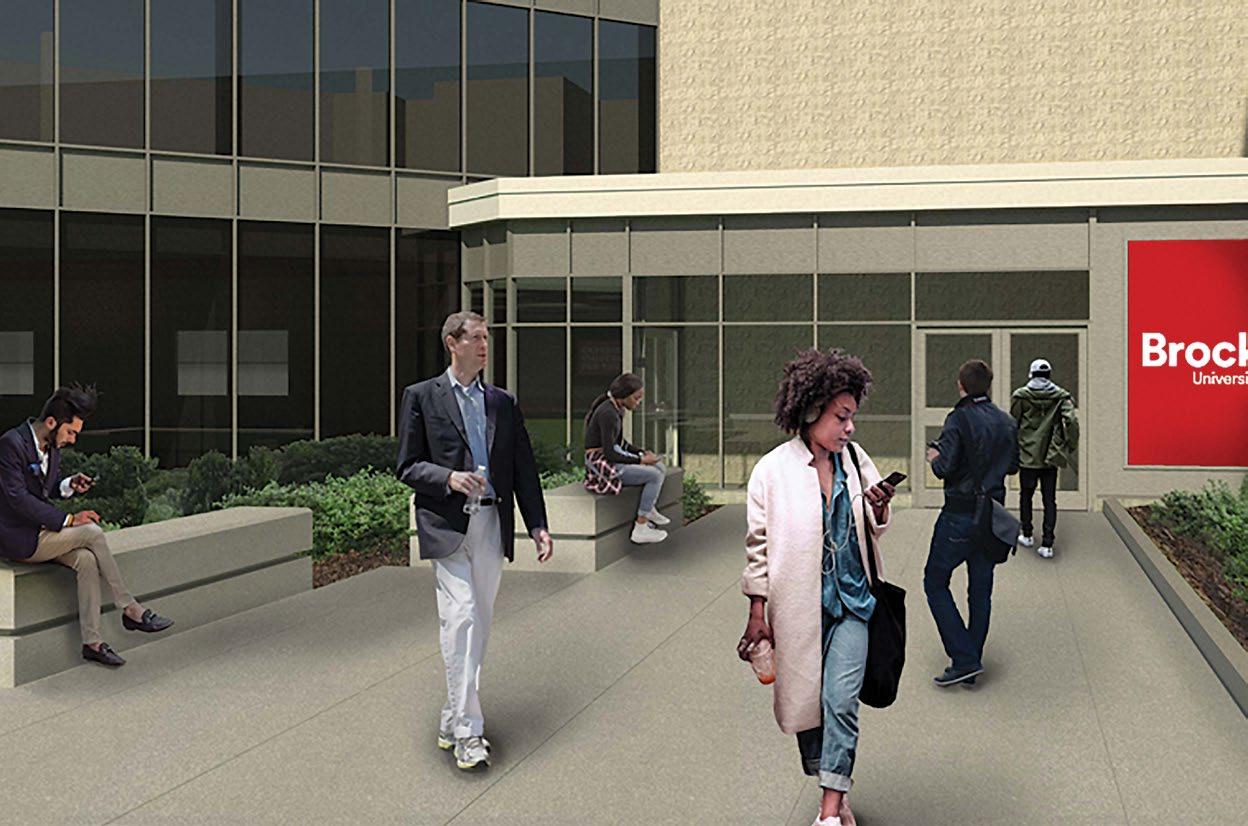
93
124 ($000s) 2020-21 Actual 2021-22 Actual 2022-23 Budget 2022-23 Forecast 2023-24 Budget Revenue Student fees 186,012 188,064 204,268 187,748 194,728 Grant revenue 106,724 99,780 99,589 101,919 105,254 Internal chargebacks 3,098 7,346 11,980 11,663 12,118 Inter-fund revenue 8,843 5,943 12,127 8,507 12,510 Other revenue 24,319 50,256 62,176 57,074 65,786 Total revenue 328,996 351,389 390,140 366,911 390,396 Operating costs Personnel costs (214,657) (221,304) (246,262) (234,056) (254,880) Inter-fund expenses (18,143) (28,926) (32,705) (25,584) (29,879) Other operating costs (83,302) (97,262) (114,176) (107,585) (109,625) Total operating costs (316,102) (347,492) (393,143) (367,225) (394,384) Mitigation target 3,003 314 3,988 Funding surplus/(deficit) 12,894 3,897 - -2023-24 Budget Report APPENDICES
Figure
Rendering of the new entrance on the south side of the new Goodman Gateway connecting the Goodman School of Business to Mackenzie Chown Complex A Block.
Appendix F
Financial health metrics definitions
Figure 125
Metric Definition Formula
Primary reserve ratio
The primary reserve ratio compares expendable net assets to total expenses and provides an indication of an institution’s financial strength and flexibility by determining how long the institution could function using its expendable reserves without relying on additional net assets generated by operations.
Expendable Net Assets include unrestricted surplus (deficit), internally restricted net assets, and internally restricted endowments, adjusted for the non-cash component of employee future benefits.
Debt burden ratio (Non-cash basis)
Interest burden %
The debt burden ratio measures how an institution utilizes a greater portion of its annual expenditures to fund debt obligations. The ratio is calculated by dividing total current debt obligations, which include interest expenses and principal payments, by operating expenses.
The Interest burden ratio compares the level of current debt service with the institution's total expenses. It is an indicator of debt affordability, as it examines the percentage of total expenses used to cover an institution’s cost of servicing its debt. The ratio is calculated as interest expense over total expenses (adjusted for amortization of capital assets).
Interest coverage ratio
Interest coverage ratio measures how many times an institution could pay its current interest payment with its available earnings. The ratio is calculated by dividing earnings before interest, depreciation and amortization (EBIDA) during a given period by the amount an institution must pay in interest on its debts during the same period.
Viability ratio The viability ratio is a basic determinant of an institution’s financial health, as it provides an indication of the funds on hand to settle its long-term obligations. It is calculated as expendable net assets over long-term debt.
Expendable net assets include unrestricted surplus (deficit), internally restricted net assets and internally restricted endowments, adjusted for the non-cash component of employee future benefits.
Long-term debt is total external long-term debt as disclosed in the institution’s financial statements without adding the current portion that may be included in accounts payable.
Net operating revenues ratio
The net operating revenues ratio provides an indication of the extent to which institutions are generating positive cash flows in the long run to be financially sustainable. The ratio is calculated as cash flow from operating activities over total revenues.
Primary reserve ratio = expendable net assets/ total expenses
Debt burden ratio = (interest expense + principal payments)/ total expenses
Interest burden ratio = interest expense/ (total expenses –amortization)
Interest coverage ratio = EBIDA/interest expense
Viability ratio = expendable net assets/ long-term debt
Net operating revenues ratio = cash flow from operating activities/total revenues
94
2023-24 Budget Report APPENDICES
Strategic Priorities
Brock University Niagara Region 1812 Sir Isaac Brock Way St. Catharines, ON L2S 3A1 Canada 905 688 5550 budgetreport@brocku.ca brocku.ca/finance Student Experience Community Engagement Inclusivity Research

































































































































